
Class 7 Maths NCERT Exemplar Solutions Chapter 6 Triangles
Free PDF download of NCERT Exemplar for Class 7 Maths Chapter - 6 Triangles solved by expert Maths teachers on Vedantu.com as per NCERT (CBSE) Book guidelines. All Chapter - 6 Triangles exercise questions with solutions to help you to revise the complete syllabus and score more marks in your examinations.
You can also Download NCERT Solutions for Class 7 Maths to help you to revise the complete Syllabus and score more marks in your examinations.
Students in seventh grade are required to completely comprehend and interpret a variety of Math topics based on computing numbers, equations, geometry, functions, and expressions. To master such a wide variety of subjects, continuous repetition and reinforcement of concepts using dependable study materials such as Math worksheets are required. NCERT Exemplar Solution is an extremely effective technique for children to study Math engaging and gradually grasp numerous ideas. You can easily locate some of these educational materials at Vedantu.
Access NCERT Exemplar Solutions for Class 7 Mathematics Chapter 6 - Triangles (Examples, Easy Methods and Step by Step Solutions)
Solved Examples:
1. In the given figure, the side $Q R$ of a $\triangle PQR$ has been produced to the point $S$. If $\angle P R S=$ $115^{\circ}$ and $\angle P=45^{\circ}$, then $\angle Q$ is equal to,
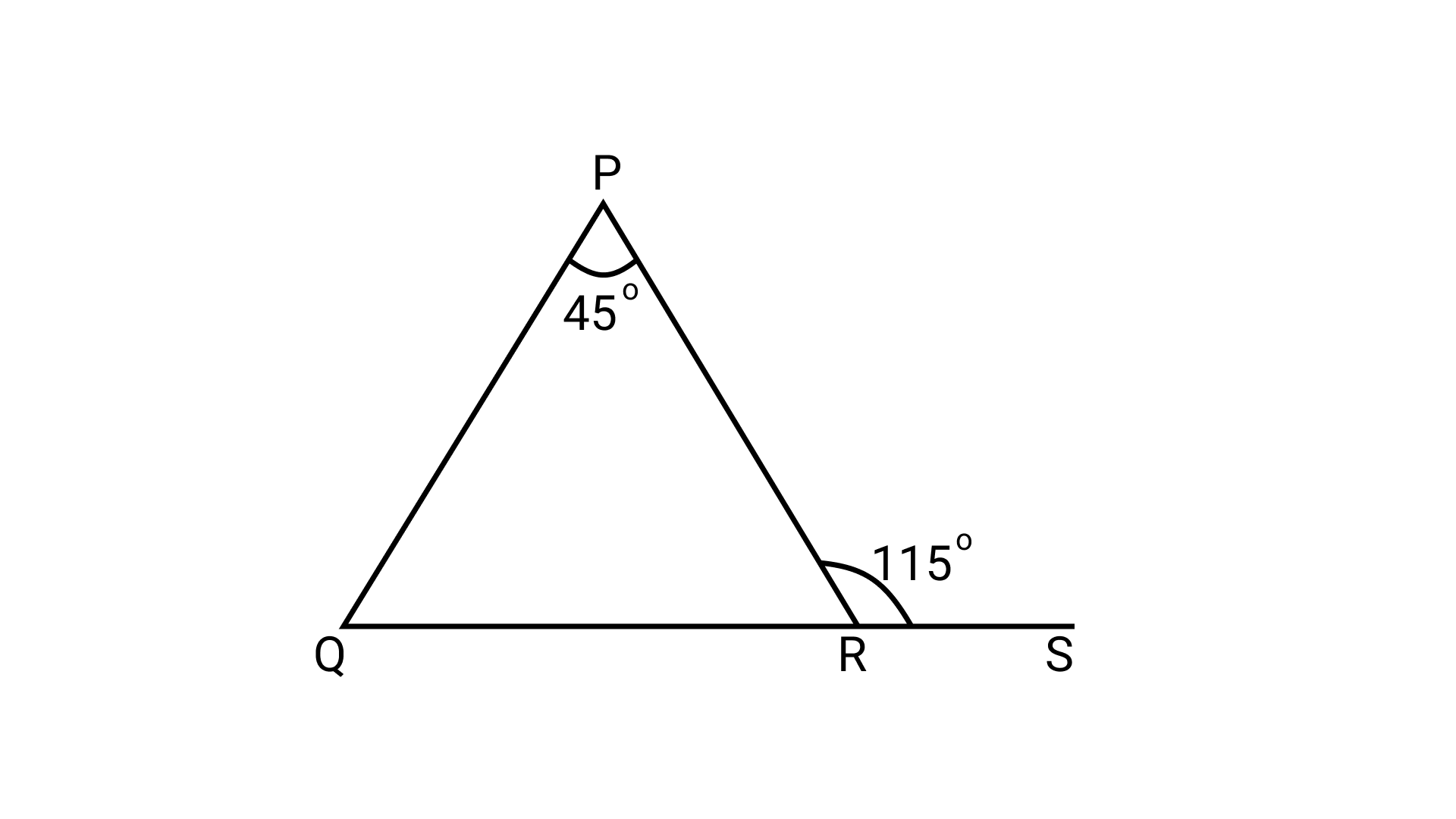
(a) $70^{\circ}$
(b) $105^{\circ}$
(c) $51^{\circ}$
(d) $80^{\circ}$
Ans: Correct answer is (a).
$\angle \mathrm{PRS}=\angle \mathrm{RPQ}+\angle \mathrm{PQR}$ (By exterior angle property)
$\Rightarrow 115^{\circ}=45^{\circ}+\angle P Q R$
$\Rightarrow \angle \mathrm{PQR}=115^{\circ}-45^{\circ}$ $\Rightarrow \angle \mathrm{PQR}=70^{\circ}$
2. In an equilateral triangle ABC (in the given figure), AD is an altitude. Then 4AD2 is equal to
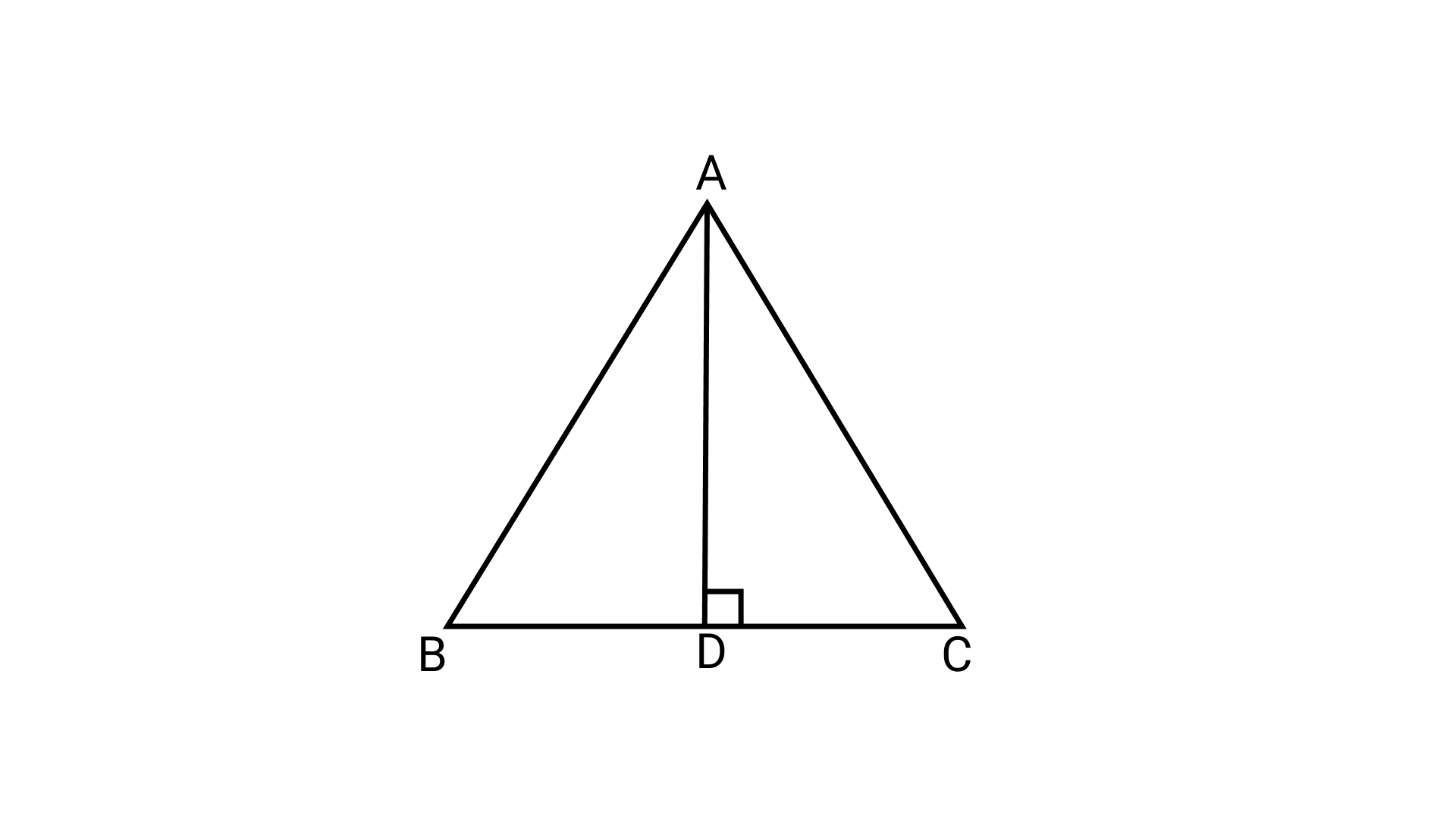
(a) $2 \mathrm{BD}^{2}$
(b) $\mathrm{BC}^{2}$
(c) $3 \mathrm{AB}^{2}$
(d) $2 \mathrm{DC}^{2}$
Ans: Correct answer is (c).
Given AB = BC = AC
AD is the altitude.
$BD=CD=\dfrac{{AB}}{2}$(in an equivalent triangle AD bisects BC)
Using Pythagoras theorem,
$A{C^2} = A{D^2} + C{D^2}$
$\Rightarrow A{B^2} = A{D^2} + {\left( {\dfrac{{AB}}{2}} \right)^2}$
$\Rightarrow A{D^2} = A{B^2} - \dfrac{{A{B^2}}}{4}$
$\Rightarrow A{D^2} = \dfrac{{3A{B^2}}}{4}$
$\Rightarrow 4A{D^2} = 3A{B^2}$
3. Which of the following cannot be the sides of a triangle?
(a) 3 cm, 4 cm, 5 cm
(b) 2 cm, 4 cm, 6 cm
(c) 2.5 cm, 3.5 cm, 4.5 cm
(d) 2.3 cm, 6.4 cm, 5.2 cm
Ans: Correct answer is (b).
It is known that the sum of any two sides of a triangle is always greater than the third side.
In option (b), 2 cm + 4 cm = 6 cm which is equal to 6 cm not greater than 6 cm.
So, sides given in option (b) can not be the sides of a triangle.
4. Which one of the following is not a criterion for congruence of two triangles?
(a) ASA
(b) SSA
(c) SAS
(d) SSS
Ans: Correct answer is (b).
There is no SSA criterion for congruence of two triangles.
5. In the given figure, PS is the bisector of $\angle$P and PQ = PR. Then ∆PRS and ∆PQS are congruent by the criterion
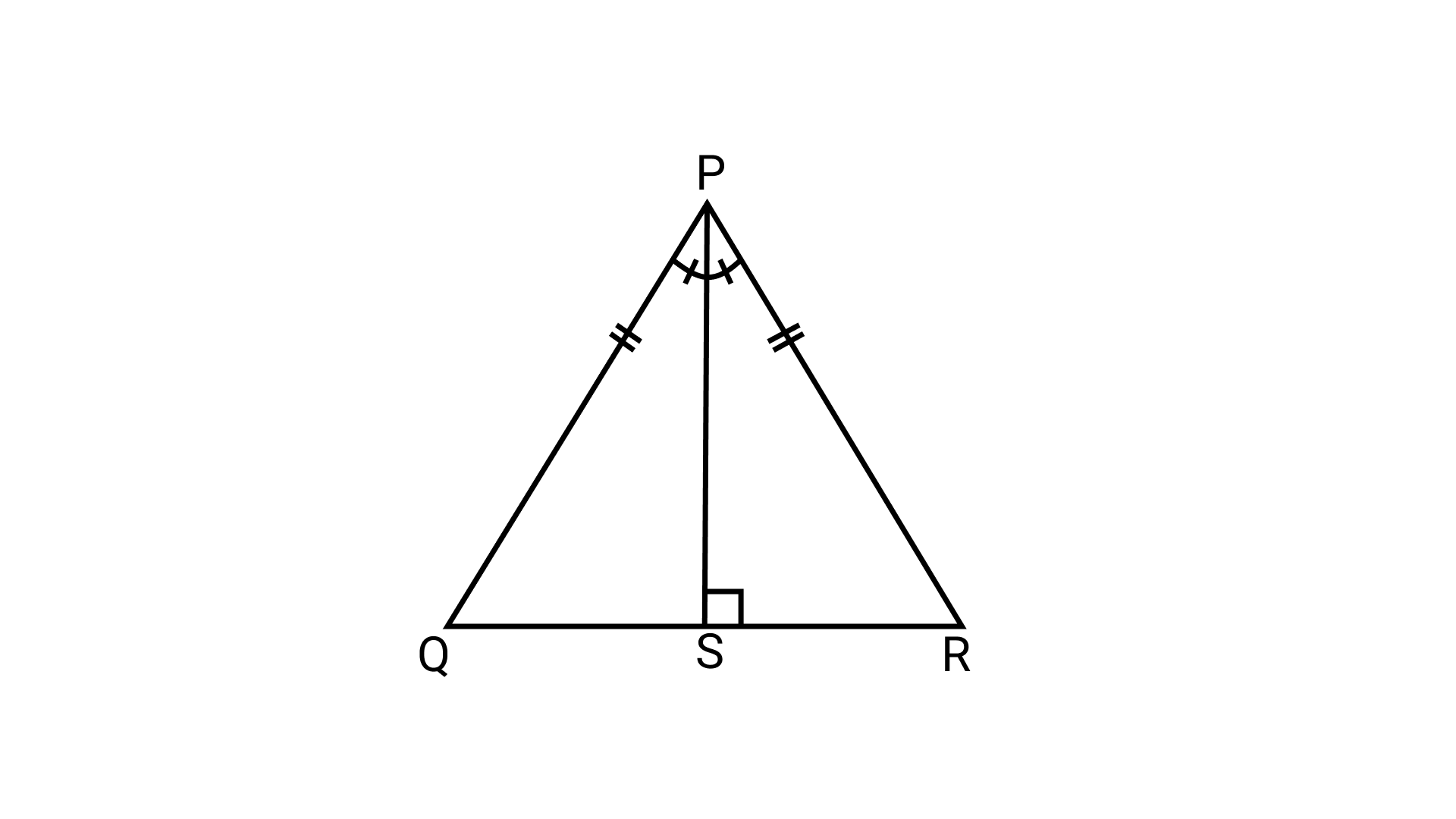
(a) AAA
(b) SAS
(c) ASA
(d) both (b) and (c)
Ans: Correct answer is (b).
PS = PS (common)
$\angle$QPS = $\angle$RPS (Given)
PQ = PR (Given)
So, ∆PRS ≅ ∆PQS (By SAS criterion)
In questions 6 to 9, fill in the blanks to make the statements true.
6. The line segment joining a vertex of a triangle to the mid-point of its opposite side is called its .
Ans: median
7: A triangle is said to be __________, if each one of its sides has the same length.
Ans: equilateral
8: In the given figure, $\angle$ PRS = $\angle$ QPR + $\angle$_______.
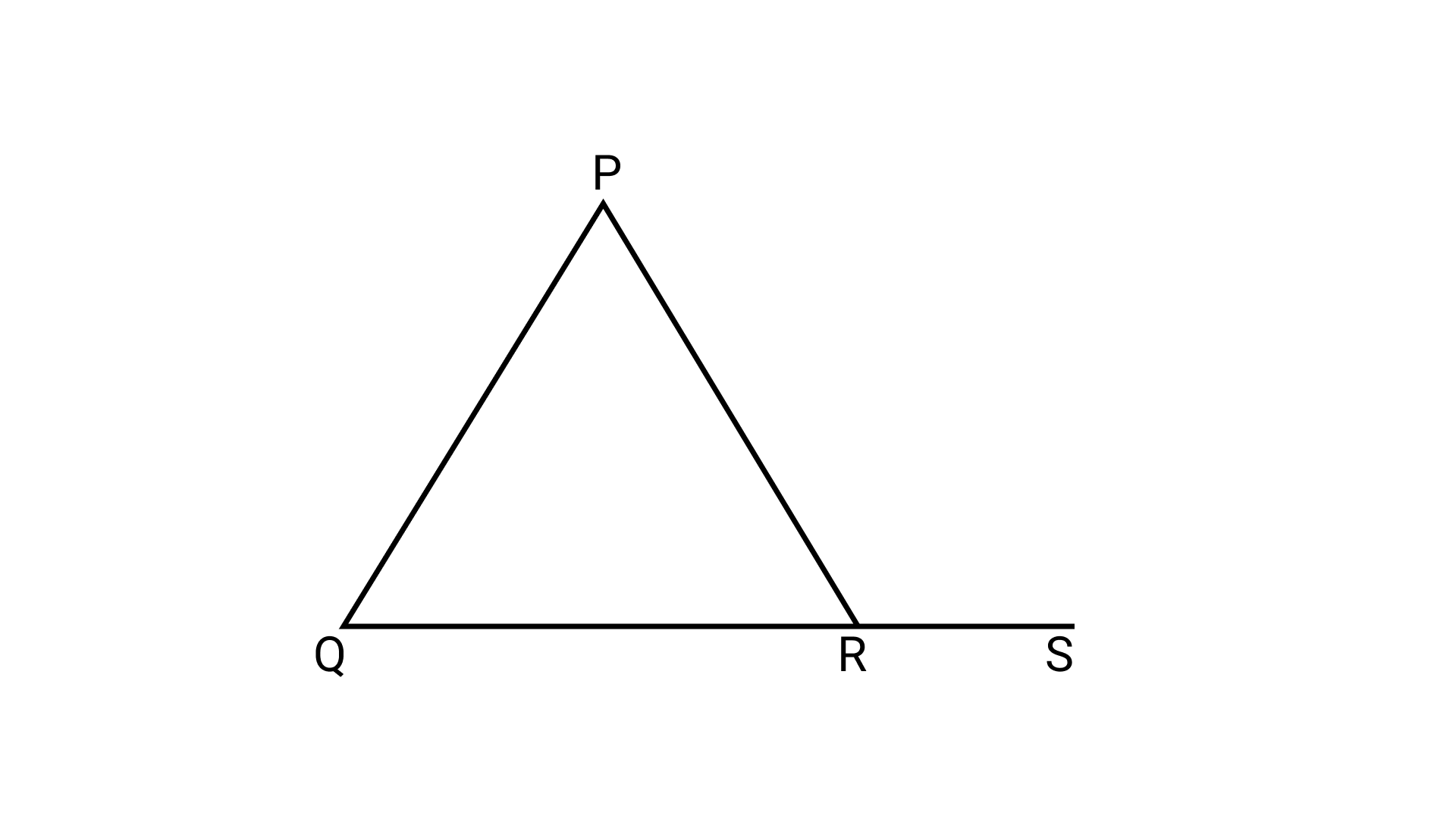
Ans: ∆PQR
By exterior angle property,
$\angle$PRS = $\angle$RPQ + $\angle$PQR
9. Let $A B C$ and $D E F$ be two triangles in which $A B=D E, B C=F D$ and $C A=E F$. The two triangles are congruent under the correspondence $A B C \leftrightarrow$
Ans: $E D F$
Since $A B=D E, B C=F D$ and $C A=E F$,
$\Rightarrow A B C \leftrightarrow E D F$.
In questions 10 to 12, state whether the statements are True or False.
10. Sum of any two sides of a triangle is not less than the third side.
Ans: False
11. The measure of any exterior angle of a triangle is equal to the sum of the measures of its two interior opposite angles.
Ans: True
12. If in ∆ABC and ∆DEF, AB = DE, $\angle$A = $\angle$D and BC = EF then the two triangle ABC and DEF are congruent by SAS criterion.
Ans: False
For triangle to be congruent SAS criterion, it is needed to have two equal sides and the included angle same.
In ΔABC and ΔDFE,
It is given that AB = DE, $\angle$A = $\angle$D, BC = EF
But $\angle$A is formed by the two sides AB and AC of ΔABC and $\angle$D is formed by the two sides DE and EF of $\triangle$ DFE.
So, we need AC = DF for the two triangles to be congruent.
13. In the given figure, find x and y.
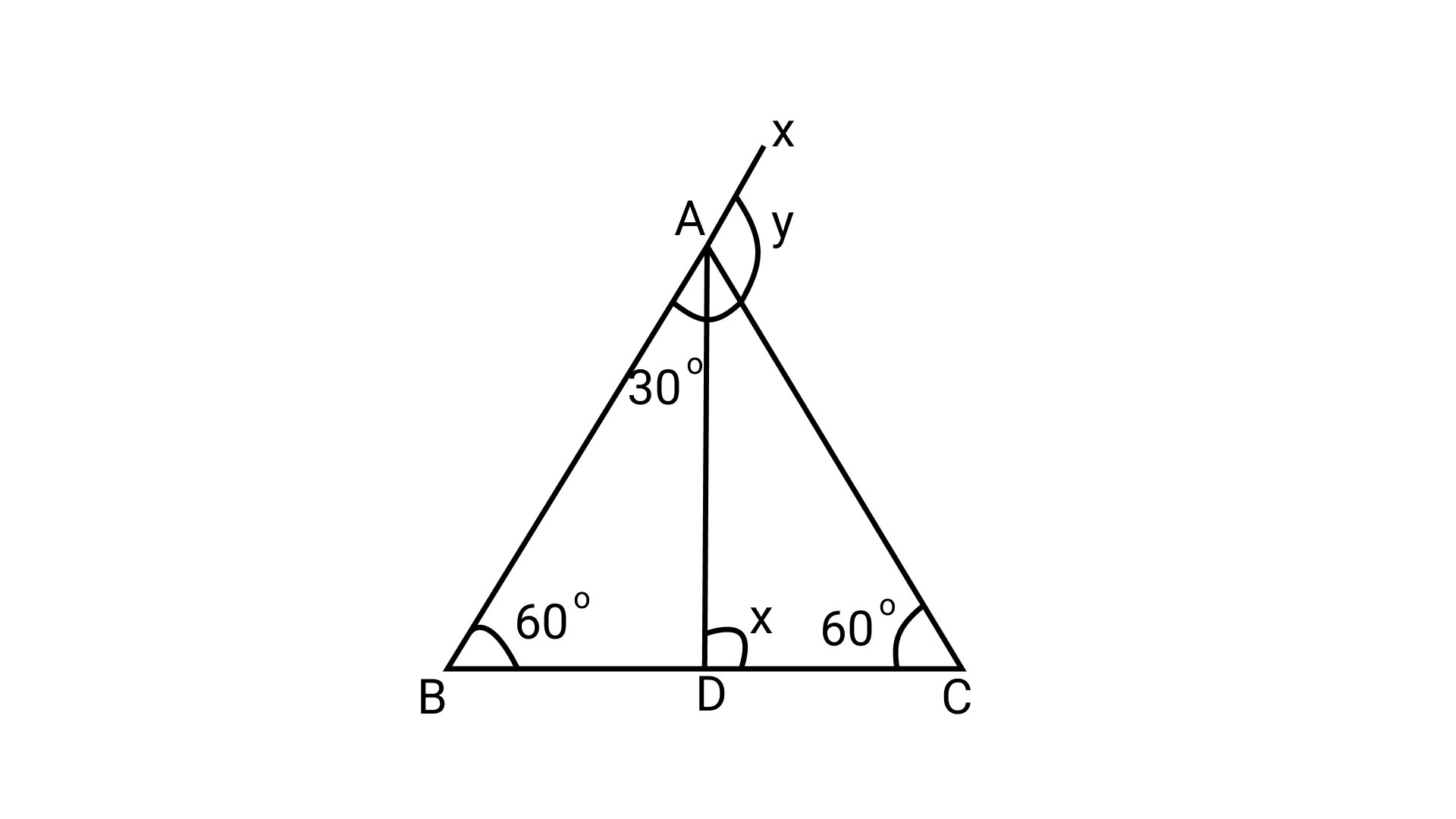
Ans: $\angle$XAC = $\angle$ABD + $\angle$ACB (By exterior angle property)
$y=60^{\circ}+45^{\circ}$ $y=105^{\circ} \ldots \ldots(i)$ In $\triangle A B D$
$\angle$ABD + $\angle$BDA + $\angle$DAB = $x=180^{\circ}$ (By angle sum property)
$x=60^{\circ}$ + BDA + $x=30^{\circ}$ = $x=180^{\circ}$
$\angle$BDA = $x=180^{\circ}$ - $x=60^{\circ}$ - $x=30^{\circ}$
$\angle$BDA = $x=90^{\circ}$
Since BDC is a straight line, $\angle$BDA + x = $x=180^{\circ}$
$90^{\circ}+x=180^{\circ}$
$x=90^{\circ}$
Exercise
1. The sides of a triangle have lengths (in cm) 10, 6.5 and a, where a is a whole number. The minimum value that a can take is
(a) 6
(b) 5
(c) 3
(d) 4
Ans: Option (d) is correct.
As we know, the sum of the length of any two sides of a triangle is always more than the length of the third side.
So
$6.5 + a > 10$
$a > 10 - 6.5$
$a > 3.4$
The minimum value of a whole number for $a$ is 4 which is greater than 3.5.
Therefore, $a = 4$.
2. Triangle DEF of the given figure is a right triangle with $\angle E=90^{\circ}$.
What type of angles are $\angle D$ and $\angle F$ ?
(a) They are equal angles
(b) They form a pair of adjacent angles
(c) They are complementary angles
(d) They are supplementary angles
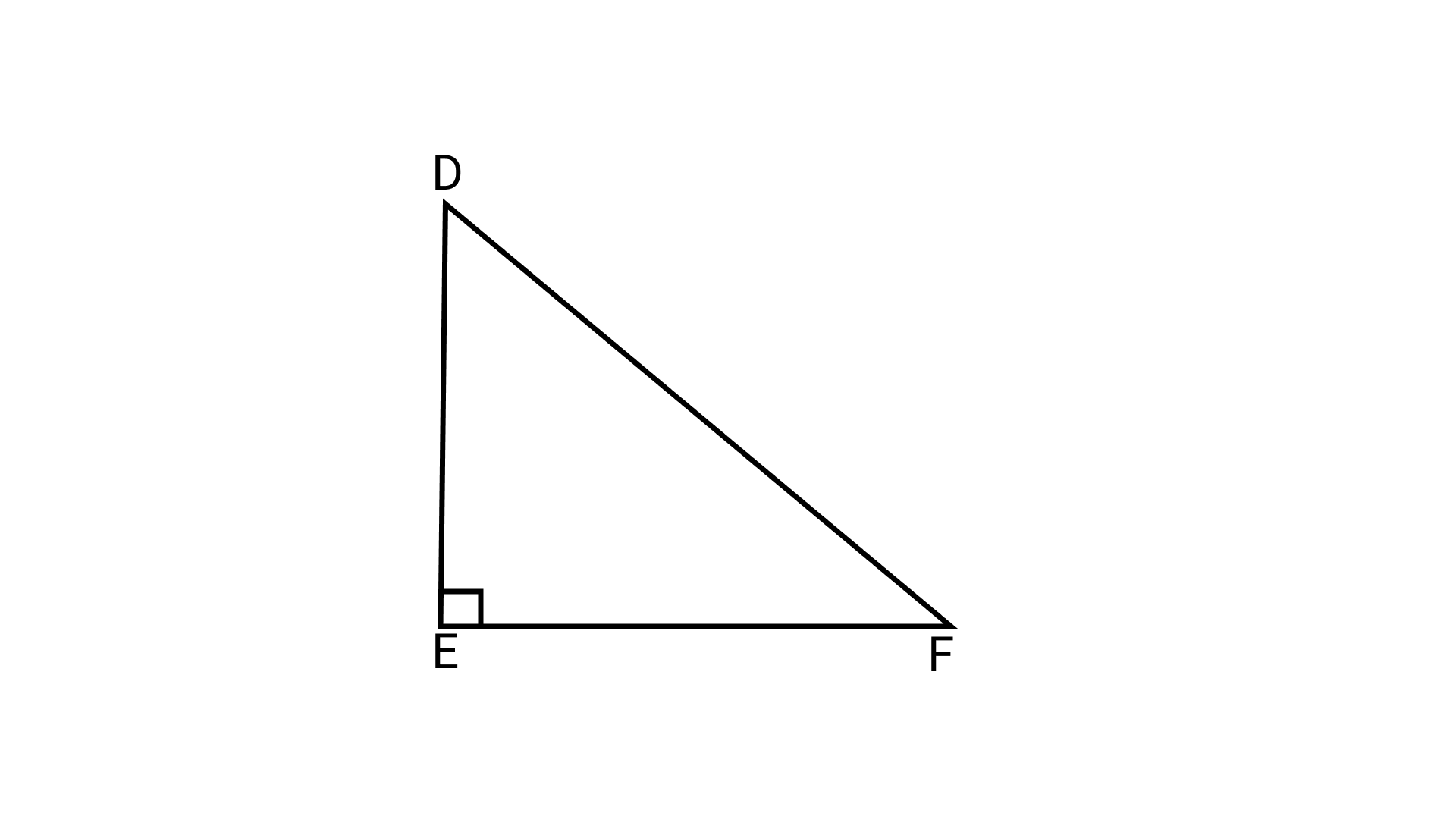
Ans: Option (c) is correct.
By angle sum property of a triangle,
\[\angle D{\text{ }} + \angle E{\text{ }} + \angle F{\text{ }} = {\text{ }}180^\circ \]
Now since $\angle$ E = $90^\circ$ (given)
$\Rightarrow \angle D{\text{ }} + \angle F{\text{ }} = {\text{ }}180^\circ - {\text{ }}90^\circ \;$
$= {\text{ }}90^\circ$
Therefore, $\angle$ D and $\angle$ F are complementary angles.
3. In the given figure, PQ = PS. The value of x is
(a) $35^\circ$
(b) $45^\circ$
(c) $55^\circ$
(d) $70^\circ$
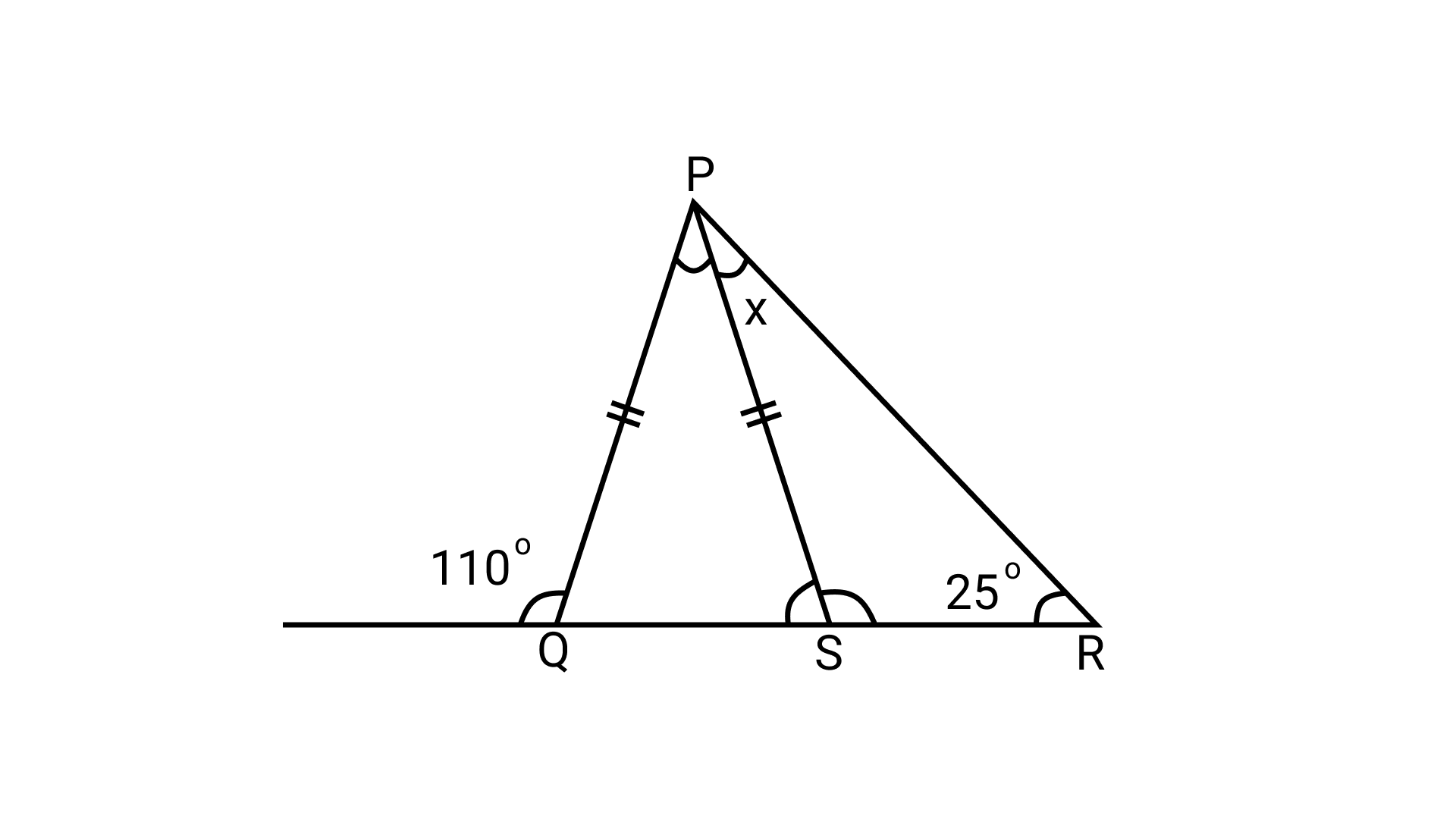
Ans: Option (b) is correct.In △PQS,
\[\angle 2{\text{ }} + \angle 3{\text{ }} = {\text{ }}110^\circ \ldots \ldots \left( {\text{i}} \right)\](Exterior angle property of a triangle)\[\angle 2{\text{ }} + \angle 3{\text{ }} + \angle 4{\text{ }} = {\text{ }}180^\circ \] (Angle sum property of a triangle)
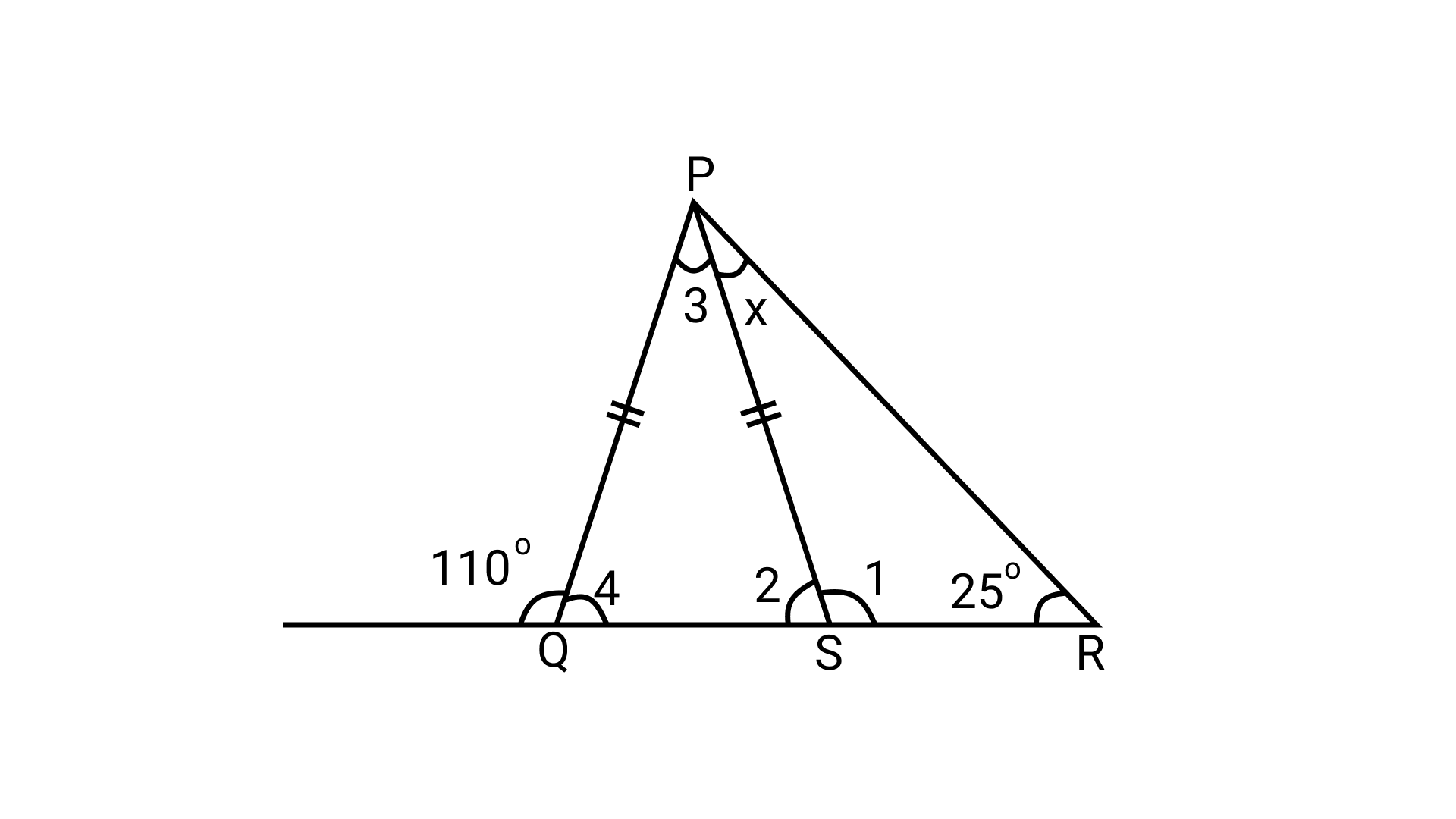
\[\Rightarrow \angle 4{\text{ }} = {\text{ }}180^\circ - 110^\circ \] (Using equation (i))
\[\Rightarrow \angle 4{\text{ }} = {\text{ }}70^\circ \]
Now, PQ = PS (given)
\[\Rightarrow \angle 2{\text{ }} = \angle 4{\text{ }} = {\text{ }}70^\circ {\text{ }} \ldots \ldots \left( {{\text{ii}}} \right)\]
Now, in $\triangle$PRS,
\[\angle 2{\text{ }} = {\text{ }}x{\text{ }} + {\text{ }}25^\circ \] (Exterior angle property of a triangle)
\[\Rightarrow x{\text{ }} = {\text{ }}70^\circ -25^\circ \]
\[\Rightarrow x{\text{ }} = {\text{ }}45^\circ \] (Using equation (ii))
4. In a right-angled triangle, the angles other than the right angle are
(a) obtuse
(b) right
(c) acute
(d) straight
Ans: Option (c) is correct.
The sum of angles other than right angle in a right-angled triangle is $90^\circ$
Therefore, both angles other than the right angle must be acute.
5. In an isosceles triangle, one angle is $70^\circ$. The other two angles are of
(i) $55^\circ$ and $55^\circ$
(ii) $70^\circ$ and $40^\circ$
(iii) any measure
In the given option(s) which of the above statement(s) are true?
(a) (i) only
(b) (ii) only
(c) (iii) only
(d) (i) and (ii)
Ans: Option (d) is correct.
Case 1:
Let $\triangle$ABC be the given isosceles triangle in which AB = AC and vertex angle is $70^\circ$.
\[\angle 1{\text{ }} = \angle 2 \ldots \ldots {\text{ }}\left( {\text{i}} \right){\text{ }}[\because {\text{AB = AC}}]\]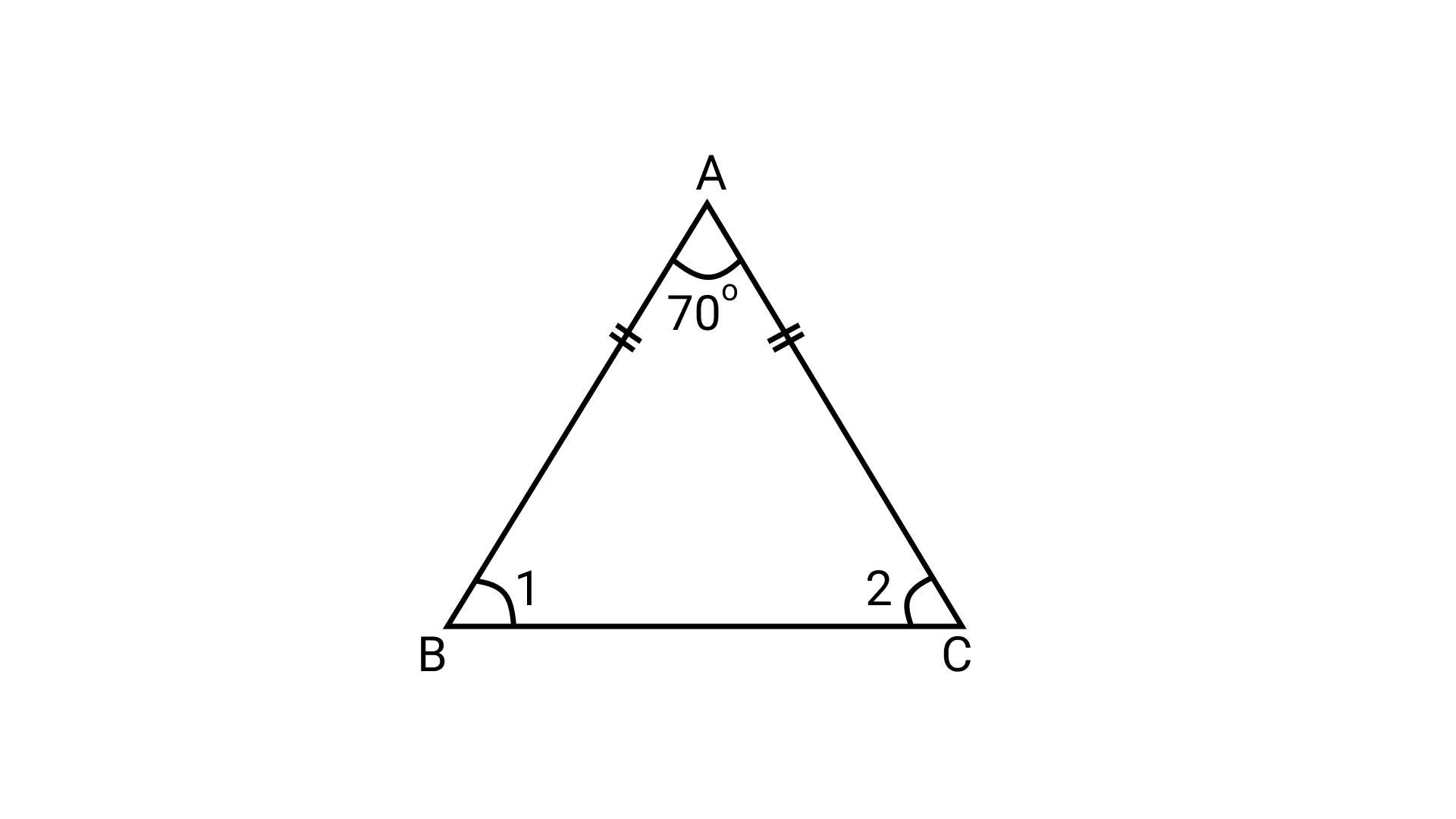
$\angle 1{\text{ }} + \angle 2{\text{ }} + \angle {\text{A }} = {\text{ }}180^\circ \left( {{\text{Angle sum property}}} \right)$
$\Rightarrow 2(\angle 1){\text{ }} = {\text{ }}180^\circ -70^\circ \left( {{\text{Using }}\left( {\text{i}} \right)} \right)$
$\Rightarrow \angle 1 = \frac{{110^\circ }}{2}$
$\Rightarrow \angle 1 = 55^\circ$
Thus,
\[\angle 1{\text{ }} = \angle 2{\text{ }} = {\text{ }}55^\circ \]
Hence, (i) is true.
Case 2:
Let $\triangle$ABC be the given isosceles triangle in which AB = AC and base angle is $70^\circ$.
\[\angle 2{\text{ }} = {\text{ }}70^\circ [\because {\text{AB = AC}}]\]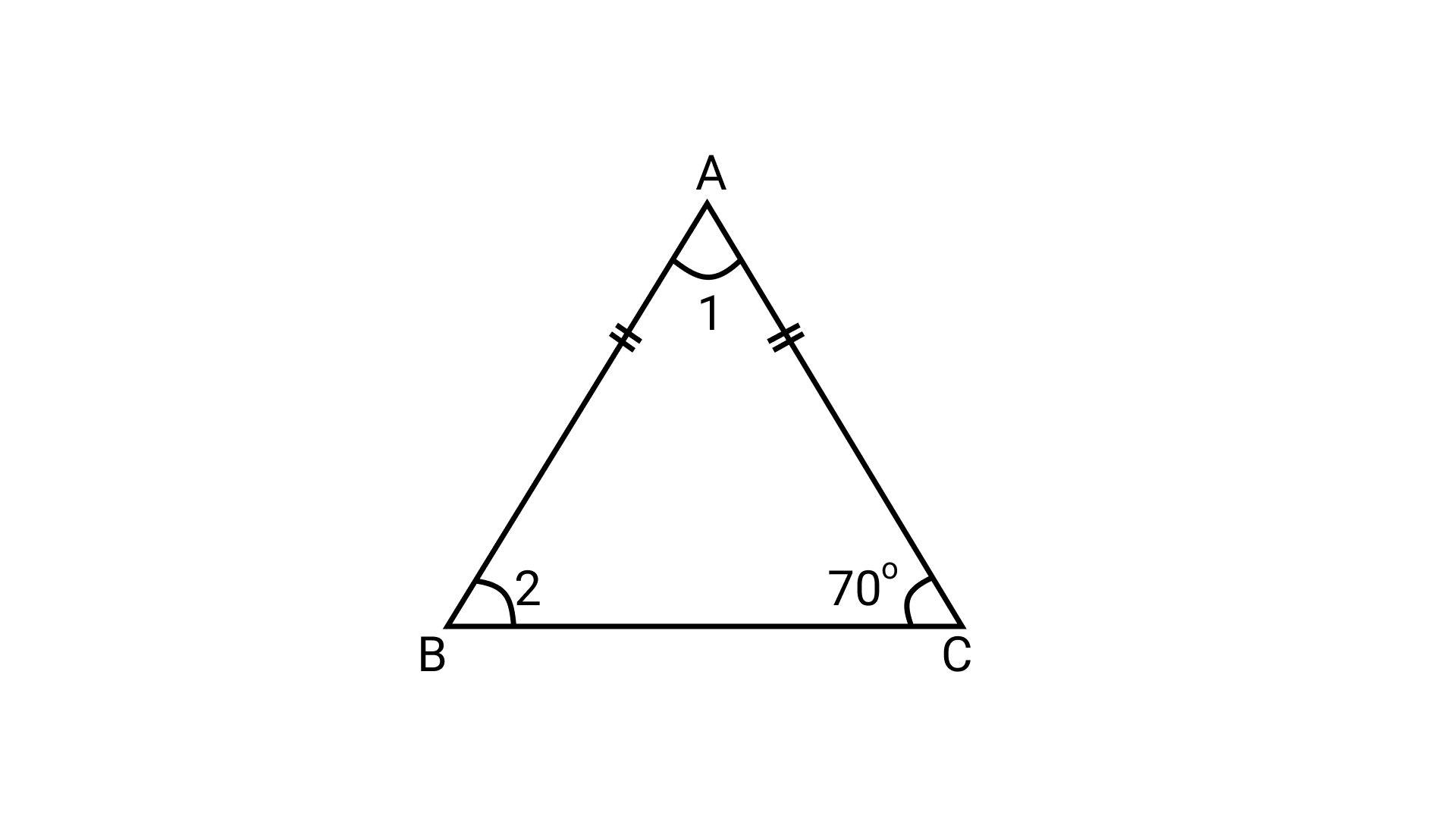
Now,
$\angle 1{\text{ }} + \angle 2{\text{ }} + \angle C{\text{ }} = {\text{ }}180^\circ$
$\Rightarrow \angle 1{\text{ }} = {\text{ }}180^\circ -70^\circ -70^\circ$
$\Rightarrow \angle 1{\text{ }} = {\text{ }}40^\circ$
Thus,
\[\angle 1 = {\text{ }}40^\circ \]and \[\angle 2{\text{ }} = {\text{ }}70^\circ \]
Hence, (ii) is also true.
6. In a triangle, one angle is of $90^\circ$. Then
(i) The other two angles are of $45^\circ$ each
(ii) In the remaining two angles, one angle is $90^\circ$ and the other is $45^\circ$
(iii) Remaining two angles are complementary
In the given option(s) which is true?
(a) (i) only
(b) (ii) only
(c) (iii) only
(d) (i) and (ii)
Ans: Option (c) is correct.
In a triangle, if one angle is of $90^\circ$, the remaining two angles are complementary.
7. Lengths of sides of a triangle are 3 cm, 4 cm and 5 cm. The triangle is
(a) Obtuse-angled triangle
(b) Acute-angled triangle
(c) Right-angled triangle
(d) An isosceles right triangle
Ans: Option (c) is correct.
Lengths of sides of a triangle are 3 cm, 4 cm and 5 cm.
Now,
$\Rightarrow {5^2} = {3^2} + {4^2}$
$\Rightarrow 25 = 9 + 16$
$\Rightarrow 25 = 25$
Here, the sum of squares of two sides is equal to the square of the third side.
Therefore, a triangle is a right-angled triangle.
8. In the given figure, PB = PD. The value of x is
(a) 85°
(b) $90^\circ$
(c) $25^\circ$
(d) $35^\circ$
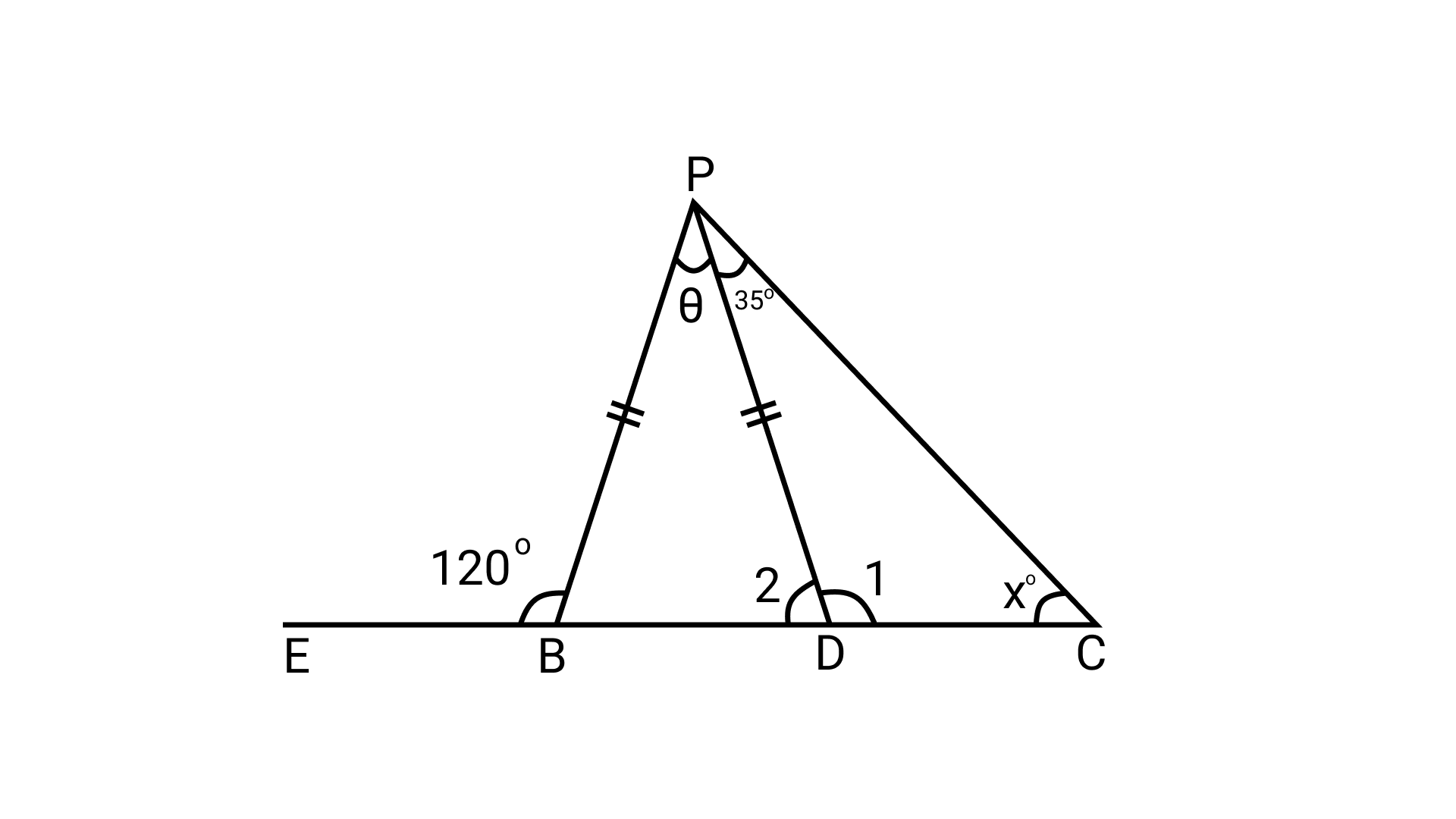
Ans: Option (c) is correct.
\[\angle PBE{\text{ }} = \angle PDB{\text{ }} + \angle BPD\] (Exterior angle property)
\[\Rightarrow 120^\circ = \angle PDB{\text{ }} + \theta \ldots \ldots {\text{ }}\left( {\text{i}} \right)\]
Now, in $\triangle$PBD,
\[\angle PBD{\text{ }} + \angle BPD{\text{ }} + \angle PDB{\text{ }} = {\text{ }}180^\circ \] (Angle sum property)
$\Rightarrow \angle PBD{\text{ }} + \theta + \angle PDB{\text{ }} = {\text{ }}180^\circ$
$\Rightarrow \angle PBD{\text{ }} = {\text{ }}180^\circ -120^\circ \left[ {{\text{Using }}\left( {\text{i}} \right)} \right]$
$= {\text{ }}60^\circ$
And PB = PD (given)
\[\because \angle PDB{\text{ }} = \angle PBD{\text{ }} = {\text{ }}60^\circ \ldots \ldots \ldots .{\text{ }}\left( {{\text{ii}}} \right)\]
Now, in $\triangle$PDC,
\[\angle PDB{\text{ }} = \angle DCP{\text{ }} + \angle DPC\] (Exterior angle property)
$\Rightarrow 60^\circ = {\text{ }}x{\text{ }} + {\text{ }}35^\circ \left[ {{\text{Using }}\left( {{\text{ii}}} \right)} \right][\because \angle DCP{\text{ }} = {\text{ }}x,\angle DPC{\text{ }} = {\text{ }}35^\circ \left( {{\text{given}}} \right)]$
$\Rightarrow x{\text{ }} = {\text{ }}60^\circ -35^\circ$
$\Rightarrow x{\text{ }} = {\text{ }}25^\circ$
9. In $\triangle$PQR,
(a) PQ – QR > PR
(b) PQ + QR < PR
(c) PQ – QR < PR
(d) PQ + PR < QR
Ans: Option (c) is correct.
\[\because \] Sum of any two sides of a triangle is greater than the third side.
In a $\triangle$PQR,
${\Rightarrow PQ{\text{ }} + QR{\text{ }} > PR}$
${\Rightarrow QR{\text{ }} + {\text{ }}PR{\text{ }} > {\text{ }}PQ} $
$\Rightarrow PR{\text{ }} + {\text{ }}PQ{\text{ }} > {\text{ }}QR$
And
\[\because \] Difference of any two sides of a triangle is less than the third side
$\Rightarrow PQ-QR{\text{ }} < {\text{ }}PR$
$\Rightarrow QR-PR{\text{ }} < {\text{ }}PQ$
$\Rightarrow PR-PQ{\text{ }} < {\text{ }}QR$
10. In $\triangle \mathrm{ABC}$,
(a) AB + BC > AC
(b) AB +BC < AC
(c) AB + AC < BC
(d) AC + BC < AB
Ans: Option (a) is correct.
\[\because \] Sum of any two sides of a triangle is greater than the third side.
In a $\triangle \mathrm{ABC}$,
$\Rightarrow AB{\text{ }} + {\text{ }}BC{\text{ }} > {\text{ }}AC$
$\Rightarrow BC{\text{ }} + {\text{ }}AC{\text{ }} > {\text{ }}AB$
$\Rightarrow AC{\text{ }} + {\text{ }}AB{\text{ }} > {\text{ }}BC$
11. The top of a broken tree touches the ground at a distance of 12 m from its base. If the tree is broken at a height of 5 m from the ground then the actual height of the tree is:
(a) 25 m
(b) 13 m
(c) 18 m
(d) 17 m
Ans: Option (c) is correct.
Let BC is the broken part of the tree and AB is the unbroken part of the tree.
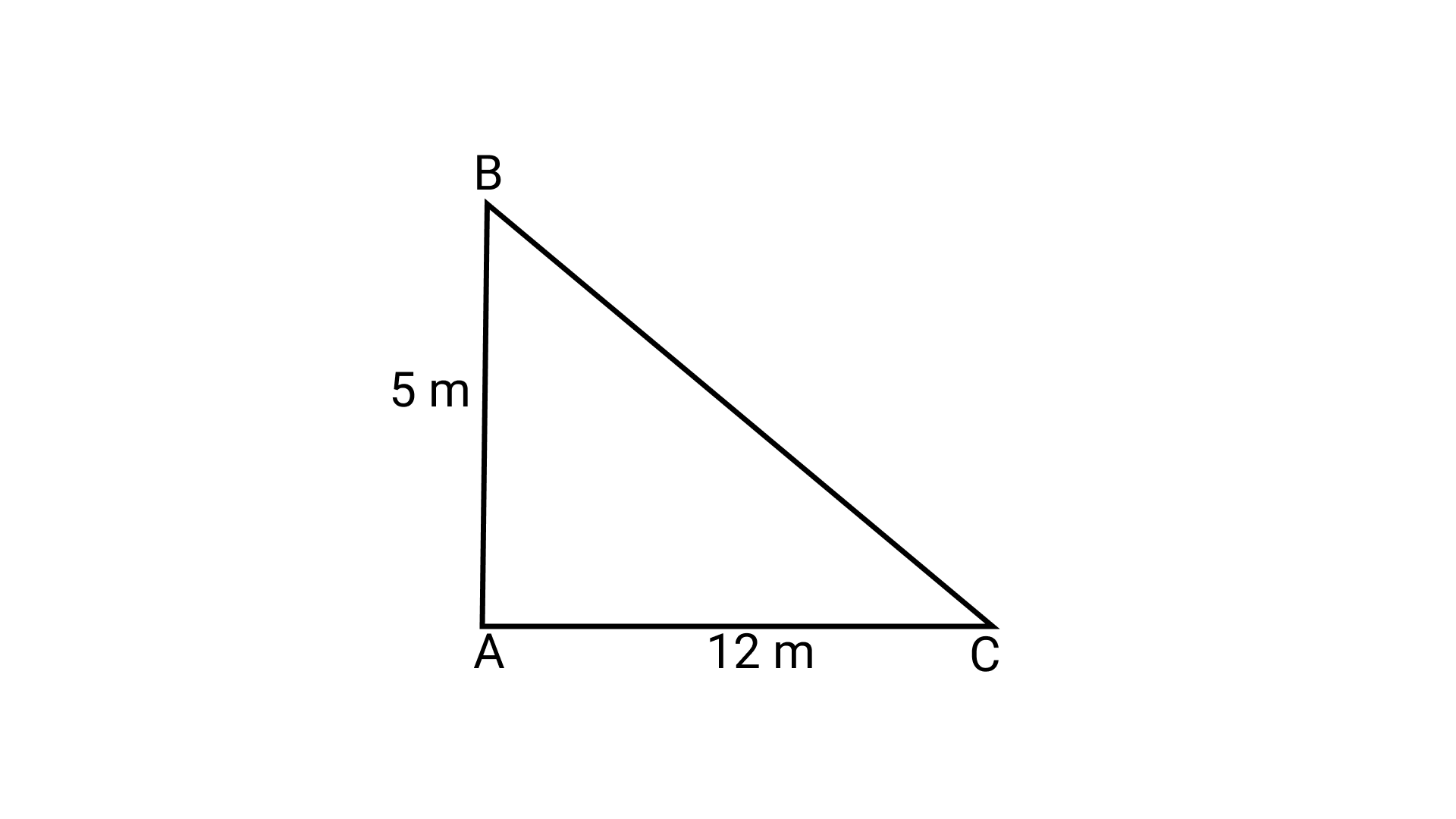
Here, $\triangle \mathrm{ABC}$ is right angled triangle
${\left( {BC} \right)^2}\; = {\text{ }}{\left( {AB} \right)^2}\; + {\text{ }}{\left( {AC} \right)^2}$
$\Rightarrow {\left( {BC} \right)^2}\; = {\text{ }}{\left( 5 \right)^2}\; + {\text{ }}{\left( {12} \right)^2}$
$\Rightarrow {\left( {BC} \right)^2}\; = {\text{ }}25{\text{ }} + {\text{ }}144{\text{ }}$
$\Rightarrow {\left( {BC} \right)^2} = {\text{ }}169$
$\Rightarrow {\left( {BC} \right)^2}\; = {\text{ }}{13^2}$
$\Rightarrow BC{\text{ }} = {\text{ }}13{\text{ m}}$
\[\therefore \] Actual height of tree is \[AB{\text{ }} + {\text{ }}BC{\text{ }} = {\text{ }}\left( {5{\text{ }} + {\text{ }}13} \right){\text{ m }} = {\text{ }}18{\text{ m}}\]
12. The triangle ABC formed by AB = 5 cm, BC = 8 cm, AC = 4 cm is
(a) an isosceles triangle only
(b) a scalene triangle only
(c) an isosceles right triangle
(d) scalene as well as a right triangle
Ans: Option (b) is correct.
AB = 5 cm, BC = 8 cm, AC = 4 cm
Now,
$\Rightarrow {5^2} + {4^2} \ne {8^2}$
$\Rightarrow 41 \ne 64$
And all sides are unequal.
Therefore, $\triangle \mathrm{ABC}$ is a scalene triangle only.
13. Two trees 7 m and 4 m high stand upright on the ground. If their bases (roots) are 4 m apart, then the distance between their tops is
(a) 3 m
(b) 5 m
(c) 4 m
(d) 11 m
Ans: Option (b) is correct.
Let AB and CD are the given trees of height 7 m and 4 m respectively.
$AC{\text{ }} = {\text{ }}DE{\text{ }} = {\text{ }}4{\text{ m}}$
$BE{\text{ }} = {\text{ }}AB{\text{ }}-{\text{ }}AE{\text{ }} = {\text{ }}\left( {7{\text{ }}-{\text{ }}4} \right){\text{ m }} = {\text{ }}3{\text{ m }}(\because AE{\text{ }} = {\text{ }}CD{\text{ }} = {\text{ }}4{\text{ m}})$
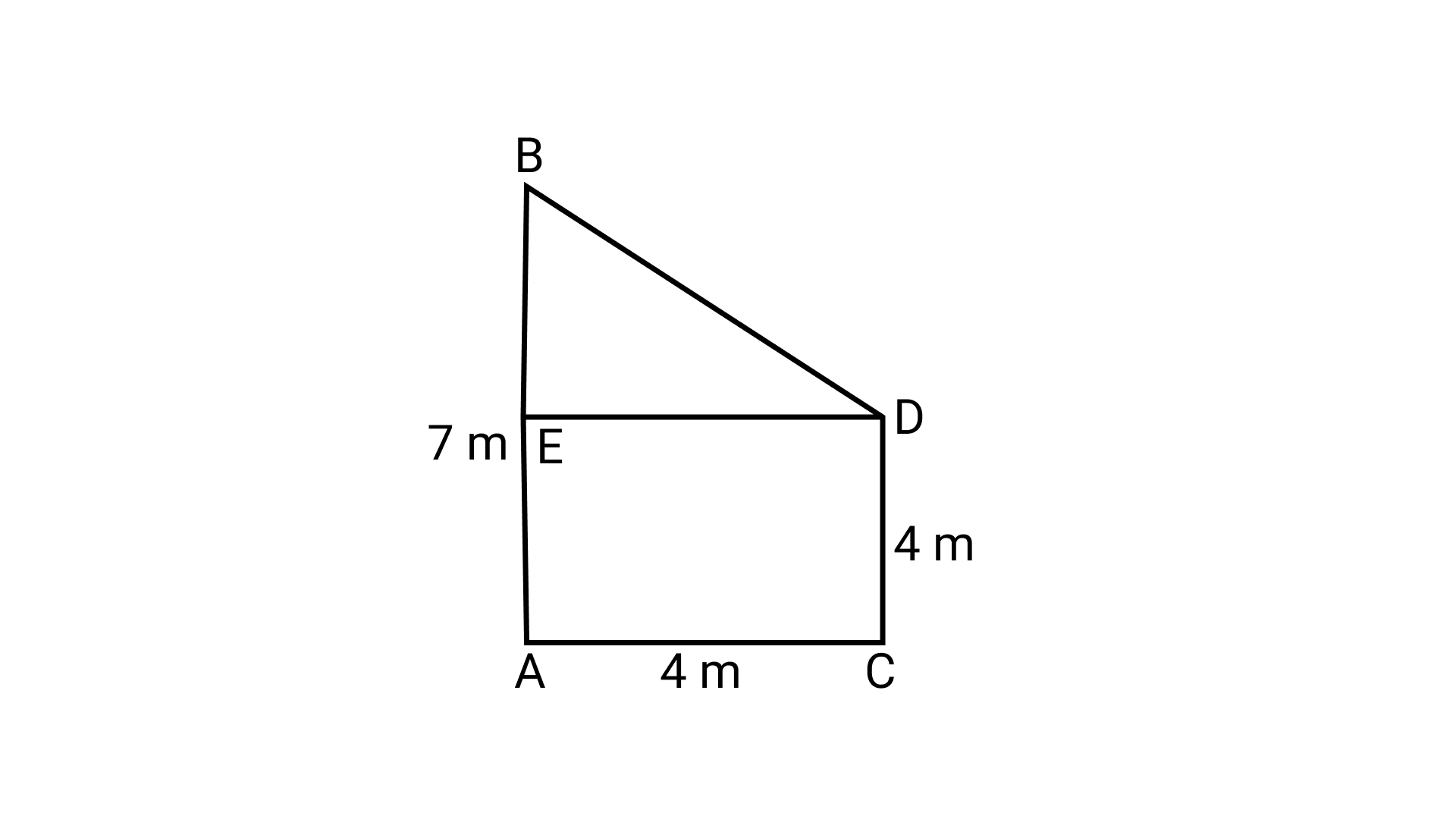
Now, $\triangle$BED is a right-angled triangle.
$\therefore {\left( {BD} \right)^2}\; = {\text{ }}{\left( {BE} \right)^2}\; + {\text{ }}{\left( {DE} \right)^2}$
$\Rightarrow {\left( {BD} \right)^2}\; = {\text{ }}{\left( 3 \right)^2}\; + {\text{ }}{\left( 4 \right)^2}\;$
$\Rightarrow {\left( {BD} \right)^2}\; = {\text{ }}9{\text{ }} + {\text{ }}16$
$\Rightarrow {\left( {BD} \right)^2}\; = {\text{ }}25{\text{ }}$
$\Rightarrow {\left( {BD} \right)^2}\; = {\text{ }}{5^2}$
$\Rightarrow BD{\text{ }} = {\text{ }}5{\text{ m}}$
Hence, the distance between the tops of trees is 5 m.
14. If in an isosceles triangle, each of the base angles is $40^\circ$, then the triangle is
(a) Right – angled triangle
(b) Acute angled triangle
(c) Obtuse-angled triangle
(d) Isosceles right-angled triangle
Ans: Option (c) is correct.
Let $\triangle \mathrm{ABC}$ be the given isosceles triangle in which AB = AC and each base angle is $40^\circ$.
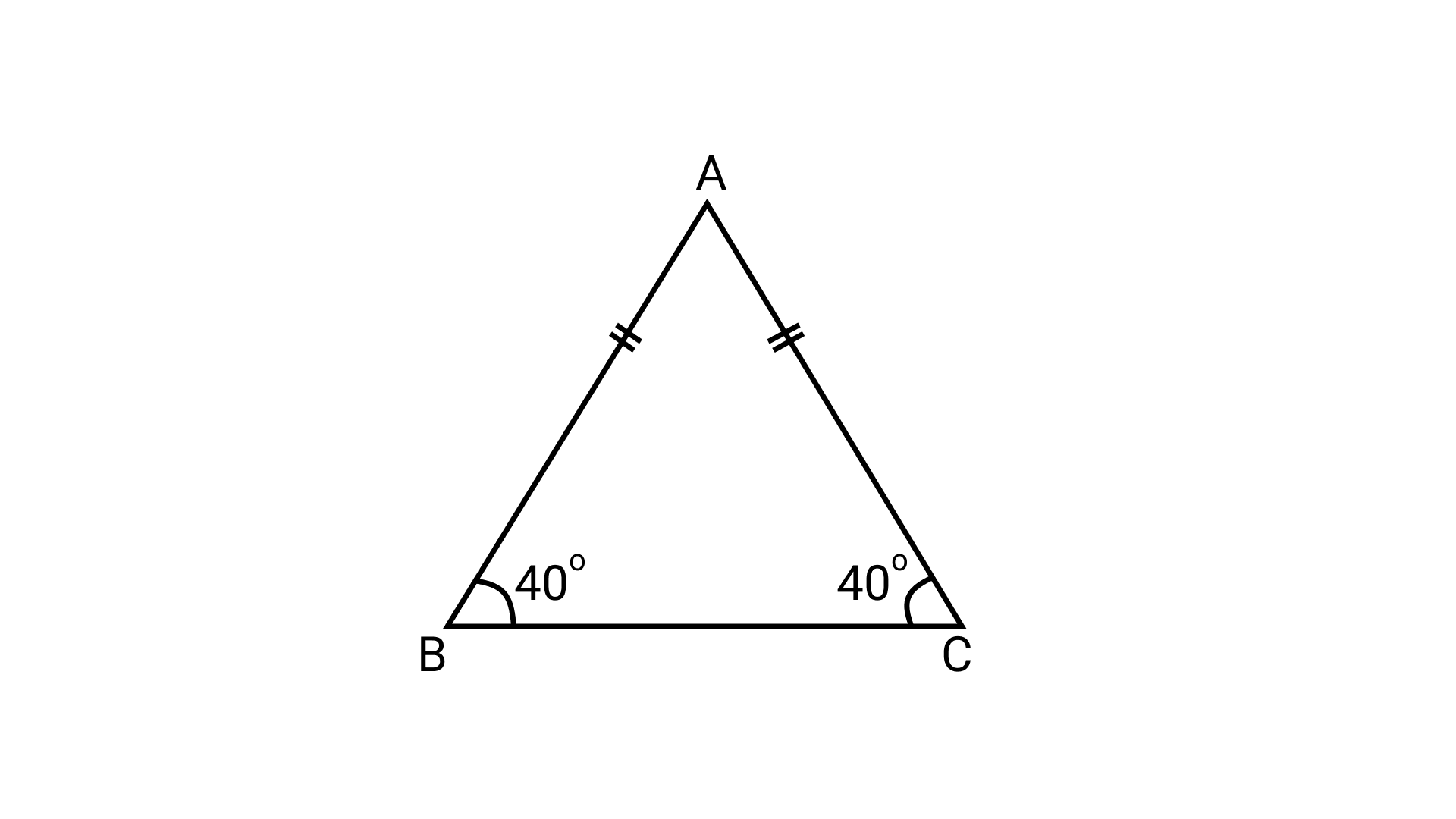
Now,
\[\angle A{\text{ }} + \angle B{\text{ }} + \angle C{\text{ }} = {\text{ }}180^\circ \](Angle sum property)
\[\Rightarrow \angle A{\text{ }} = {\text{ }}180^\circ -40^\circ -40^\circ = {\text{ }}100^\circ \] (Each base angle is $40^\circ$)
Thus, $\triangle \mathrm{ABC}$ is an obtuse angled triangle.
15. If two angles of a triangle are $60^\circ$ each, then the triangle is
(a) Isosceles but not equilateral
(b) Scalene
(c) Equilateral
(d) Right – angled.
Ans: Option (c) is correct.
Let $\triangle \mathrm{ABC}$ be the given triangle in which two angles are of $60^\circ$ each.
Now,
\[\angle A{\text{ }} + \angle B{\text{ }} + \angle C{\text{ }} = {\text{ }}180^\circ \](Angle sum property)
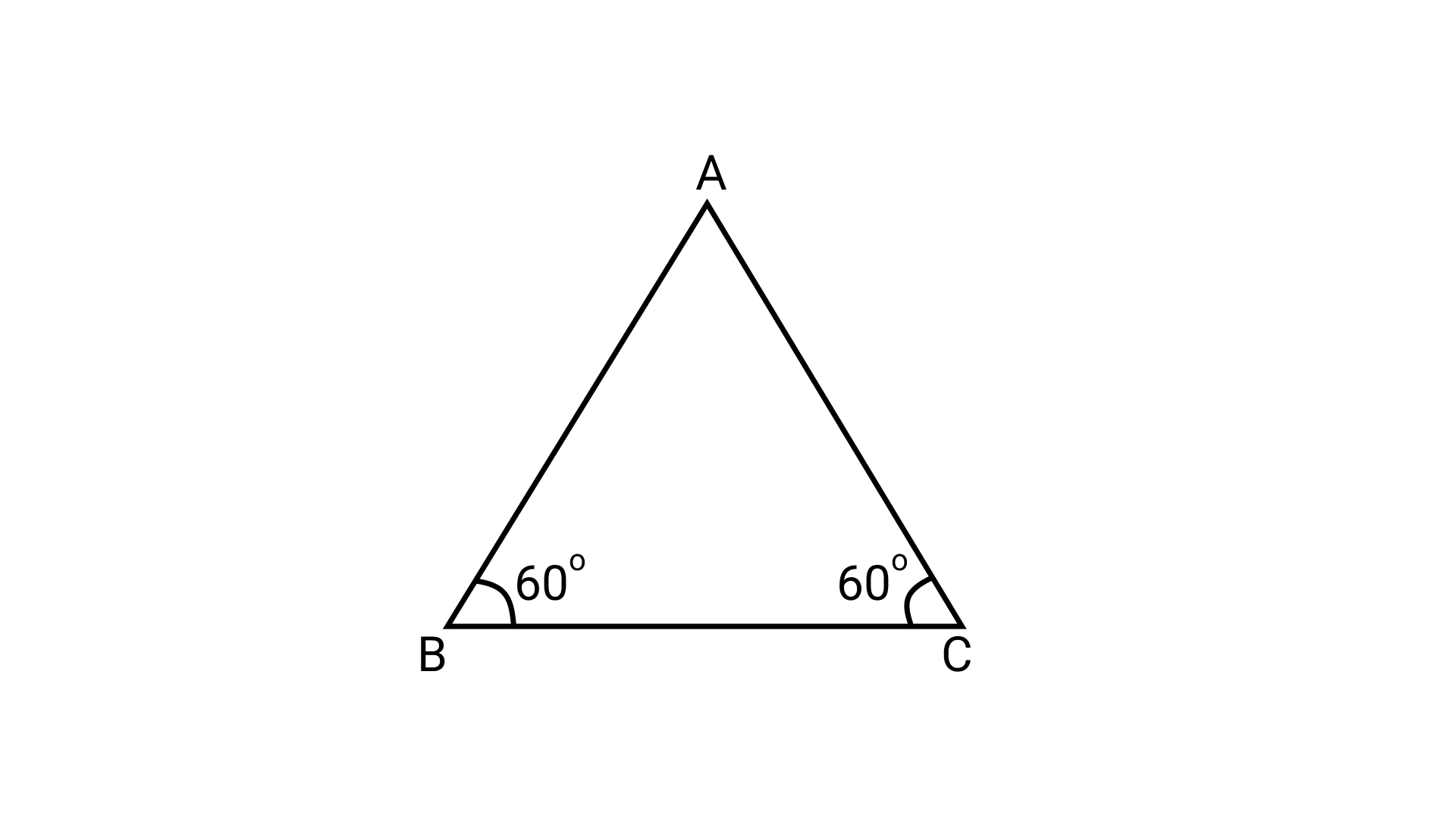
$\Rightarrow \angle A{\text{ }} = {\text{ }}180^\circ -60^\circ -60^\circ$
$\therefore \angle A{\text{ }} = {\text{ }}60^\circ$
Thus, all angles are of \[60^\circ \].
Therefore, $\triangle \mathrm{ABC}$ is an \[60^\circ \] equilateral triangle
16. The perimeter of the rectangle whose length is 60 cm and a diagonal is 61 cm is
(a) 120 cm
(b) 122 cm
(c) 71 cm
(d) 142 cm
Ans: Option (d) is correct.
Let $\triangle$BCD be the given rectangle such that AB =CD = 60 cm and AC = 61 cm.
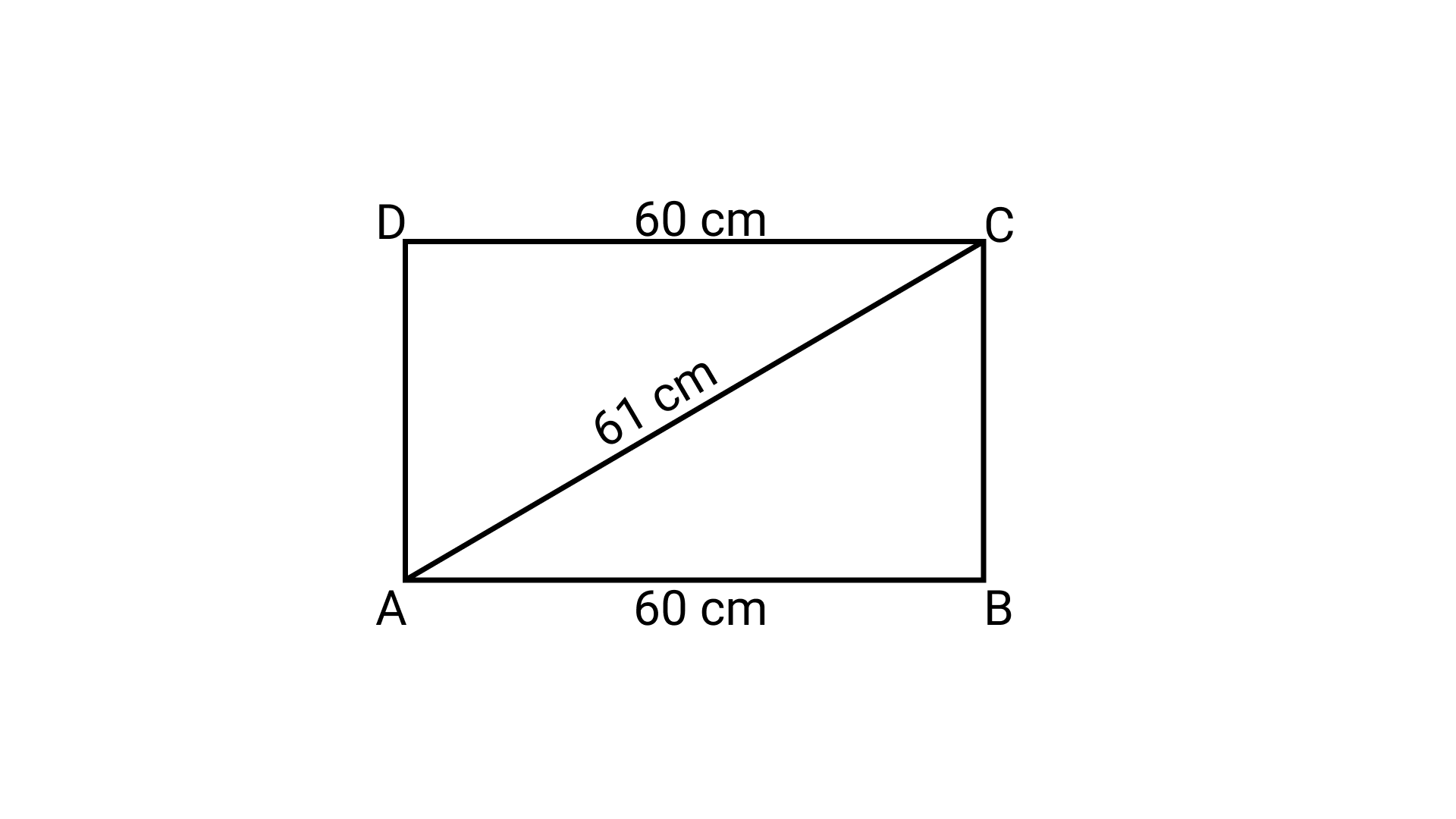
In $\triangle \mathrm{ABC}$,
${\left( {AC} \right)^2}\; = {\text{ }}{\left( {AB} \right)^2}\; + {\text{ }}{\left( {BC} \right)^2}$
$\Rightarrow {\left( {61} \right)^2}\; = {\text{ }}{\left( {60} \right)^2}\; + {\text{ }}{\left( {BC} \right)^2}$
$\Rightarrow {\left( {BC} \right)^2}\; = {\text{ }}3721{\text{ }}-{\text{ }}3600{\text{ }} = {\text{ }}121{\text{ }} = {\text{ }}{11^2}$
$\Rightarrow BC{\text{ }} = {\text{ }}11{\text{ cm}}$
Hence,
${\text{Perimeter of rectangle }}ABCD{\text{ }} = {\text{ }}2\left( {AB{\text{ }} + {\text{ }}BC} \right)$
$= {\text{ }}2{\text{ }}\left( {60{\text{ }} + {\text{ }}11} \right){\text{ }}$
$= {\text{ }}2\left( {71} \right){\text{ }}$
$= {\text{ }}142{\text{ cm}}$
17. In $\triangle$PQR, If PQ = OR and $\angle$ Q=$100^\circ$, then $\angle$ R is equal to
(a) $40^\circ$
(b) $80^\circ$
(c) $120^\circ$
(d) $50^\circ$
Ans: Option (a) is correct.
${\text{Let}}\angle R{\text{ }} = {\text{ }}x$
$ PQ{\text{ }} = {\text{ }}QR{\text{ }}\left( {{\text{given}}} \right)$
$\therefore \angle R{\text{ }} = \angle P{\text{ }} = {\text{ }}x$
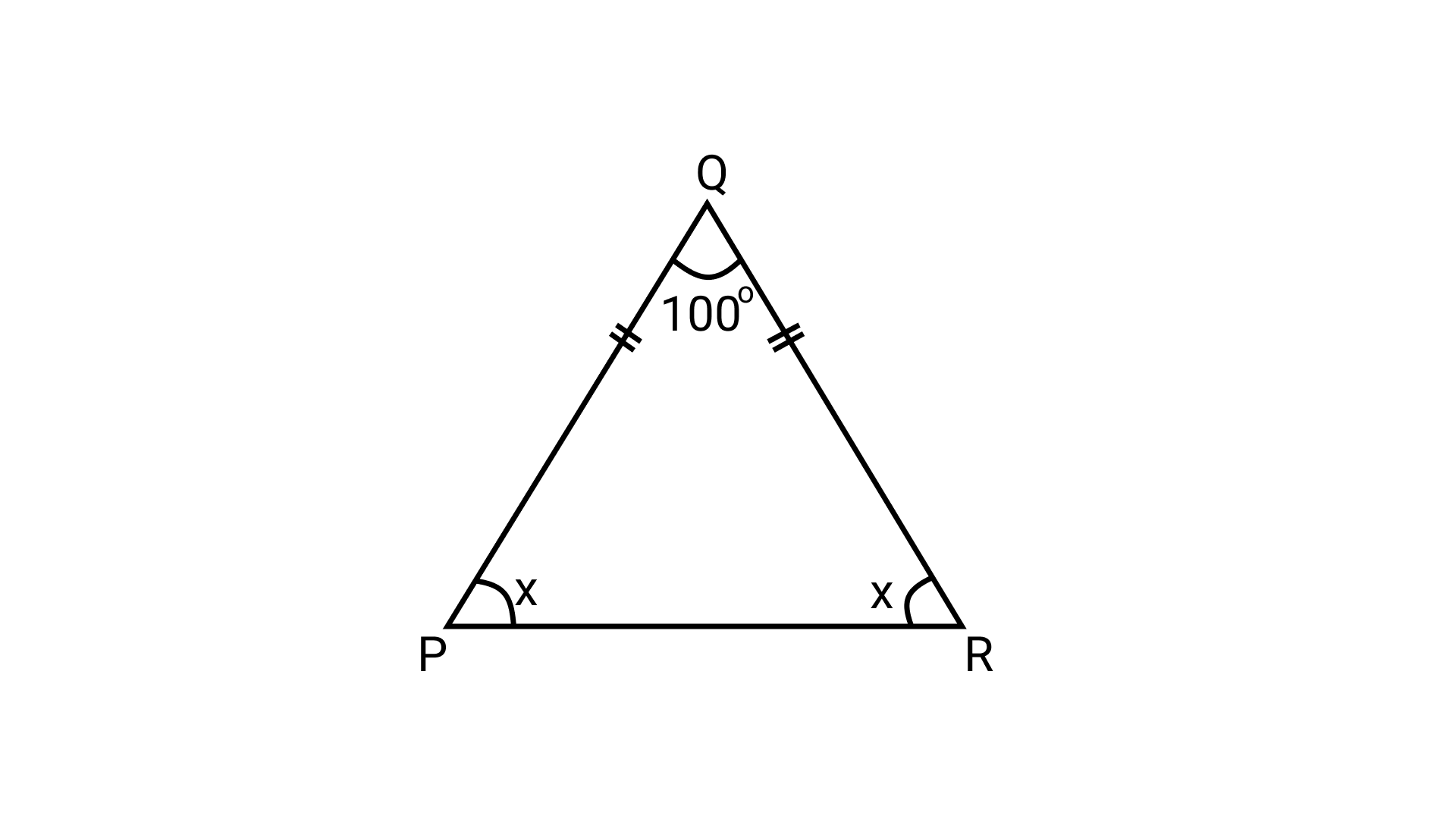
Now, in $\triangle$PQR
\[\angle P{\text{ }} + \angle Q{\text{ }} + \angle R{\text{ }} = {\text{ }}180^\circ \] (Angle sum property)
$\Rightarrow x{\text{ }} + {\text{ }}100^\circ + {\text{ }}x{\text{ }} = {\text{ }}180^\circ$
$\Rightarrow 2x{\text{ }} = {\text{ }}180^\circ -100^\circ = {\text{ }}80^\circ$
$\Rightarrow x = \frac{{80^\circ }}{2} = 40^\circ$
Thus, \[\angle R{\text{ }} = {\text{ }}40^\circ \].
18. Which of the following statements is not correct?
(a) The sum of any two sides of a triangle is greater than the third side
(b) A triangle can have all its angles acute
(c) A right-angled triangle cannot be equilateral
(d) Difference between any two sides of a triangle is greater than the third side
Ans: Option (d) is correct.
Since the difference of any two sides of a triangle is less than the third side.
19. In the given figure, BC = CA and $\angle$ A = $40^\circ$. Then, $\angle$ ACD is equal to the
(a) $40^\circ$
(b) $80^\circ$
(c) $120^\circ$
(d) $60^\circ$
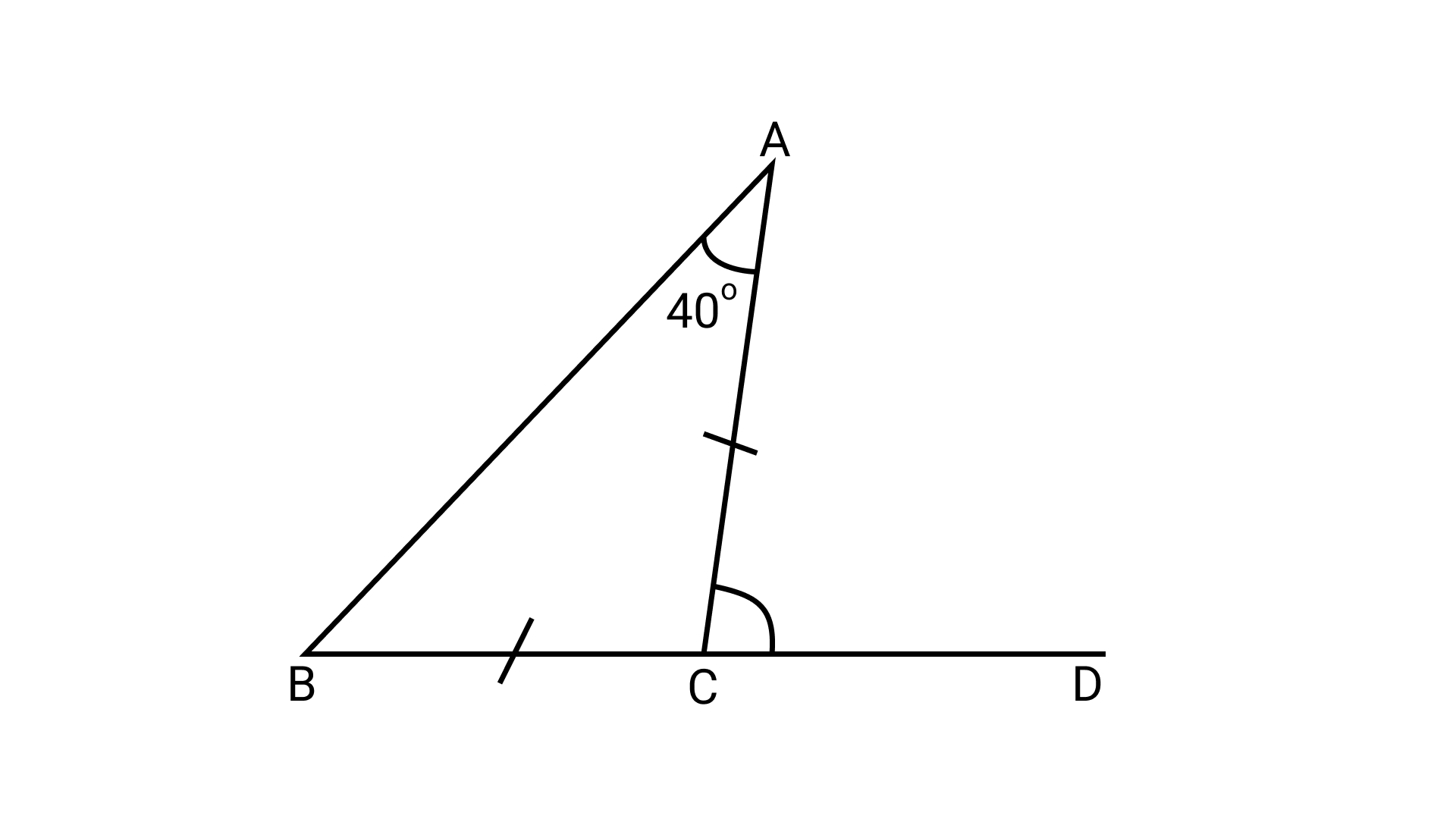
Ans: Option (b) is correct.
BC = CA (given)
\[\Rightarrow \angle A{\text{ }} = \angle B{\text{ }} = {\text{ }}40^\circ \] (\[\because \]Angles opposite to equal sides are equal)
Now,
\[\angle ACD{\text{ }} = \angle A{\text{ }} + \angle B\](Exterior angle property)
$\angle ACD = {\text{ }}40^\circ + {\text{ }}40^\circ$
$= {\text{ }}80^\circ$
20. The length of two sides of a triangle are 7 cm and 9 cm. The length of the third side may lie between
(a) 1 cm and 10 cm
(b) 2 cm and 8 cm
(c) 2 cm and 16 cm
(d) 1 cm and 16 cm
Ans: Option (c) is correct.
Length of two sides of a triangle are 7 cm and 9 cm.
Let the length of the third side be x cm.
Since, the sum of two sides is greater than the third side in a triangle.
$\therefore 7{\text{ }} + {\text{ }}9{\text{ }} > {\text{ }}x{\text{ or }}7{\text{ }} + {\text{ }}x{\text{ }} > {\text{ }}9{\text{ or }}9{\text{ }} + {\text{ }}x{\text{ }} > {\text{ }}7$
$\Rightarrow 16{\text{ }} > {\text{ }}x{\text{ or }}x{\text{ }} > {\text{ }}2{\text{ or }}x{\text{ }} > {\text{ }} - 2$
Since, side length cannot be negative.
\[\therefore 2{\text{ }} < {\text{ }}x{\text{ }} < {\text{ }}16\]
Thus, the third side may lie between 2 cm and 16 cm.
21. From the given figure, the value of x is
(a) $75^\circ$
(b) $90^\circ$
(c) $120^\circ$
(d) $60^\circ$
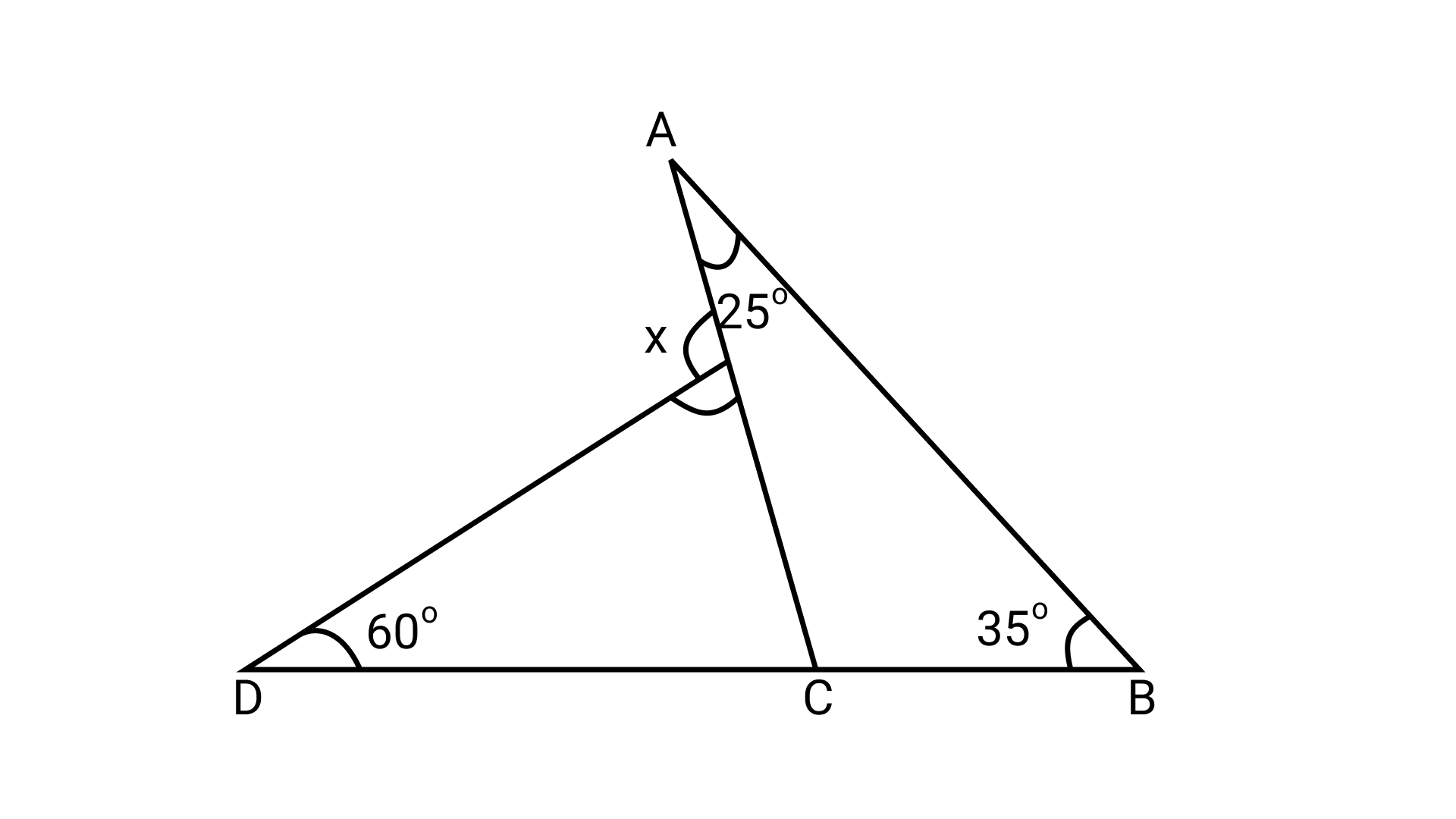
Ans: Option (c) is correct.
In $\triangle$ABC,
By exterior angle property,
$\angle$ ACD = $\angle$ CAB + $\angle$ ABC
$\Rightarrow$ $\angle$ ACD = $25^\circ$ + $35^\circ$
$\Rightarrow$ $\angle$ ACD = $60^\circ$ ………. (i)
Again, use exterior angle property,
x = $\angle$ D + $\angle$ ACD
$\Rightarrow$ x = $60^\circ$ + $60^\circ$ (Using equation (i))
Therefore, x = $120^\circ$
22. In the given figure, the value of $\angle$ A + $\angle$ B + $\angle$ C + $\angle$ D + $\angle$ E + $\angle$ F is
(a) 1$90^\circ$
(b) 5$40^\circ$
(c) 3$60^\circ$
(d) $180^\circ$
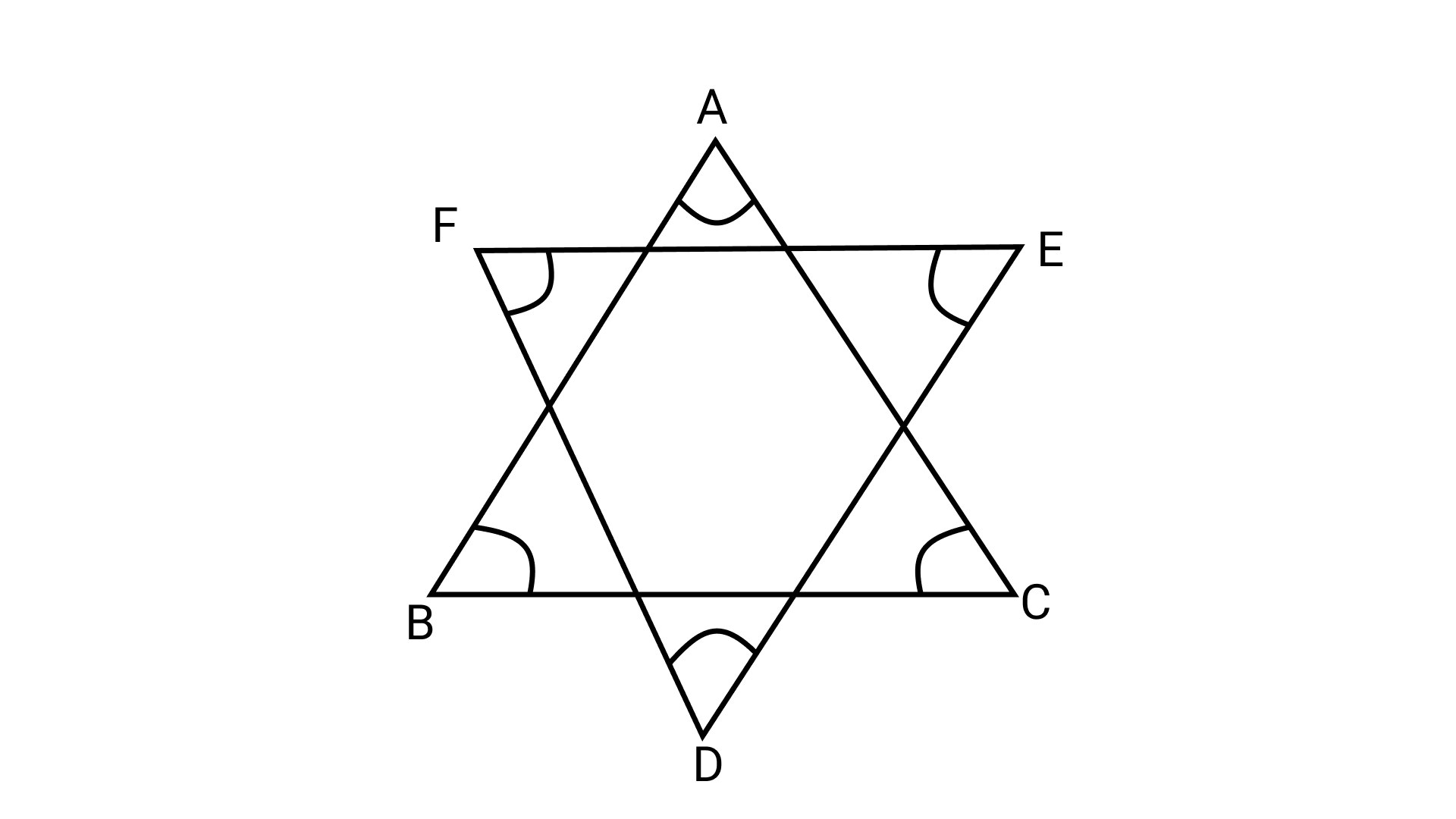
Ans: Option (c) is correct.
In $\triangle$ABC,
$\angle$ A + $\angle$ B + $\angle$ C = $180^\circ$ ………… (i) (By angle sum property)
In $\triangle$DEF,
$\angle$ D+ $\angle$ E + $\angle$ F = $180^\circ$ ………..(ii) (By angle sum property)
Add equations (i) and (ii),
$\angle$ A + $\angle$ B + $\angle$ C + $\angle$ D + $\angle$ E + $\angle$ F = $180^\circ$ + $180^\circ$ = 3$60^\circ$
23. In the given figure, PQ = PR, RS = RQ, and ST||QR. If the exterior angle RPU is 1$40^\circ$, then the measure of angle TSR is
(a) $55^\circ$
(b) $40^\circ$
(c) $50^\circ$
(d) $45^\circ$
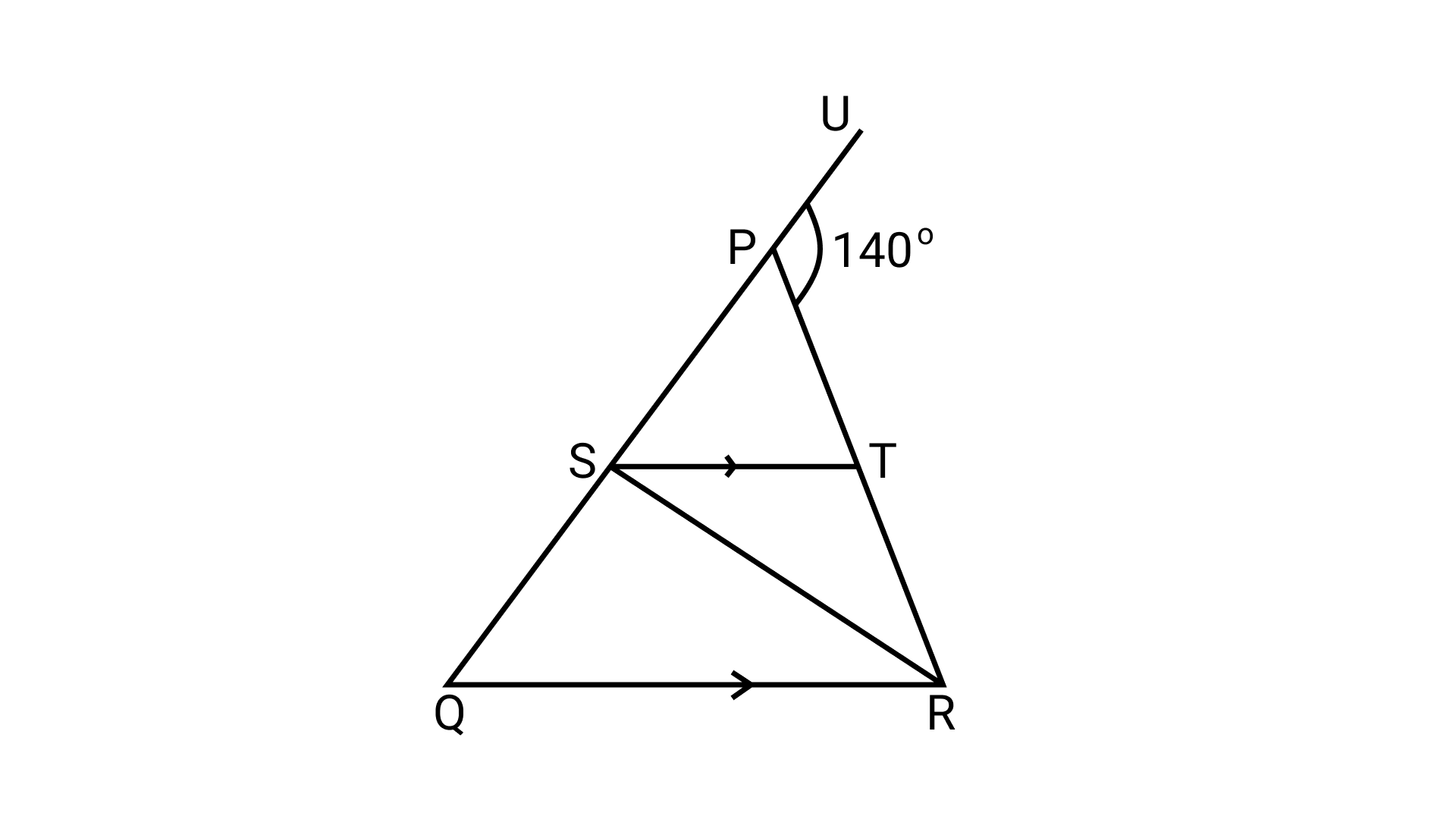
Ans: Option (b) is correct.
In $\triangle$PQR,
$\angle$ RPU = $\angle$ PRQ + $\angle$ PQR (Exterior angle property)
$\Rightarrow$ 1$40^\circ$ = 2 $\angle$ POR (Since PQ = PR, ∴ $\angle$ PRQ = $\angle$ PQR)
\[\Rightarrow \angle PQR = \frac{{140^\circ }}{2} = 70^\circ \]
ST || QR and QS is a transversal.
∴ $\angle$ PST = $\angle$ PQR = $70^\circ$ ………. (i) (Corresponding angles)
Now, in $\triangle$QSR
RS = RQ (given)
∴ $\angle$ SQR = $\angle$ RSQ = $70^\circ$ ………. (ii)
Now, PQ is a straight line.
So, $\angle$ PST + $\angle$ TSR + $\angle$ RSQ = $180^\circ$
$\Rightarrow$ $70^\circ$ + $\angle$ TSR + $70^\circ$ = $180^\circ$ (Using equations (i) and (ii))
$\Rightarrow$ $\angle$ TSR = $180^\circ$ – $70^\circ$ – 70 = $40^\circ$
24. In the given figure, $\angle$ BAC = $90^\circ$, AD ⊥ BC and $\angle$ BAD = $50^\circ$, then $\angle$ ACD is
(a) $50^\circ$
(b) $40^\circ$
(c) $70^\circ$
(d) $60^\circ$
Ans: Option (d) is correct.
(a) Given that
$\angle$ BAC = $90^\circ$ and $\angle$ BAD = $50^\circ$
∴ $\angle$ DAC = $\angle$ BAC – $\angle$ BAD = $90^\circ$ – $50^\circ$ = $40^\circ$
Now, in $\triangle$ADC,
$\angle$ ADB = $\angle$ DAC + $\angle$ ACD (Exterior angle property)
$\Rightarrow$ $90^\circ$ = $40^\circ$ + $\angle$ ACD (∵ AD ⊥ BC)
$\Rightarrow$ $\angle$ ACD = $90^\circ$ – $40^\circ$ = $50^\circ$
25. If one angle of a triangle is equal to the sum of the other two angles, the triangle is
(a) obtuse
(b) acute
(c) right
(d) equilateral
Ans: Option (c) is correct.
Let angles of a triangle be x, y, z such that x = y + z ………. (i)
Now,
x + y + z = $180^\circ$ (By angle sum property)
$\Rightarrow$ x + x = $180^\circ$ (Using equation (i))
$\Rightarrow 2x{\text{ }} = {\text{ }}180^\circ$
$\Rightarrow x = \frac{{180^\circ }}{2} = 90^\circ$
Thus, the triangle is right angled.
26. If the exterior angle of a triangle is 1$30^\circ$ and its interior opposite angles are equal, then measure of each interior opposite angle is
(a) $55^\circ$
(b) 65°
(c) $50^\circ$
(d) $60^\circ$
Ans: Option (b) is correct.
Let the interior opposite angles are x and x.
∴ 1$30^\circ$ = x + x (By exterior angle property)
$\Rightarrow$ 2x = 1$30^\circ$
$\Rightarrow x = \frac{{130^\circ }}{2}$
$\Rightarrow x = 65^\circ$
Thus, each interior opposite angle is of 65°
27. If one of the angles of a triangle is $110^\circ$, then the angle between the bisectors
of the other two angles is
(a) $70^\circ$
(b) $110^\circ$
(c) $35^\circ$
(d) 1$45^\circ$
Ans: Option (d) is correct.
Let $\triangle$ABC be the given triangle such that $\angle$ A = $110^\circ$ and OB, OC are the angle
bisectors of $\angle$ B, $\angle$ C respectively.
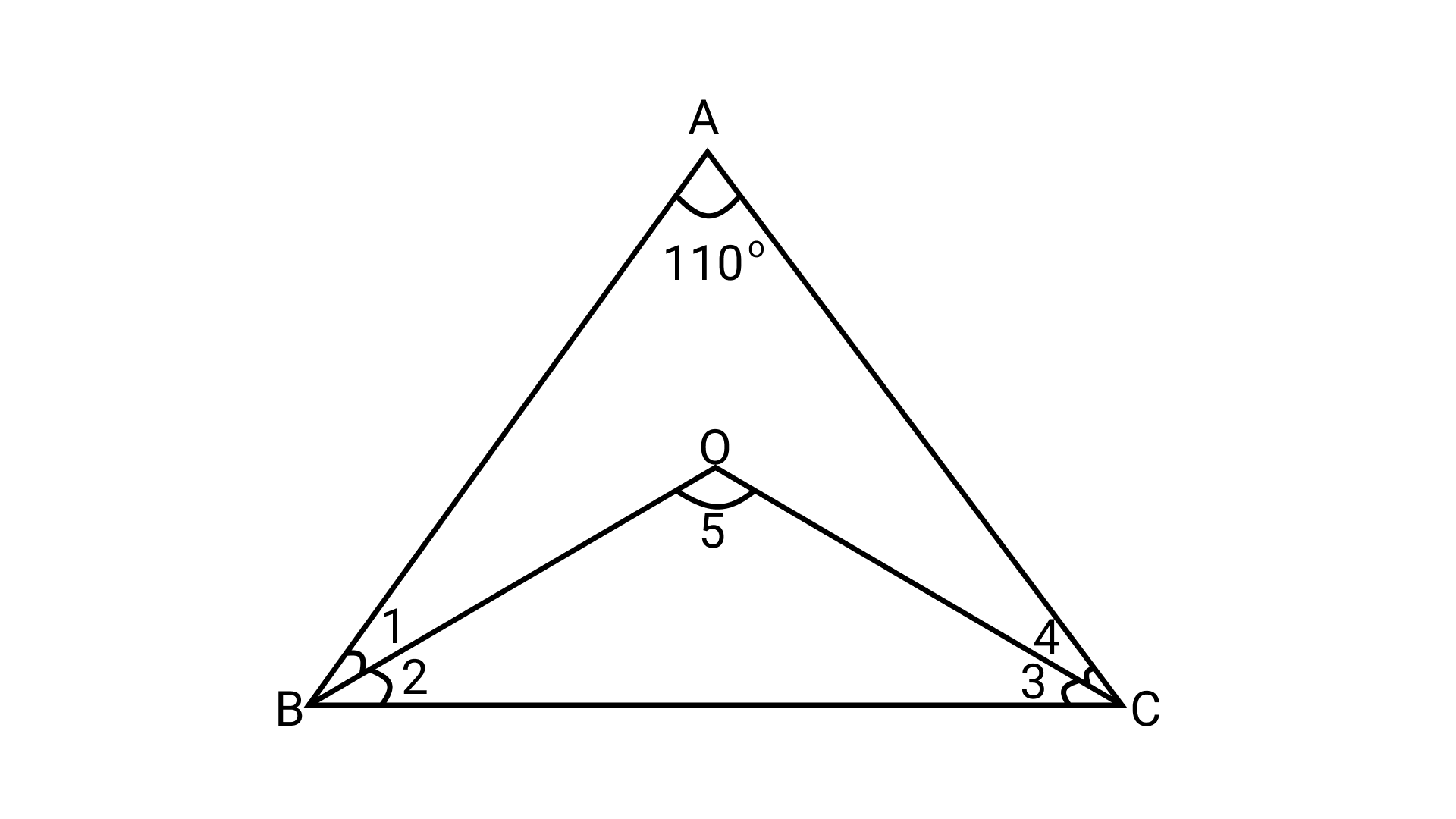
∴ $\angle$ 1 = $\angle$ 2, $\angle$ 3 = 4 ………. (i)
In $\triangle$ΑΒC,
$\angle$ A + $\angle$ B + $\angle$ C = $180^\circ$ (By angle sum property)
$\Rightarrow$ $110^\circ$ + $\angle$ 1 + $\angle$ 2 + $\angle$ 3 + $\angle$ 4 = $180^\circ$
$\Rightarrow$ 2( $\angle$ 2) +2( $\angle$ 3) = $180^\circ$ – $110^\circ$ (Using (1))
$\Rightarrow$ 2( $\angle$ 2 + $\angle$ 3) = $70^\circ$
$\Rightarrow \angle 2 + \angle 3 = \frac{{70^\circ }}{2}$
$\Rightarrow \angle 2 + \angle 3 = 35^\circ \; \ldots \ldots \ldots \ldots \left( {{\text{ii}}} \right)$
Now, in $\triangle$OBC
$\angle$ BOC + $\angle$ OBC + $\angle$ OCB = $180^\circ$ (Angle sum property)
$\Rightarrow$ $\angle$ BOC + $\angle$ 2 + $\angle$ 3 = $180^\circ$
$\Rightarrow$ $\angle$ BOC = $180^\circ$ – $35^\circ$ = 1$45^\circ$ (Using equation (ii))
Hence, the required angle is 1$45^\circ$.
28. In $\triangle$ABC, AD is the bisector of $\angle$ A meeting BC at D, CF ⊥ AB and E is the mid-point of AC. Then median of the triangle is
(a) AD
(b) BE
(c) FC
(d) DE
Ans: Option (b) is correct.
Since, the median of a triangle divides the opposite side into two equal parts.
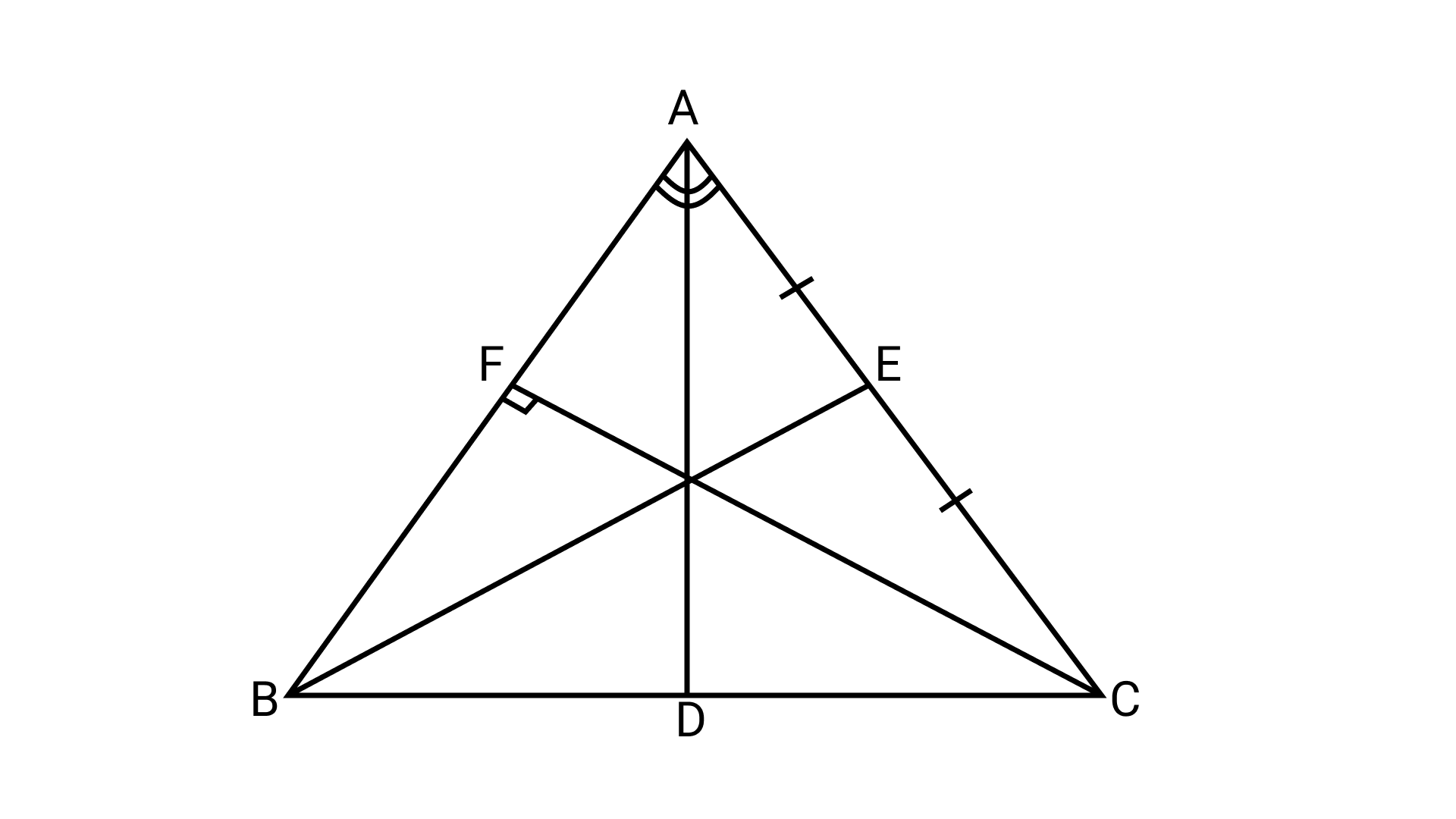
Therefore, BE is the median.
29. In $\triangle$PQR, if $\angle$ P = $60^\circ$, and $\angle$ Q = $40^\circ$, then the exterior angle formed by producing QR is equal to
(a) $60^\circ$
(b) $120^\circ$
(c) $100^\circ$
(d) $80^\circ$
Ans: Option (c) is correct.
Consider QR is produced to a point S.
In $\triangle$POR,
$\angle$ PRS = $\angle$ P + $\angle$ Q (By exterior angle property)
$\angle$ PRS = $60^\circ$ + 40 = $100^\circ$
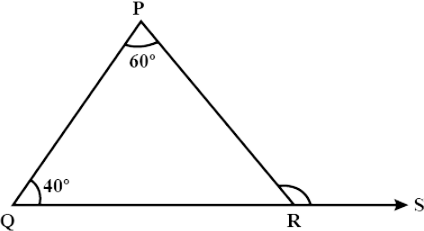
30. Which of the following triplets cannot be the angles of a triangle?
(a) 67°, 51°, 62°
(b) $70^\circ$, 83°, 27°
(c) $90^\circ$, $70^\circ$, $20^\circ$
(d) $40^\circ$, 132°, 18°
Ans: Option (d) is correct.
It is known that the sum of angles of a triangle is $180^\circ$ but $40^\circ$ + 132° + 18° = 1$90^\circ$
Therefore, $40^\circ$, 132°, 18° cannot be the angles of a triangle.
31. Which of the following can be the length of the third side of a triangle whose two sides measure 18 cm and 14 cm?
(a) 4 cm
(b) 3 cm
(c) 5 cm
(d) 32 cm
Ans: Option (c) is correct.
Let the third side of the triangle be x cm.
Since, the sum of any two sides of a triangle is greater than the third side.
∴ 18 + x > 14 or 14 + x > 18 or 18 + 14 > x
$\Rightarrow$ x > -4 or x > 4 or 32 > x
Since length cannot be negative, thus 4 < x < 32.
Hence, the third side of the triangle can be 5 cm from the available options.
32. How many altitudes does a triangle have?
(a) 1
(b) 3
(c) 6
(d) 9
Ans: Option (b) is correct.
A triangle has three altitudes.
33. If we join a vertex to a point on the opposite side which divides that side in the ratio 1:1, then what is the special name of that line segment?
(a) Median
(b) Angle bisector
(c) Altitude
(d) Hypotenuse
Ans: Option (a) is correct.
Median is a line segment which divides the opposite side into the ratio of 1 : 1.
34. The measures of x and y in the given figure are respectively
(a) $30^\circ$, $60^\circ$
(b) $40^\circ$, $40^\circ$
(c) $70^\circ$, $70^\circ$
(d) $70^\circ$, $60^\circ$
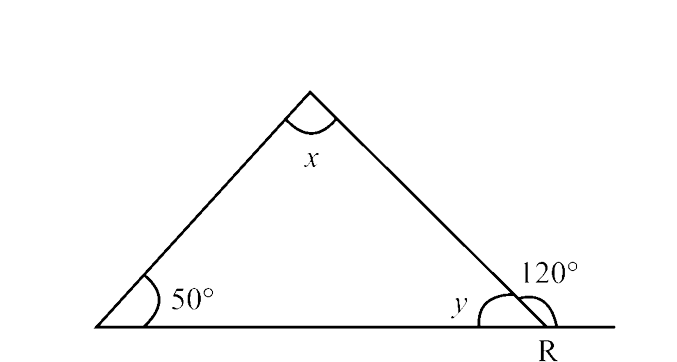
Ans: Option (d) is correct.
In $\triangle$PQR,
$\angle$ PRS = $\angle$ RPQ + $\angle$ POR (By exterior angle property)

$\Rightarrow$ $120^\circ$ = x + $50^\circ$
$\Rightarrow$ x = $120^\circ$- $50^\circ$ = $70^\circ$
Now,
x + y + $50^\circ$ = $180^\circ$ (By angle sum property)
$\Rightarrow$ $70^\circ$ + y + $50^\circ$ = $180^\circ$
$\Rightarrow$ y = $180^\circ$ – $70^\circ$ – $50^\circ$ = $60^\circ$
Thus, x = $70^\circ$, y = $60^\circ$
35. If length of two sides of a triangle are 6 cm and 10 cm, then the length of the
third side can be
(a) 3 cm
(b) 4 cm
(c) 2 cm
(d) 6 cm
Ans: Option (d) is correct.
(d) Let the third side of the triangle be x cm.
Since, the sum of any two sides of a triangle is greater than the third side.
∴ 6 + x > 10 or 10 + x > 6 or 10 + 6 > x
$\Rightarrow$ x > 4 or x > -4 or x < 16
Since the length cannot be negative, thus 4 < x < 16.
Hence, the third side can be 6 cm from the available options.
36. In a right-angled triangle ABC, if angle B = $90^\circ$, BC = 3 cm and AC = 5 cm, then the length of side AB is
(a) 3 c
(b) 4 cm
(c) 5 cm
(d) 6 cm
Ans: Option (b) is correct.
In the right angled triangle $\triangle$ABC,
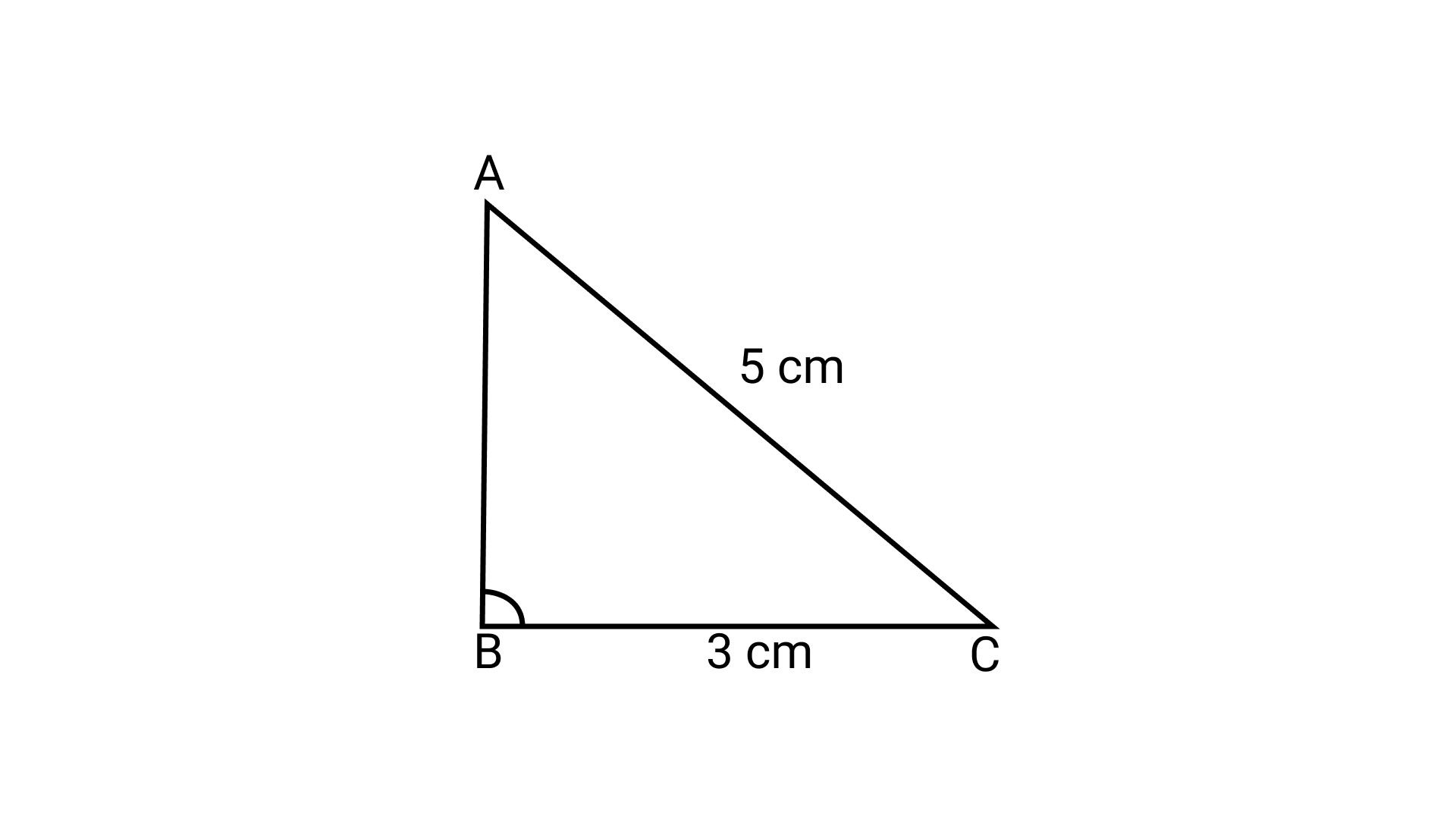
${\left( {AC} \right)^2}\; = {\text{ }}{\left( {AB} \right)^2}\; + {\text{ }}{\left( {BC} \right)^2}$
$\Rightarrow {5^2}\; = {\text{ }}{\left( {AB} \right)^2}\; + {\text{ }}{3^2}$
$\Rightarrow {\left( {AB} \right)^2}\; = {\text{ }}25{\text{ }}-{\text{ }}9{\text{ }} = {\text{ }}16{\text{ }} = {\text{ }}{4^2}$
$\Rightarrow AB{\text{ }} = {\text{ }}4{\text{ cm}}$
37. In a right-angled triangle ABC, if angle B = $90^\circ$, then which of the following is true?
(a) AB2 = BC2 + AC2
(b) AC2 = AB2 + BC2
(c) AB =BC + AC
(d) AC = AB + BC
Ans: Option (b) is correct.
In the right angled triangle ABC,
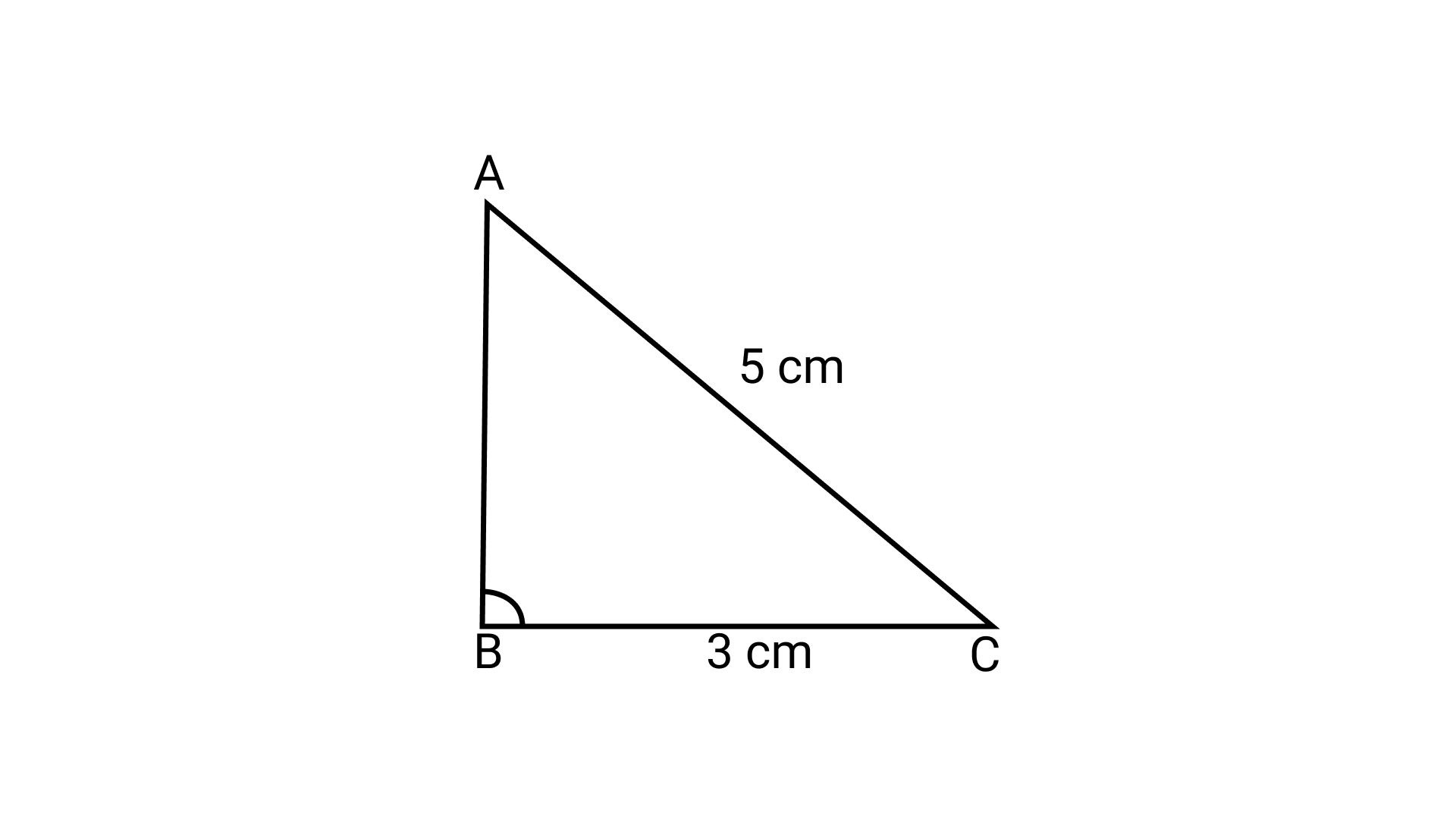
$\angle B = 90^\circ$ (Given)
Thus by Pythagoras theorem,
(AC)2 = (AB)2 + (BC)2
38. Which of the following figures will have its altitude outside the triangle?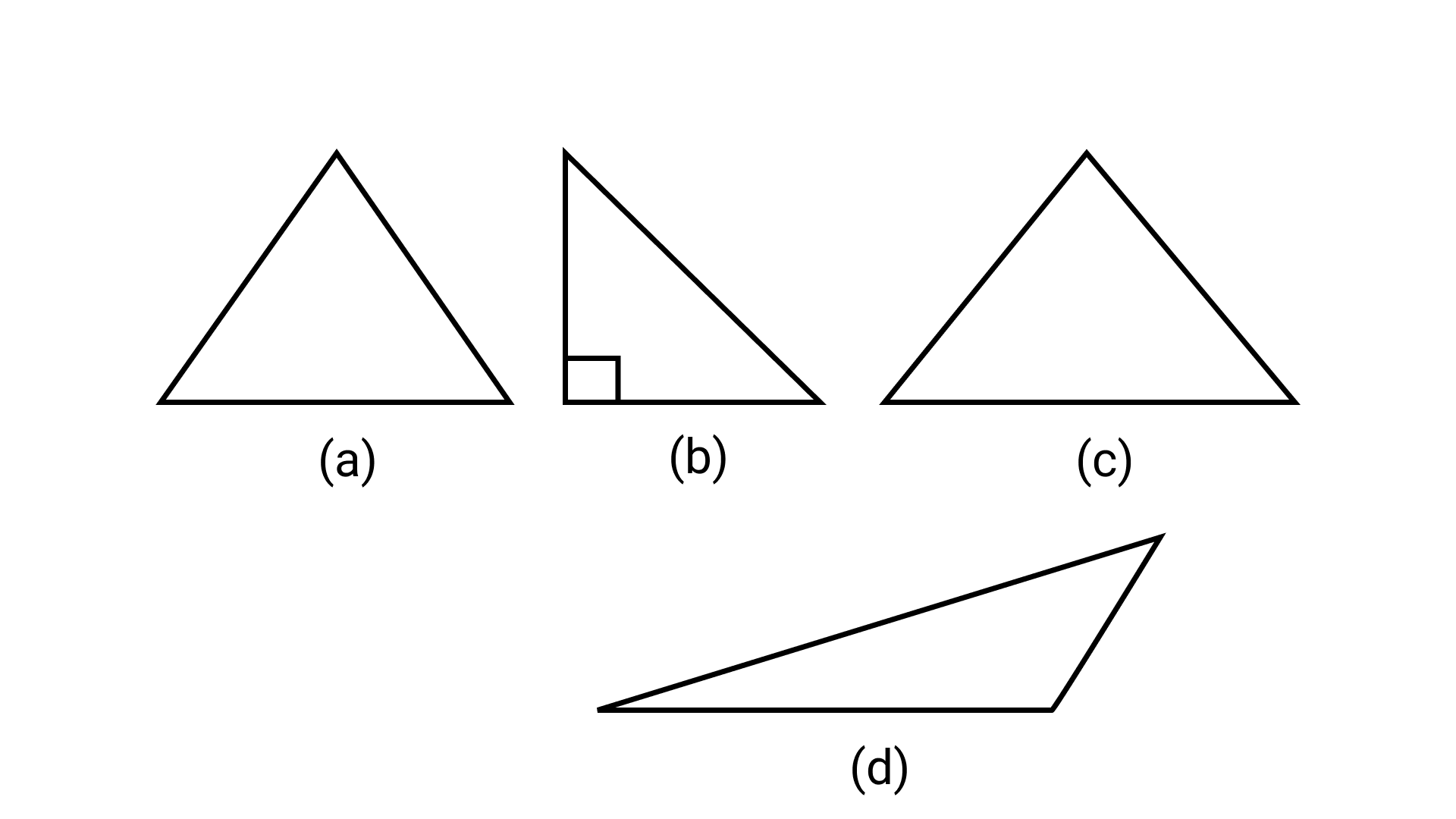
Ans: Option (d) is correct.
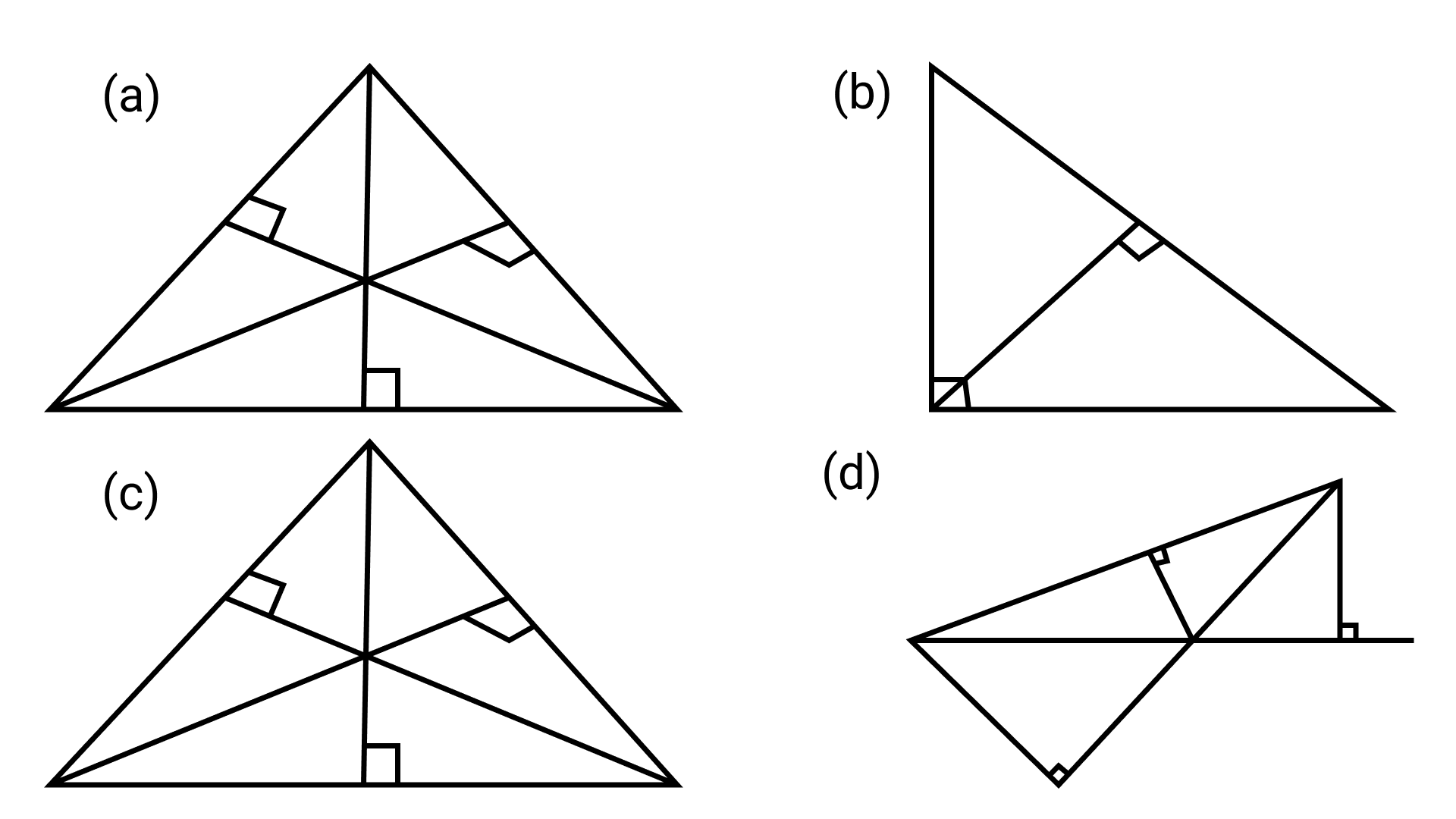
By drawing the altitudes it can be concluded that the triangle in option (d) has its altitude outside the triangle.
39. In the given figure, if AB|| CD, then
(a) $\angle$ 2 = $\angle$ 3
(b) $\angle$ 1 = $\angle$ 4
(c) $\angle$ 4 = $\angle$ 1 + $\angle$ 2
(d) $\angle$ 1 + $\angle$ 2 = $\angle$ 3 + $\angle$ 4
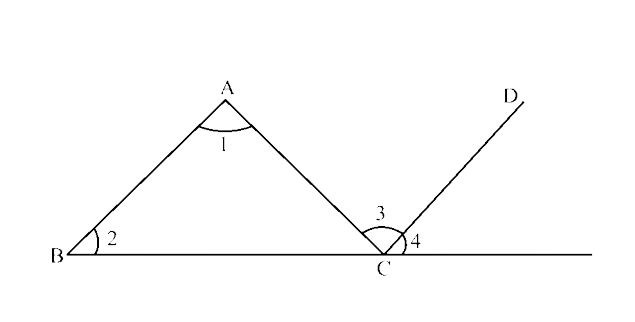
Ans: Option (d) is correct.
Given, AB || CD
∴ $\angle$ 2 = $\angle$ 4 ……. (i) (Corresponding angles)
And $\angle$ 1 = $\angle$ 3 ………. (ii) (Alternate interior angles)
Add equations (i) and (ii),
$\angle$ 1 + $\angle$ 2 = $\angle$ 3 + $\angle$ 4
40. In $\triangle$ABC, $\angle$ A = $100^\circ$, AD bisects $\angle$ A and AD ⊥ BC. Then, $\angle$ B is equal to
(a) $80^\circ$
(b) $20^\circ$
(c) $40^\circ$
(d) $30^\circ$
Ans: Option (c) is correct.
AD bisects, $\angle$ A.
$\therefore \;\angle BAD = \angle DAC = \frac{1}{2}\angle BAC$
$\Rightarrow \angle BAD = \frac{{100^\circ }}{2} = 50^\circ$
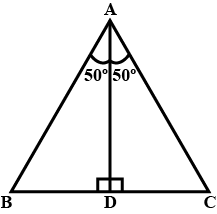
Now, AD ⊥ BC
∴ $\angle$ ADC = $90^\circ$
Now, in $\triangle$ABD,
$\angle$ ADC = $\angle$ ABD + $\angle$ BAD (By exterior angle property)
$\Rightarrow$ $90^\circ$ = $\angle$ ABD + $50^\circ$
$\Rightarrow$ $\angle$ ABD = $90^\circ$- $50^\circ$ = $40^\circ$
Thus, $\angle$ B = $40^\circ$
41. In $\triangle$ABC, $\angle$ A = $50^\circ$, $\angle$ B = $70^\circ$ and the bisector of $\angle$ C meets AB in D (see figure).
Measure of $\angle$ ADC is
(a) $50^\circ$
(b) $100^\circ$
(c) $30^\circ$
(d) $70^\circ$
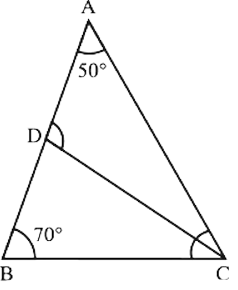
Ans: Option (b) is correct.
In $\triangle$ABC, $\angle$ A + $\angle$ B + $\angle$ C = $180^\circ$ (By angle sum property)
$\Rightarrow$ $\angle$ C = $180^\circ$ – $70^\circ$ – $50^\circ$
$\Rightarrow$ $\angle$ C = 60 °
Since, CD bisects $\angle$ C.
$\therefore \;\angle DCB = \angle ACD = \frac{1}{2}\angle C$
$\Rightarrow \frac{1}{2}\angle C = \frac{{60^\circ }}{2} = 30^\circ$
Now, in $\triangle$BDC,
$\angle$ ADC = $\angle$ DBC + $\angle$ DCB (By exterior angle property)
$\Rightarrow$ $\angle$ ADC = $70^\circ$ + 30
$\Rightarrow$ $\angle$ ADC = $100^\circ$
42. If for $\triangle$ABC and $\triangle$DEF, the correspondence CAB ⟷ EDF gives a
congruence, then which of the following is not true?
(a) AC = DE
(b) AB = EF
(c) $\angle$ A = $\angle$ D
(d) $\angle$ C = $\angle$ E
Ans: Option (b) is correct.
Given that $\triangle$CAB ≅ $\triangle$EDF
∴ By C.P.C.T.
AC = DE, AB = DF, BC = FE
And
$\angle$ A = $\angle$ D, $\angle$ C = $\angle$ E, $\angle$ B = $\angle$ F
43. In the given figure, M is the mid-point of both AC and BD. Then
(a) $\angle$ 1 = $\angle$ 2
(b) $\angle$ 1 = $\angle$ 4
(c) $\angle$ 2 = $\angle$ 4
(d) $\angle$ 1 = $\angle$ 3
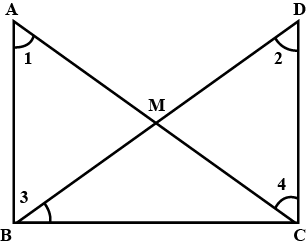
Ans: Option (b) is correct.
In $\triangle$AMB and $\triangle$CMD,
AM = CM (M is midpoint of AC)
BM = DM (M is midpoint of BD)
$\angle$ AMB = $\angle$ CMD (Vertically opposite angles)
So, $\triangle$AMB ≅ $\triangle$CMD (By SAS criterion)And
$\angle$ 1 = $\angle$ 4 (By C.P.C.T)
44. If D is the midpoint of the side BC in $\triangle$ABC where AB = AC, then $\angle$ ADC is
(a) $60^\circ$
(b) $45^\circ$
(c) $120^\circ$
(d) $90^\circ$
Ans: Option (d) is correct.
In $\triangle$ABD and $\triangle$ACD,
AD = AD (common)
AB = AC (given)
BD = CD (D is midpoint of BC)
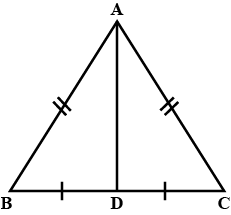
∴ $\triangle$ABD ≅ $\triangle$ACD (By SSS criterion)
∴ $\angle$ ADB = $\angle$ ADC (By C.P.C.T)
But $\angle$ ADB + $\angle$ ADC = $180^\circ$ (As BC is a straight line)
$\Rightarrow$ $\angle$ ADC + $\angle$ ADC = $180^\circ$
$\Rightarrow$ 2 $\angle$ ADC = $180^\circ$
$\Rightarrow$ $\angle$ ADC = $90^\circ$
45. Two triangles are congruent, if two angles and the side included between them in one of the triangles are equal to the two angles and the side included between them of the other triangle. This is known as the
(a) RHS congruence criterion
(b) ASA congruence criterion
(c) SAS congruence criterion
(d) AAA congruence criterion
Ans: Option (b) is correct.
It is known as ASA congruence criterion.
46. By which congruency criterion, the two triangles in the given figure are congruent?
(a) RHS
(b) ASA
(c) SSS
(d) SAS
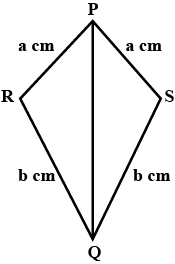
Ans: Option (c) is correct.
In $\triangle$PRQ and $\triangle$PSQ,
PQ = PQ (common side)
PR = PS = a cm (given)
QR = QS = b = cm (given)
So, $\triangle$PRQ ≅ $\triangle$PSQ (By SSS criterion)
47. By which of the following criterion two triangles cannot be proved congruent?
(a) AAA
(b) SSS
(c) SAS
(d) ASA
Ans: Option (a) is correct.
With AAA criterion two triangles cannot be proved congruent.
48. If $\triangle$PQR is congruent to $\triangle$STU (see figure), then what is the length of TU?
(a) 5 cm
(b) 6 cm
(c) 7 cm
(d) cannot be determined
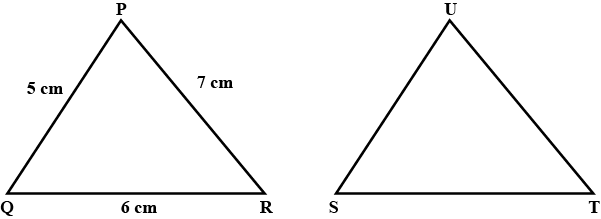
Ans: Option (b) is correct.
It is given that $\triangle$PQR ≅ $\triangle$STU.
∴ TU = QR = 6 cm (By C.P.C.T.)
49. If $\triangle$ABC and $\triangle$DBC are on the same base BC, AB = DC and AC = DB (see figure), then which of the following gives a congruence relationship?
(a) $\triangle$ABC ≅ $\triangle$DBC
(b) $\triangle$ABC ≅ $\triangle$CBD
(c) $\triangle$ABC ≅ $\triangle$DCB
(d) $\triangle$ABC ≅ $\triangle$BCD
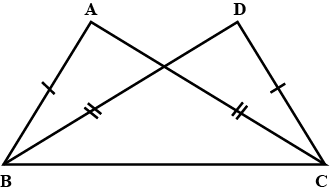
Ans: Option (c) is correct.
In $\triangle$ABC and $\triangle$DCB,
AB = DC (given)
AC = DB (given)
BC = CB (common)
∴ $\triangle$ABC ≅ $\triangle$DCB (By SSS criterion)
Directions: In questions 50 to 69, fill in the blanks to make the statements true.
50. The ________ triangle always has altitude outside itself.
Ans: Obtuse-angled
51. The sum of an exterior angle of a triangle and its adjacent angle is always ________
Ans: $180^\circ$
52. The longest side of a right-angled triangle is called its ________
Ans: Hypotenuse
53. Median is also called ________ in an equilateral triangle.
Ans: Altitude
54. Measures of each of the angles of an equilateral triangle is ________
Ans: $60^\circ$
55. In an isosceles triangle, two angles are always ________
Ans: Equal
56. In an isosceles triangle, angles opposite to equal sides are ________
Ans: Equal
57. If one angle of a triangle is equal to the sum of other two, then the measure
of that angle is ________
Ans: $90^\circ$
Consider the angles of the triangle be x, y and z.
Given that x = y + z ………… (i)
Now, x + y + z = $180^\circ$ (By angle sum property)
$\Rightarrow x{\text{ }} + {\text{ }}x{\text{ }} = {\text{ }}180^\circ \left( {{\text{Using }}\left( {\text{i}} \right)} \right)$
$\Rightarrow 2x{\text{ }} = {\text{ }}180^\circ$
$\Rightarrow x{\text{ }} = {\text{ }}\frac{{180^\circ }}{2}$
$\Rightarrow x{\text{ }} = {\text{ }}90^\circ$
58. Every triangle has at least ________ acute angle(s).
Ans: Two
59. Two-line segments are congruent, if they are ________ lengths.
Ans: Equal
60. Two angles are said to be ________ if they have equal measures.
Ans: Congruent
61. Two rectangles are congruent, if they have same ________ and ________
Ans: Length, breadth
62. Two squares are congruent, if they have same ________
Ans: Side
63. If $\triangle$PQR and $\triangle$XYZ are congruent under the correspondence QPR ⟷ XYZ,
Then
(i) $\angle$ R = ________
Given that $\triangle$QPR ≅ $\triangle$XYZ
So, by C.P.C.T.
$\angle$ R = $\angle$ Z
(ii) QR = ________
QR = XZ
(iii) $\angle$ P = ________
$\angle$ P = $\angle$ Y
(iv) QP = ________
QP = XY
(v) $\angle$ Q = ________
$\angle$ Q = $\angle$ X
(vi) RP = ________
RP = ZY
64. In the given figure, $\triangle$PQR ≅ $\triangle$________
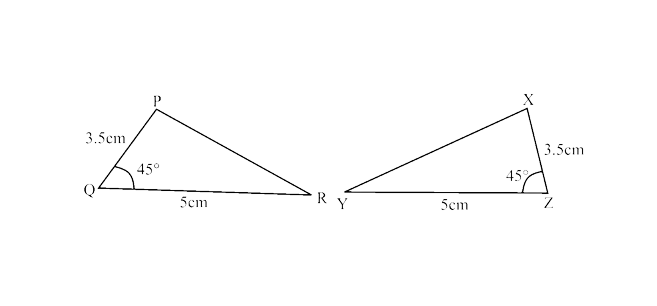
Ans: XZY
In $\triangle$PQR and $\triangle$XZY,
PQ = XZ = 3.5 cm
$\angle$ PQR = $\angle$ XZY = $45^\circ$
QR = ZY = 5 cm
∴ $\triangle$PQR ≅ $\triangle$XZY (By SAS criterion)
65. In the given figure, $\triangle$PQR ≅ $\triangle$ ________

Ans: RSP
In $\triangle$PQR and $\triangle$RSP,
QR = SP = 4.1 cm
$\angle$ PRQ = $\angle$ RPS = $45^\circ$
PR = RP (common)
∴ $\triangle$PQR ≅ $\triangle$RSP (By SAS criterion)
66. In the given figure, $\triangle$ ________ ≅ $\triangle$PQR
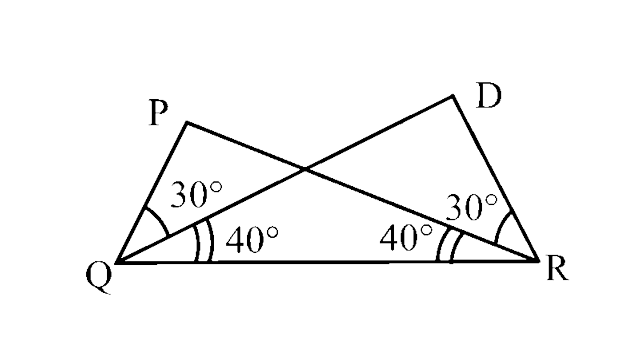
Ans: DRQ
In $\triangle$PQR and $\triangle$DRQ,
$\angle$ PRQ = $\angle$ DQR = $40^\circ$
$\angle$ PQR = $\angle$ DRQ = $30^\circ$ + $40^\circ$ = $70^\circ$
QR = RQ (common)
∴ $\triangle$PQR ≅ $\triangle$DRQ (By ASA criterion)
67. In the given figure, $\triangle$ARO ≅ $\triangle$ __________
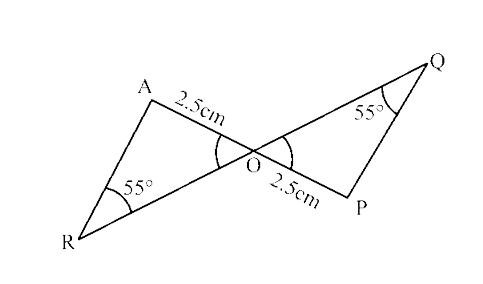
Ans: PQO
In $\triangle$ARO and $\triangle$PQO,
$\angle$ ARO = $\angle$ PQO = $55^\circ$
$\angle$ AOR = $\angle$ POQ (Vertically opposite angles)
∴ $\angle$ RAQ = $\angle$ QPO (∵ If two angles of a triangle are equal to two angles of another
triangle then third angle is also equal)
AO = PO = 2.5 cm
∴ $\triangle$ARO ≅ $\triangle$PQO (By ASA criterion)
68. In the given figure, AB = AD and $\angle$ BAC = $\angle$ DAC.
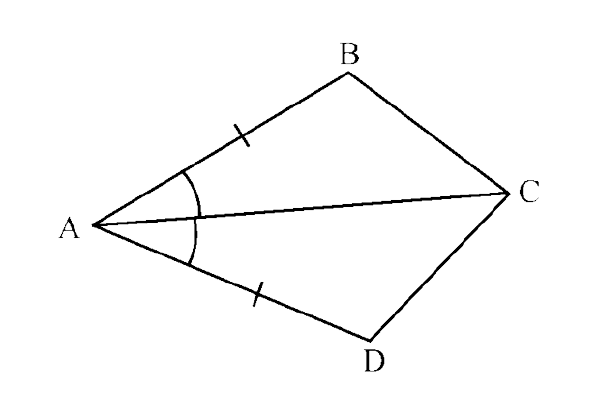
Then
(i) $\triangle$ ________ ≅ $\triangle$ABC.
Ans: ADC
In $\triangle$ABC and $\triangle$ADC,
AC = AC (common)
$\angle$ BAC = $\angle$ DAC (given)
AB = AD (given)
∴ $\triangle$ABC ≅ $\triangle$ADC (By SAS criterion)
(ii) BC = ________
Ans: DC
Since $\triangle$ABC ≅ $\triangle$ADC,
∴ BC = DC (By C.P.C.T.)
(iii) $\angle$ BCA = ________
Ans: $\angle$ DCA
Since $\triangle$ABC ≅ $\triangle$ADC,
∴ $\angle$ BCA = $\angle$ DCA (By C.P.C.T.)
(iv) Line segment AC bisects ________ and ________
Ans: $\angle$ BAD, $\angle$ BCD
Since $\angle$ BAC = $\angle$ DAC (given),
∴ Line segment AC bisects $\angle$ BAD and $\angle$ BCD.
69. In the given figure,
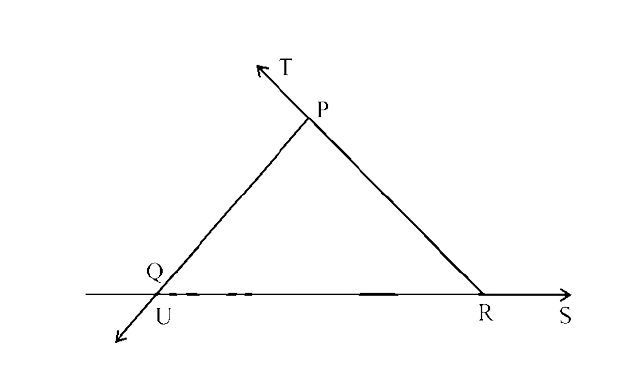
(i) $\angle$ TPQ = $\angle$ ______ + $\angle$ _______
Ans: PQR, PRQ
$\angle$ TPQ = $\angle$ PQR + $\angle$ PRQ (By exterior angle property)
(ii) $\angle$ UQR = $\angle$ ______ + $\angle$ ______
Ans: QPR, QRP
$\angle$ UQR = $\angle$ QPR + $\angle$ QRP (By exterior angle property)
(iii) $\angle$ PRS = $\angle$ ______ + $\angle$ _______
Ans: RPQ, RQP
$\angle$ PRS = $\angle$ RPQ + $\angle$ ROP (By exterior angle property)
Directions: In questions 70 to 106 state whether the statements are True or
False.
70. In a triangle, sum of squares of two sides is equal to the square of the third
side.
Ans: False
Since, in a right-angled triangle, sum of squares of two sides is equal to the square
of the third side.
71. Sum of two sides of a triangle is greater than or equal to the third side.
Ans: False
Since, the sum of two sides of a triangle is greater than the third side.
72. The difference between the lengths of any two sides of a triangle is smaller than the length of the third side.
Ans: True
73. In $\triangle$ABC, AB = 3.5 cm, AC = 5 cm, BC = 6 cm and in $\triangle$POR, PR = 3.5 cm,
PQ = 5 cm, RQ = 6 cm. Then $\triangle$ABC ≅ $\triangle$PQR.
Ans: False
In $\triangle$ ABC and $\triangle$POR,
AB = PR = 3.5 cm
AC = PQ = 5 cm
BC = RO = 6 cm
∴ $\triangle$ ABC ≅ $\triangle$ PRQ (By SSS congruency)
74. Sum of any two angles of a triangle is always greater than the third angle.
Ans: False
Since, sum of any two angles of a triangle is may or may not be greater than the third
angle.
75. The sum of the measures of three angles of a triangle is greater than $180^\circ$
Ans: False
Since, the sum of the measures of three angles of a triangle is equal to $180^\circ$
76. It is possible to have a right-angled equilateral triangle.
Ans: False
Since, an equilateral triangle cannot be a right-angled triangle.
77. If M is the midpoint of a line segment AB, then we can say that AM and MB are congruent.
Ans: True
Since, M is midpoint of AB.
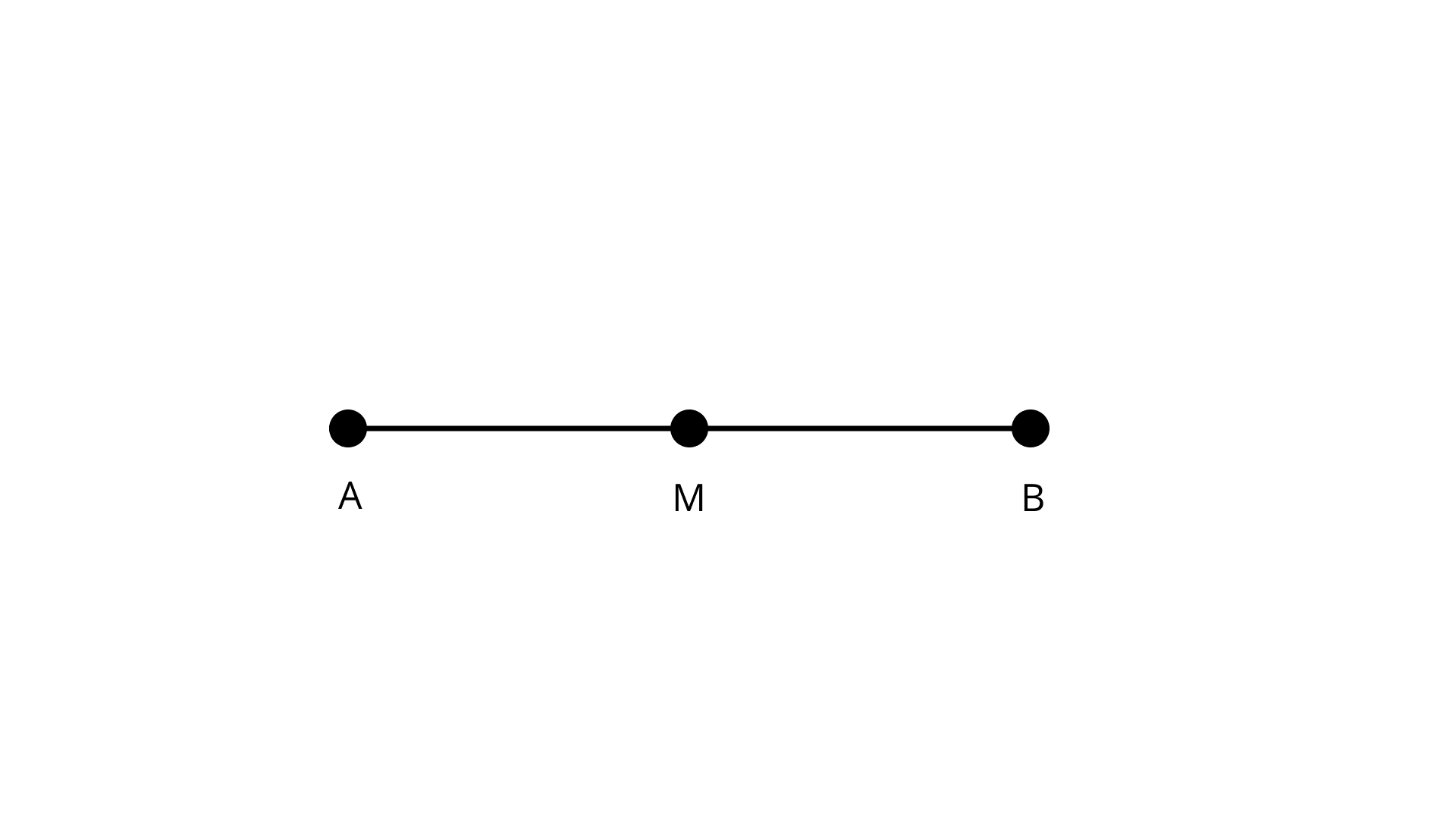
$\Rightarrow$ AM = MB
78. It is possible to have a triangle in which two of the angles are right angles.
Ans: False
Not more than one right- angle is possible in a triangle.
79. It is possible to have a triangle in which two of the angles are obtuse.
Ans: False
$\angle$ A + $\angle$ B + $\angle$ C = $180^\circ$ (By angle sum property)
If a triangle has two obtuse angles, then the sum of all the 3 interior angles will not be equal to $180^\circ$.
Thus, a triangle is not possible.
80. It is possible to have a triangle in which two angles are acute.
Ans: True
81. It is possible to have a triangle in which each angle is less than $60^\circ$
Ans: False
If all angles of a triangle are less than $60^\circ$, then their sum will be less than $180^\circ$. But
in a triangle sum of all angles is $180^\circ$.
∴ Triangle is not possible.
82. It is possible to have a triangle in which each angle is greater than $60^\circ$
Ans: False
If all angles of a triangle are greater than $60^\circ$, then their sum will be greater than
$180^\circ$. But in a triangle sum of all angles is $180^\circ$.
Since the sum of the angles of a triangle is always $180^\circ$, such a triangle is not possible.
83. It is possible to have a triangle in which each angle is equal to $60^\circ$
Ans: True
Since in an equilateral triangle each angle is equal to $60^\circ$.
84. A right-angled triangle may have all sides equal.
Ans: False
A right-angled triangle may have two sides equal.
85. If two angles of a triangle are equal, the third angle is also equal to each of
the other two angles.
Ans: False
If two angles of a triangle are equal then third angle may or may not be equal to each
of the other two angles.
86. In the given figure, two triangles are congruent by RHS.
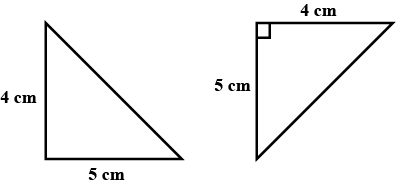
Ans: False
Since, given triangles are congruent by SAS.
87. The congruent figures superimpose each other completely.
Ans: True
88. A one-rupee coin is congruent to a five-rupee coin.
Ans: False
Since one-rupee coin and five-rupee coin are of different size, they are not congruent.
89. The top and bottom faces of a kaleidoscope are congruent.
Ans: True
90. Two acute angles are congruent.
Ans: False
Since, two acute angles may vary from 0° to 89°. So, two acute angles of different
measures are not congruent.
91. Two right angles are congruent.
Ans: True
92. Two figures are congruent, if they have the same shape.
Ans: False
Since, two figures are congruent, if they have the same shape and same size.
93. If the areas of two squares is same, they are congruent.
Ans: True
94. If the areas of two rectangles are the same, they are congruent.
Ans: False
95. If the areas of two circles are the same, they are congruent.
Ans: True
96. Two squares having the same perimeter are congruent.
Ans: True
97. Two circles having the same circumference are congruent.
Ans: True
98. If three angles of two triangles are equal, triangles are congruent.
Ans: False
Since, there is no congruency criterion of three angles.
99. If two legs of a right triangle are equal to two legs of another right triangle,
then the right triangles are congruent.
Ans: True
100. If two sides and one angle of a triangle are equal to the two sides and angle
of another triangle, then the two triangles are congruent.
Ans: False
Two triangles are congruent if two sides and included angle of one triangle are equal
to the two sides and included angle of another triangle.
101. If two triangles are congruent, then the corresponding angles are equal.
Ans: True
102. If two angles and a side of a triangle are equal to two angles and a side of
another triangle, then the triangles are congruent.
Ans: False
If two angles and included side of a triangle are equal to two corresponding angles
and the included side of another triangle, then the triangles are congruent.
103. If the hypotenuse of one right triangle is equal to the hypotenuse of another
right triangle, then the triangles are congruent.
Ans: False
Since, two right triangles are congruent, if hypotenuse and one side of a triangle are
equal to hypotenuse and one side of another triangle.
104. If the hypotenuse and an acute angle of one right triangle are equal to the hypotenuse and an acute angle of another right triangle, then the triangles are congruent.
Ans: True
When hypotenuse and an acute angle of one right triangle are equal to the hypotenuse
and an acute angle of another right triangle, it may be converted it into ‘two angles
and the included side’ form of congruence with the help of angle sum property.
105. AAS congruence criterion is same as ASA congruence criterion.
Ans: False
106. In the given figure, AD ⊥ BC and AD is the bisector of angle BAC. Then,
$\triangle$ABD ≅ $\triangle$ACD by RHS.
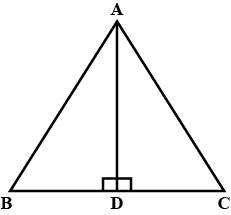
Ans: False
In $\triangle$ABD and $\triangle$ACD,
AD = AD (common)
$\angle$ BAD = $\angle$ CAD (∵ AD is the bisector of $\angle$ BAC)
$\angle$ ADB = $\angle$ ADC (each angle is $90^\circ$, ∵ AD ⊥ BC)
∴ $\triangle$ABD ≅ $\triangle$ACD (By ASA criterion)
107. The measure of three angles of a triangle are in the ratio 5 : 3 : 1. Find the
measures of these angles.
Ans: Let the angles of the triangle be 5x, 3x and x.
∴ x + 3x + 5x = $180^\circ$ (Angle sum property of a triangle)
$\Rightarrow 9{\text{x }} = {\text{ }}180^\circ$
$\Rightarrow {\text{x }} = \frac{{180^\circ }}{9}$
$\Rightarrow {\text{x }} = 20^\circ$
Thus,
3x = 3 × $20^\circ$ = $60^\circ$
5x = 5 × $20^\circ$ = $100^\circ$
Thus, angles of the triangle are $100^\circ$, $60^\circ$ and $20^\circ$.
108. In the given figure, find the value of x.
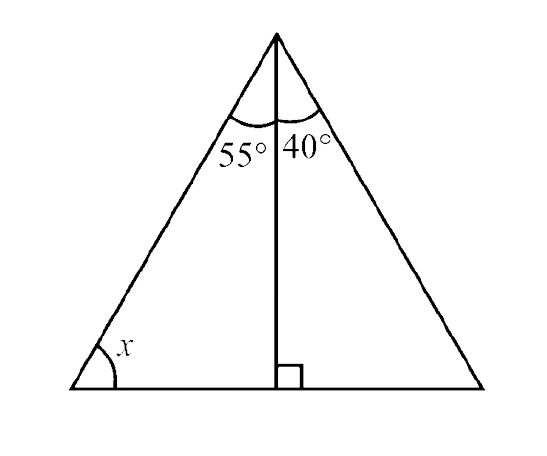
Ans:
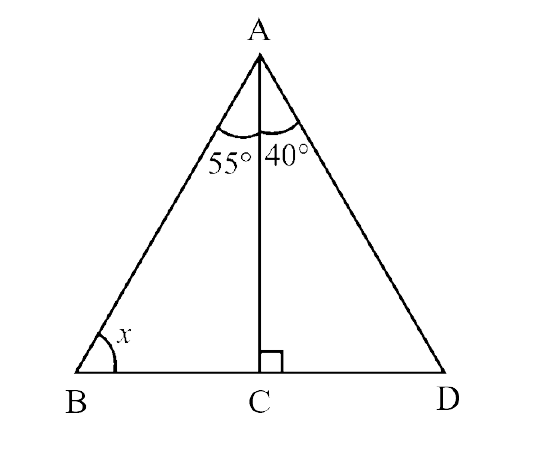
In $\triangle$ABC,
$\angle$ ACD = $\angle$ BAC + $\angle$ ABC (Exterior angle property)
$\Rightarrow$ $90^\circ$ = $55^\circ$ + x
$\Rightarrow$ x = $90^\circ$ – $55^\circ$ = $35^\circ$
Thus,
x = $35^\circ$
109. In the given figure (i) and (ii), find the values of a, b and c.
(i)
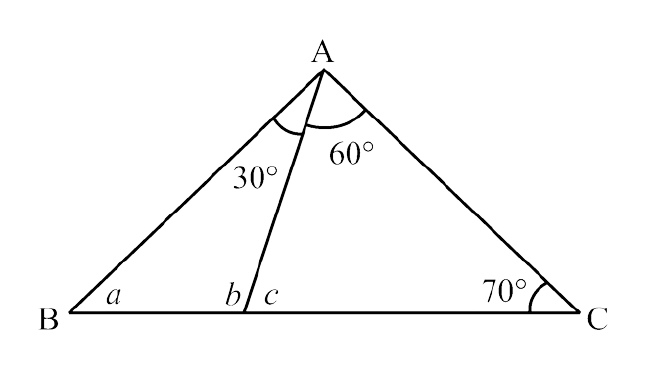
Ans: In $\triangle$ADC,
$\angle$ ADB = $\angle$ DAC+ $\angle$ ACD (By exterior angle property)
$\Rightarrow$ b = $60^\circ$ +$70^\circ$ = 1$30^\circ$ …………(i)
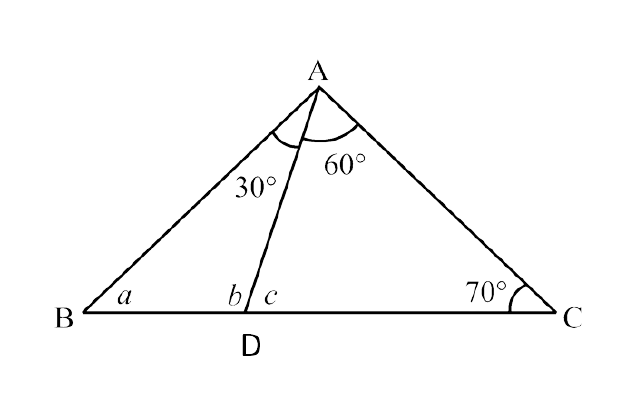
Now,
In $\triangle$ABD,
$\angle$ ABD + $\angle$ ADB + $\angle$ BAD = $180^\circ$ (By angle sum property)
$\Rightarrow$ a + b + $30^\circ$ = $180^\circ$
$\Rightarrow$ a = $180^\circ$ – $30^\circ$ – 1$30^\circ$ (using equation (i))
$\Rightarrow$ a = $20^\circ$ ………(ii)
Also,
$\angle$ ADC = $\angle$ BAD + $\angle$ ABD (By exterior angle property)
$\Rightarrow$ c = $30^\circ$ + a
$\Rightarrow$ c = $30^\circ$ + $20^\circ$ = $50^\circ$ (using equation(ii))
Thus,
a = $20^\circ$, b = 1$30^\circ$, c = $50^\circ$
(ii)
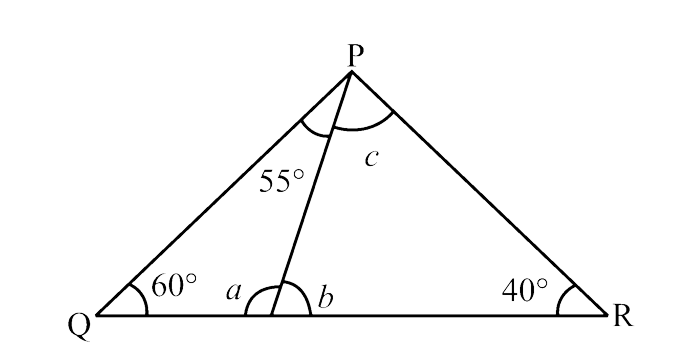
Ans: In $\triangle$PQS,
$\angle$ PSR = $\angle$ SPQ + $\angle$ PQS (By exterior angle property)
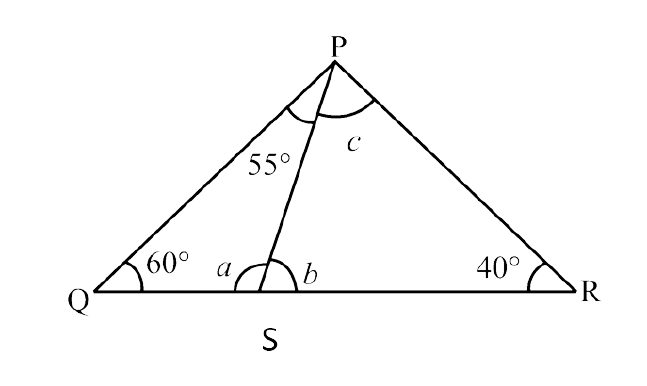
$\Rightarrow$ b = $55^\circ$ + $60^\circ$
$\Rightarrow$ b = 115° …………. (i)
Now,
In $\triangle$PRS,
$\angle$ PSR + $\angle$ PRS + $\angle$ SPR = $180^\circ$ (By angle sum property)
$\Rightarrow$ b + $40^\circ$ + c = $180^\circ$
$\Rightarrow$ c = $180^\circ$ – $40^\circ$ – 115° (using equation (i))
$\Rightarrow$ c = $25^\circ$ ………. (ii)
Also,
$\angle$ PSQ = $\angle$ SPR + $\angle$ SRP (By exterior angle property)
$\Rightarrow$ a = c + $40^\circ$
$\Rightarrow$ a = $25^\circ$ + $40^\circ$ = 65° (using (ii))
Thus, a = 65°, b = 115°, c = $25^\circ$.
110. In triangle XYZ, the measure of angle X is $30^\circ$ greater than the measure
of angle Y and angle Z is a right angle. Find the measure of $\angle$ Y.
Ans: Given that
$\angle$ X = $\angle$ Y + $40^\circ$ ………. (i)
$\angle$ Z = $90^\circ$ ………. (ii)
In $\triangle$XYZ,
$\angle$ X + $\angle$ Y+ $\angle$ Z = $180^\circ$ (Angle sum property)
$\Rightarrow$ $\angle$ Y + $30^\circ$ + $\angle$ Y + $90^\circ$ = $180^\circ$ (Using (i) and (ii))
$\Rightarrow$ 2 $\angle$ Y = $180^\circ$ – $90^\circ$ – $30^\circ$ = $60^\circ$
\[\Rightarrow \angle Y = \frac{{60^\circ }}{2} = 30^\circ \]
111. In a triangle ABC, the measure of angle A is $40^\circ$ less than the measure of angle B and 50% less than that of angle C. Find the measure of $\angle$ A.
Ans: Given that $\angle$ A = $\angle$ B – $40^\circ$ …………. (i)
and $\angle$ A = $\angle$ C – $50^\circ$ …………..(ii)
Now, in $\triangle$ABC
$\angle$ A + $\angle$ B + $\angle$ C = $180^\circ$ (By angle sum property)
$\Rightarrow$ $\angle$ A + $\angle$ A + $40^\circ$ + $\angle$ A + $50^\circ$ = $180^\circ$ (Using equation (i) and (ii))
$\Rightarrow$ 3 $\angle$ A + $90^\circ$ = $180^\circ$
$\Rightarrow 3\angle {\text{A }} = {\text{ }}180^\circ -90^\circ = {\text{ }}90^\circ$
$\Rightarrow \angle {\text{A}} = {\text{ }}\frac{{90^\circ }}{3}$
$\Rightarrow \angle {\text{A}} = 30^\circ$
112. I have three sides. One of my angle measures 15°. Another has a measure
of $60^\circ$. What kind of a polygon am I? If I am a triangle, then what kind of
triangle am I?
Ans: A polygon having three sides is a triangle.
Given that the two angles are of measure 15° and $60^\circ$
Let the third angle of the triangle be x.
∴ 15° + $60^\circ$ + x = $180^\circ$ (By angle sum property of a triangle)
$\Rightarrow$ x = $180^\circ$ – $60^\circ$ – 15°
$\Rightarrow$ x = 105°
Thus, one angle of the triangle is an obtuse angle.
So, a triangle is an obtuse-angled triangle.
113. Jiya walks 6 km due east and then 8 km due north. How far is she from
her starting place?
Ans: Let A be the starting point and B be the ending point of Jiya.
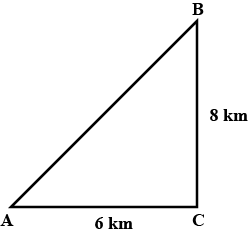
Since $\triangle$ABC is right angled.
∴ (AB)2 = (AC)2 + (BC)2
$\Rightarrow$ (AB)2 = 62 + 82 = 36 + 64 = 100
$\Rightarrow$ AB = 10
Thus, Jiya is 10 km away from her starting place.
114. Jayanti takes shortest route to her home by walking diagonally across a
rectangular park. The park measures 60 metres × 80 metres. How much shorter
Is the route across the park better than the route around its edges?
Ans: Let $\triangle$BCD be the given rectangular park.
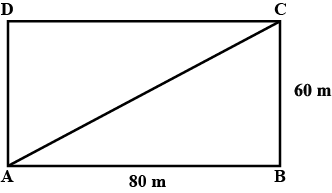
Since, $\triangle$ABC is right angled.
∴ (AC)2 = (AB)2 + (BC)2
$\Rightarrow$ (AC)2 = (80)2 + (60)2 = 6400 + 3600 = 10000
$\Rightarrow$ AC = 100 .
∴ Length of route across the park = 100 m
And length of route around the edges = (80 + 60) m = 140 m
Thus, the route across the park is shorter than the route around edges of park by
140 m – 100 m = 40 m.
115. In the $\triangle$PQR of the given figure, PQ = PR. Find the measures of $\angle$ Q and $\angle$ R.
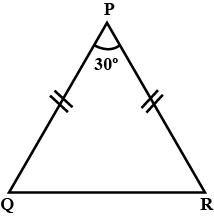
Ans: $\angle$ PRQ = $\angle$ PQR (∵ PQ = PR (given))
Now, in $\triangle$PQR
$\angle$ PQR + $\angle$ PRQ+ $\angle$ QPR = $180^\circ$ (Angle sum property)
$\Rightarrow$ 2 $\angle$ PQR + $30^\circ$ = $180^\circ$ (using (i))
$\Rightarrow$ 2 $\angle$ PQR = $180^\circ$ – $30^\circ$ = 1$50^\circ$
\[\Rightarrow \angle {\text{PQR}} = \frac{{150^\circ }}{2} = 75^\circ \]
Thus, $\angle$ Q = $\angle$ R = $75^\circ$.
116. In the given figure, find the measures of angles x and y.
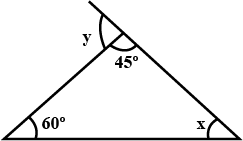
Ans:
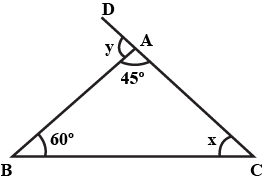
In $\triangle$ABC,
$\angle$ BAC + $\angle$ ABC + $\angle$ ACB = $180^\circ$ (Angle sum property)
$\Rightarrow$ $45^\circ$ + $60^\circ$ + x = $180^\circ$
$\Rightarrow$ x = $180^\circ$ – $45^\circ$ – $60^\circ$ = $75^\circ$ ……………. (i)
Now,
$\angle$ BAD = $\angle$ ABC + $\angle$ ACB (By exterior angle property)
$\Rightarrow$ y = $60^\circ$ + x
$\Rightarrow$ y = $60^\circ$ + $75^\circ$ = 1$35^\circ$ (using equation (i))
Thus, x = $75^\circ$ and y = 1$35^\circ$
117. In the given figure, find the measures of $\angle$ PON and $\angle$ NPO.
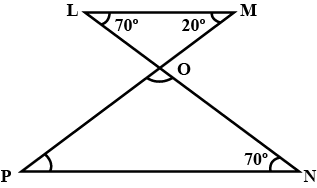
Ans: In $\triangle$LOM,
$\angle$ LOM + $\angle$ OLM+ $\angle$ OML = $180^\circ$ (By angle sum property)
$\Rightarrow$ $\angle$ LOM + $70^\circ$ + $20^\circ$ = $180^\circ$
$\Rightarrow$ $\angle$ LOM = $180^\circ$ – $70^\circ$ – $20^\circ$ = $90^\circ$
$\angle$ LOM = $\angle$ PON (Vertically opposite angles)
∴ $\angle$ PON = $90^\circ$
Now, in $\triangle$ΡΟΝ,
$\angle$ PON + $\angle$ ONP + $\angle$ NPO = $180^\circ$ (Angle sum property)
$\Rightarrow$ $90^\circ$ + $70^\circ$ + $\angle$ NPO = $180^\circ$
$\Rightarrow$ $\angle$ NPO = $180^\circ$ – $90^\circ$ – $70^\circ$ = $20^\circ$
Thus, $\angle$ PON = $90^\circ$ and $\angle$ NPO = $20^\circ$
118. In the given figure QP || RT. Find the values of x and y.
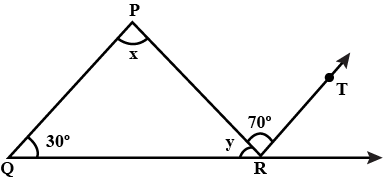
Ans: QP || RT and PR is a transversal.
∴ $\angle$ QPR = $\angle$ PRT (Alternate interior angles)
$\Rightarrow$ x = $70^\circ$
Now, OP || RT and OR is a transversal.
∴ $\angle$ PQR + $\angle$ QRT = $180^\circ$ (Co-interior angles)
$\Rightarrow$ $30^\circ$ + y + $70^\circ$ = $180^\circ$
$\Rightarrow$ y = $180^\circ$ – $30^\circ$ – $70^\circ$ = $80^\circ$
Thus, a = $70^\circ$ and y = $80^\circ$,
119. Find the measure of $\angle$ A in the given figure.
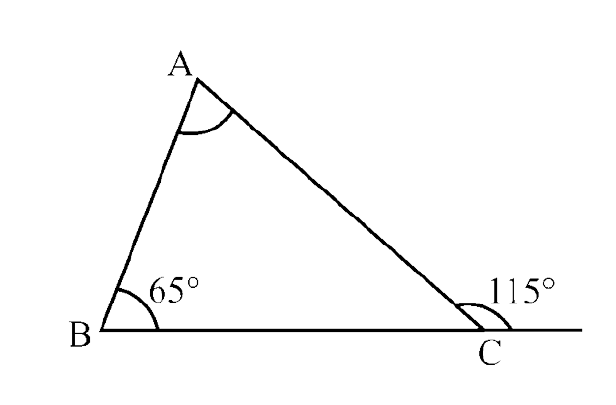
Ans:

$\angle$ ACD = $\angle$ ABC + $\angle$ CAB (By exterior angle property)
$\Rightarrow$ 115° = 65° + $\angle$ CAB
$\Rightarrow$ $\angle$ CAB = 115° – 65°= $50^\circ$
Thus, $\angle$ A = $50^\circ$
120. In a right-angled triangle if an angle measures $35^\circ$, then find the measure
of the third angle.
Ans: Let $\triangle$ABC be the given triangle such that $\angle$ B = $90^\circ$ and $\angle$ C = $35^\circ$
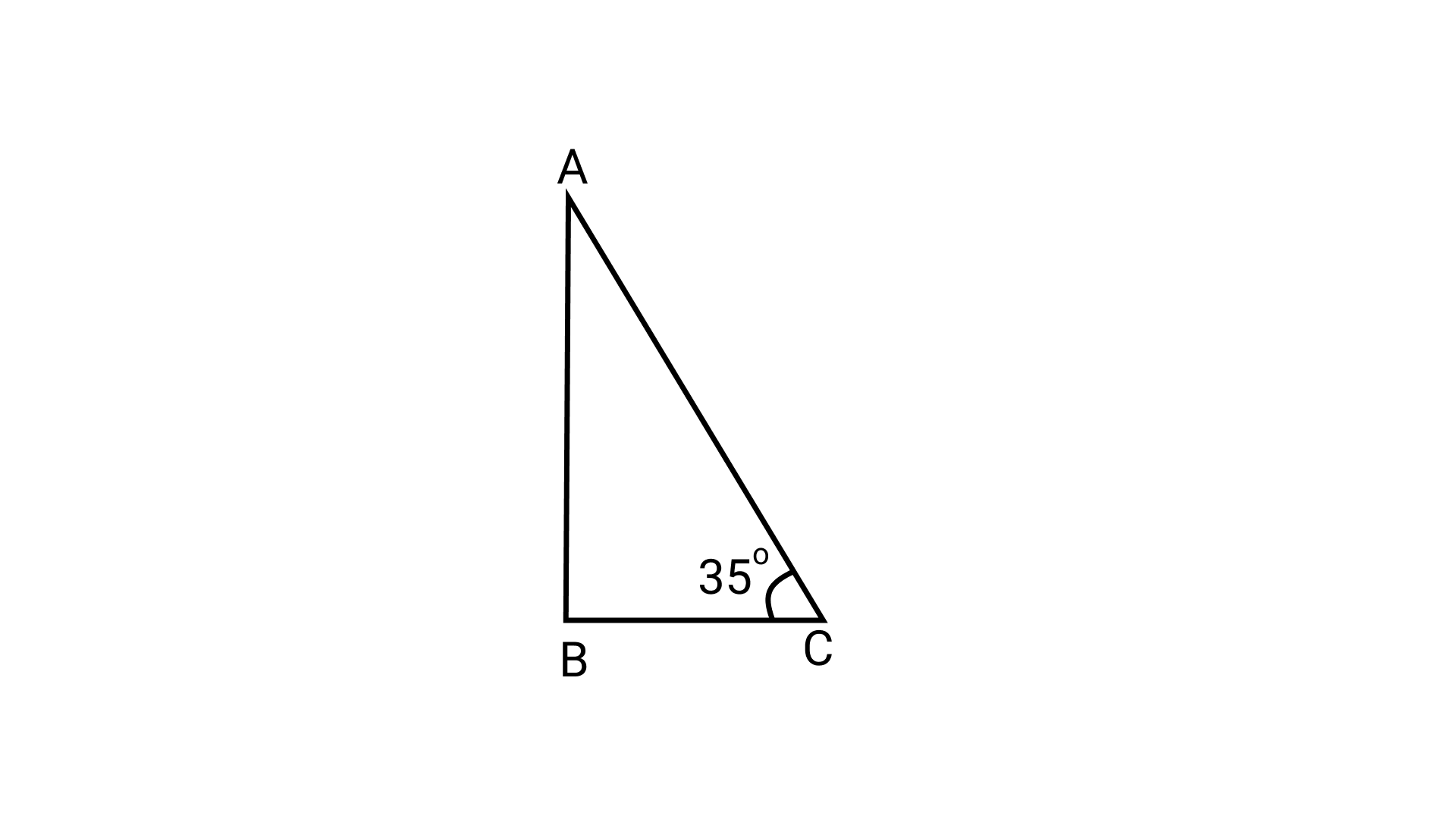
Now,
$\angle$ A + $\angle$ B + $\angle$ C = $180^\circ$ (By angle sum property)
$\Rightarrow$ $\angle$ A = $180^\circ$ – $90^\circ$ – $35^\circ$
$\Rightarrow$ $\angle$ A = $55^\circ$
Thus, the third angle of the triangle is $55^\circ$.
121. Each of the two equal angles of an isosceles triangle is four times the third
angle. Find the angles of the triangle.
Ans: Let $\triangle$ABC be the given isosceles triangle, such that AB = AC and $\angle$ B = $\angle$ C = x.
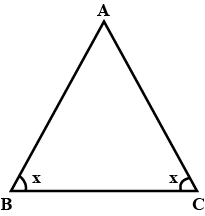
Now, $\angle$ B = $\angle$ C = 4 $\angle$ A ………. (i) (given)
$\angle$ A + $\angle$ B + $\angle$ C = $180^\circ$ (By angle sum property)
$\Rightarrow$ $\angle$ A + 4 $\angle$ A + 4 $\angle$ A = $180^\circ$ (Using equation (i))
$\Rightarrow 9\angle A{\text{ }} = {\text{ }}180^\circ$
$\Rightarrow \angle A = \frac{{180^\circ }}{9} = 20^\circ$
∴ $\angle$ B = $\angle$ C = 4 × $20^\circ$ = $80^\circ$
Thus, $20^\circ$, $80^\circ$ and $80^\circ$ are the angles of the triangle.
122. The angles of a triangle are in the ratio 2 : 3 : 5. Find the angles.
Ans: Let the angles of the triangle be 2x, 3x and 5x.
∴ 2x + 3x + 5x = $180^\circ$ (Angle sum property of a triangle)
$\Rightarrow 10x{\text{ }} = {\text{ }}180^\circ$
$\Rightarrow x = \frac{{180^\circ }}{{10}} = 18^\circ$
∴ 2x = 2 × 18° = 36°,
3x = 3 × 18° = 54°,
5x = 5 × 18°= $90^\circ$
Thus, 36°, 54° and $90^\circ$are the angles of the triangle.
123. If the sides of a triangle are produced in an order, show that the sum of the
exterior angles so formed is 3$60^\circ$.
Ans: Let $\triangle$ABC be the given triangle and BD, CE, AF are the produced side in order
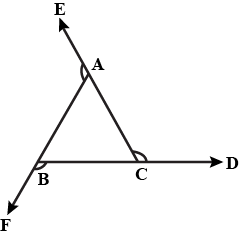
By exterior angle property,
$\angle$ ACD = $\angle$ CAB + $\angle$ CBA ………. (i)
$\angle$ BAE = $\angle$ ABC + $\angle$ ACB ……… (ii)
$\angle$ CBF = $\angle$ BAC + $\angle$ BCA ……….(iii)
Add equations (i), (ii) and (iii),
$\angle$ ACD + $\angle$ BAE + $\angle$ CBF = $\angle$ CAB + $\angle$ CBA + $\angle$ ABC + $\angle$ ACB + $\angle$ BAC + $\angle$ BCA
So,
$\angle ACD{\text{ }} + \angle BAE{\text{ }} + \angle CBF{\text{ }} = {\text{ }}2(\angle ABC{\text{ }} + \angle ACB{\text{ }} + \angle BAC)$
$= {\text{ }}2(180^\circ ){\text{ }}\left( {{\text{Angle sum property}}} \right)$
$= {\text{ }}360^\circ$
124. In $\triangle$ABC, if $\angle$ A = $\angle$ C, and exterior angle ABX = 1$40^\circ$, then find the angles
of the triangle.
Ans: $\angle$ ABX= $\angle$ BAC + $\angle$ BCA (Exterior angle property)
$\Rightarrow$ 1$40^\circ$ = 2 $\angle$ BAC (∵ $\angle$ A = $\angle$ C)
\[\angle BAC = \frac{{140^\circ }}{2} = 70^\circ \]
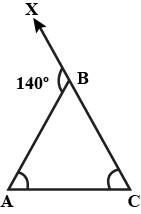
∴ BAC = $\angle$ BCA = $70^\circ$ ……… (i)
Now, in $\triangle$ABC
$\angle$ A + $\angle$ B + $\angle$ C = $180^\circ$ (Angle sum property)
$\Rightarrow$ $\angle$ B = $180^\circ$ – $70^\circ$ – $70^\circ$ (Using equation (i))
$\Rightarrow$ $\angle$ B = $40^\circ$
Thus, $\angle$ A = $70^\circ$, $\angle$ B = $40^\circ$ and $\angle$ C = $70^\circ$ are the angles of the triangle.
125. Find the values of x and y in the given figure.
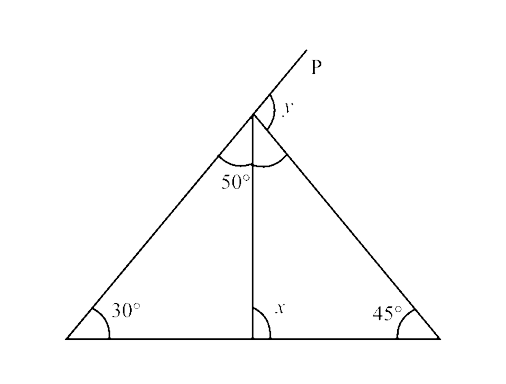
Ans: In $\triangle$QRS,
$\angle$ QST = $\angle$ QRS + $\angle$ SOR (Exterior angle property)
$\Rightarrow$ x = $30^\circ$ + $50^\circ$ = $80^\circ$
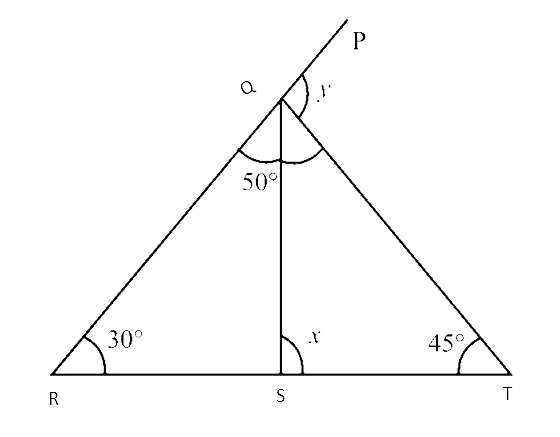
Also, in $\triangle$QRT,
$\angle$ PQT = $\angle$ QRT + $\angle$ QTR (By exterior angle property)
$\Rightarrow$ y = $30^\circ$ + $45^\circ$ = $75^\circ$
Thus, x = $80^\circ$ and y = $75^\circ$
126. Find the value of x in the given figure.
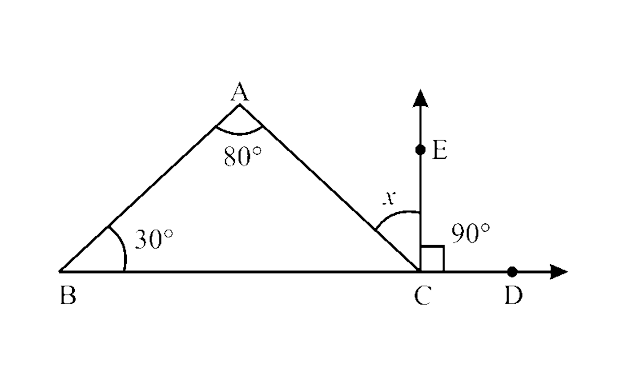
Ans: In $\triangle$ABC,
$\angle$ ACD= $\angle$ CAB + $\angle$ CBA (By exterior angle property)
$\Rightarrow$ x + $90^\circ$ = $80^\circ$ + $30^\circ$
$\Rightarrow$ x = $110^\circ$ – $90^\circ$
$\Rightarrow$ x = $20^\circ$
127. The angles of a triangle are arranged in descending order of their magnitudes. If the difference between two consecutive angles is 10, find the three angles.
Ans: Let $\triangle$ABC be the given triangle and descending order of angles of the triangle
is $\angle$ A, $\angle$ B, $\angle$ C.
Now,
$\angle$ A – $\angle$ B = $10^\circ$ ………. (i)
$\angle$ B – $\angle$ C = $10^\circ$ ………. (ii)
Also,
$\angle$ A + $\angle$ B + $\angle$ C = $180^\circ$ (By angle sum property)
$\Rightarrow$ $\angle$ B + $10^\circ$ + $\angle$ B + $\angle$ B – $10^\circ$ = $180^\circ$ (Using equations (i) and (ii))
$\Rightarrow 3\angle B{\text{ }} = {\text{ }}180^\circ$
$\Rightarrow \angle B = \frac{{180^\circ }}{3}$
$\Rightarrow \angle B = 60^\circ$
Thus,
$\angle$ A = $\angle$ B + $10^\circ$ = $60^\circ$ + $10^\circ$ = $70^\circ$
And
$\angle$ C = $\angle$ B – $10^\circ$ = $60^\circ$ – $10^\circ$ = $50^\circ$
Thus, $70^\circ$, $60^\circ$ and $50^\circ$ are the angles of the triangle.
128. In $\triangle$ABC, DE || BC (see figure). Find the values of x,y and z.
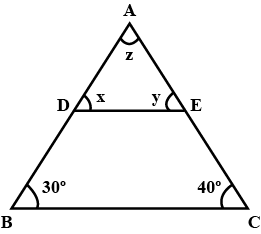
Ans:
DE || BC and AB is a transversal.
∴ $\angle$ ADE = $\angle$ DBC (Corresponding angles)
$\Rightarrow$ x= $30^\circ$
Now, DE || BC and AC is a transversal.
∴ $\angle$ AED = $\angle$ ECB (Corresponding angles)
$\Rightarrow$ y = $40^\circ$
In $\triangle$ABC,
$\angle$ A + $\angle$ B + $\angle$ C = $180^\circ$ (By angle sum property)
$\Rightarrow$ z + $30^\circ$ + $40^\circ$ = $180^\circ$
$\Rightarrow$ z = $180^\circ$ – $40^\circ$ – $30^\circ$ = $110^\circ$
Thus, x = $30^\circ$, y = $40^\circ$ and z = $110^\circ$.
129. In the given figure, find the values of x, y and z.
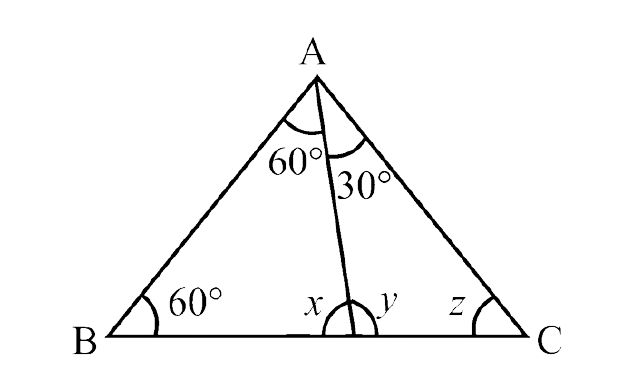
Ans: In $\triangle$ABD,
$\angle$ BAD + $\angle$ BDA + $\angle$ ABD = $180^\circ$ (Angle sum property)

$\Rightarrow$ $60^\circ$ + x + $60^\circ$ = $180^\circ$
$\Rightarrow$ x = $180^\circ$ – $120^\circ$ = $60^\circ$
Now,
$\angle$ ADC = $\angle$ BAD + $\angle$ ABD (By exterior angle property)
$\Rightarrow$ y = $60^\circ$ + $60^\circ$ = $120^\circ$
Also, in $\triangle$ADC,
$\angle$ ADB – $\angle$ DAC + $\angle$ DCA (By Exterior angle property)
$\Rightarrow$ x = $30^\circ$ + z
$\Rightarrow$ z = $60^\circ$ – $30^\circ$ = $30^\circ$ (Since x = $60^\circ$)
Therefore, x = $60^\circ$, y = $120^\circ$ and z = $30^\circ$.
130. If one angle of a triangle is $60^\circ$ and the other two angles are in the ratio 1 :
2, find the angles.
Ans: Let $\triangle$ABC be the given triangle such that $\angle$ A = $60^\circ$ and let angle B and C are
x and 2x respectively.
$\angle$ A + $\angle$ B + $\angle$ C = $180^\circ$ (By angle sum property)
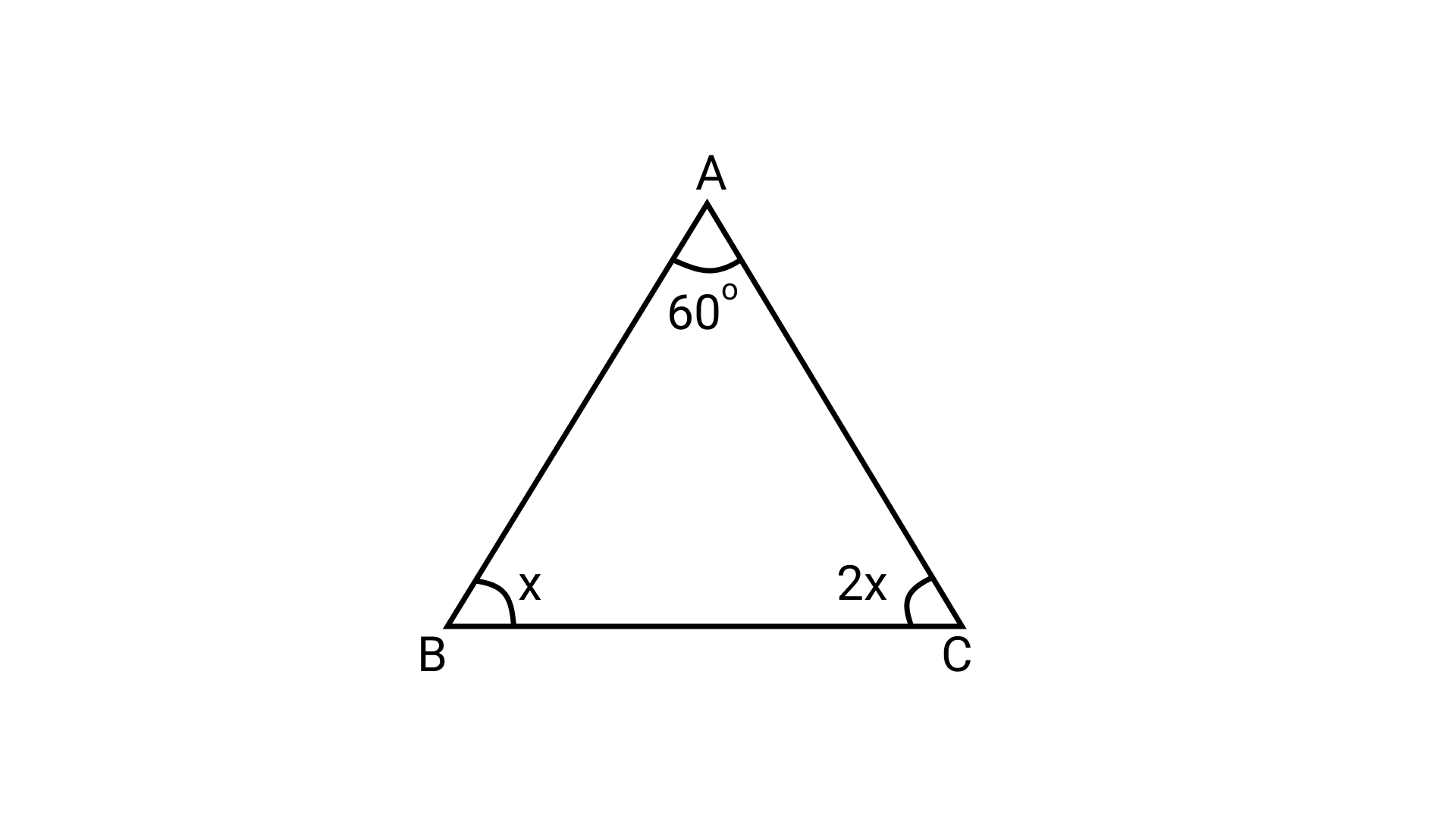
$\Rightarrow 60^\circ + {\text{ }}x{\text{ }} + {\text{ }}2x{\text{ }} = {\text{ }}180^\circ$
$\Rightarrow 3x{\text{ }} = {\text{ }}180^\circ -60^\circ = {\text{ }}120^\circ$
$\Rightarrow x = \frac{{120^\circ }}{3} = 40^\circ$
Therefore, $\angle$ B = $40^\circ$ and $\angle$ C = 2 × $40^\circ$ = $80^\circ$
131. In $\triangle$POR, If 3 $\angle$ P = 4 $\angle$ Q = 6 $\angle$ R, calculate the angles of the triangle.
Ans: $ 3\angle P = 4\angle Q = 6\angle R\left( {{\text{Given}}} \right)$
$\Rightarrow \angle P = \frac{4}{3}\angle Q$
$\Rightarrow \angle R = \frac{4}{6}\angle Q$
$\angle$ P + $\angle$ Q+ $\angle$ R = $180^\circ$ (By angle sum property)
$\Rightarrow \frac{4}{3}\angle Q + \angle Q + \frac{4}{6}\angle Q = 180^\circ$
$\Rightarrow \frac{4}{3}\angle Q + \angle Q + \frac{2}{3}\angle Q = 180^\circ$
$\Rightarrow \frac{9}{3}\angle Q = 180^\circ$
$\Rightarrow 3\angle Q = 180^\circ$
$\Rightarrow \angle Q = \frac{{180^\circ }}{3} = 60^\circ$
So,
$\angle P = \frac{4}{3}\angle Q = \frac{4}{3} \times 60^\circ = 4 \times 20^\circ = 80^\circ$
$\angle R = \frac{4}{6}\angle Q = \frac{4}{6} \times 60^\circ = 4 \times 10^\circ = 40^\circ$
Thus, $\angle$ P = $80^\circ$, $\angle$ Q = $60^\circ$ and $\angle$ R = $40^\circ$.
132. In $\triangle$DEF, $\angle$ D = $60^\circ$, $\angle$ E = $70^\circ$ and the bisectors of $\angle$ E and $\angle$ F meet at O. Find
(i) $\angle$ F
Ans: In $\triangle$DEF,
$\angle$ D + $\angle$ E + $\angle$ F = $180^\circ$ (Angle sum property)
$\Rightarrow$ $60^\circ$ + $70^\circ$ + $\angle$ F = $180^\circ$
$\Rightarrow$ $\angle$ F = $180^\circ$ – $60^\circ$ – $70^\circ$ = $50^\circ$
(ii) $\angle$ EOF
Ans: Since, EO and FO are the bisectors of $\angle$ E and $\angle$ F respectively.
\[\therefore \;\angle OEF = \angle OED = \frac{{70^\circ }}{2} = 35^\circ \]
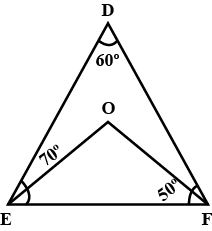
And \[\angle OFE = \angle OFD = \frac{{50^\circ }}{2} = 25^\circ \]
Now, in $\triangle$OEF,
$\angle$ OEF + $\angle$ OFE + $\angle$ EOF = $180^\circ$ (By angle sum property)
$\Rightarrow$ $35^\circ$ + $25^\circ$ + $\angle$ EOF = $180^\circ$
$\Rightarrow$ $\angle$ EOF = $180^\circ$ – $35^\circ$ – $25^\circ$ = $120^\circ$
133. In the given figure, $\triangle$PQR is right-angled at P.U and Tare the points on
line QRF. If OP || ST and US || RP, find $\angle$ S.
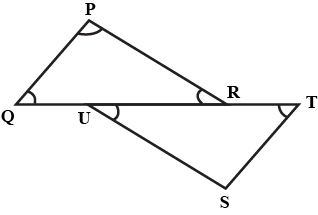
Ans:
QP || ST and QT are transversals.
Therefore, $\angle$ PQT = $\angle$ STO (Alternate interior angles)
US || PR and UR is a transversal.
Therefore, $\angle$ PRU = $\angle$ SUR (Alternate interior angles)
Two angles of $\triangle$PQR equal to two angles of $\triangle$STU.
Thus, the third angle also will be equal.
$\Rightarrow$ $\angle$ QPR = $\angle$ TSU
Now, it is given that $\angle$ P = $90^\circ$.
Hence, $\angle$ S = $90^\circ$.
134. In each of the given pairs of triangles of figure, applying only ASA
congruence criterion, determine which triangles are congruent. Also, write the
congruent triangles in symbolic form.
(a)
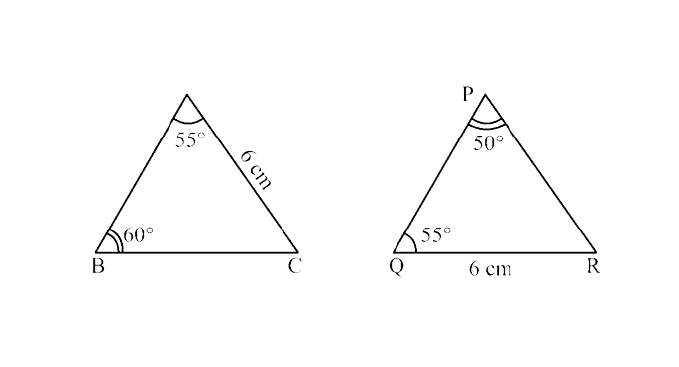
Ans: In the given figure,
$\triangle$ABC and $\triangle$POR are not congruent.
(b)
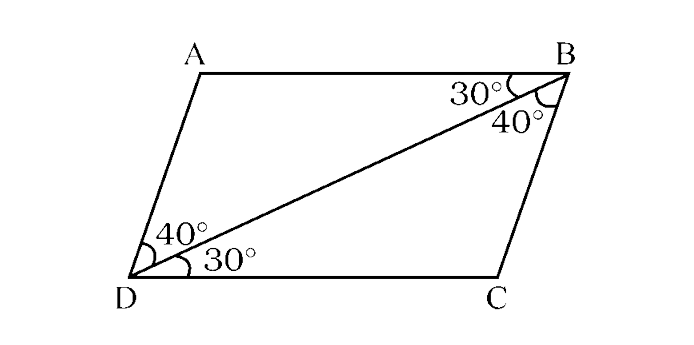
Ans: In $\triangle$ABD and $\triangle$CDB,
BD = DB (common)
$\angle$ ABD = $\angle$ CDB = $30^\circ$ (given)
$\angle$ ADB = $\angle$ CBD = $40^\circ$ (given)
So, $\triangle$ABD ≅ $\triangle$CDB (By ASA criterion)
(c)
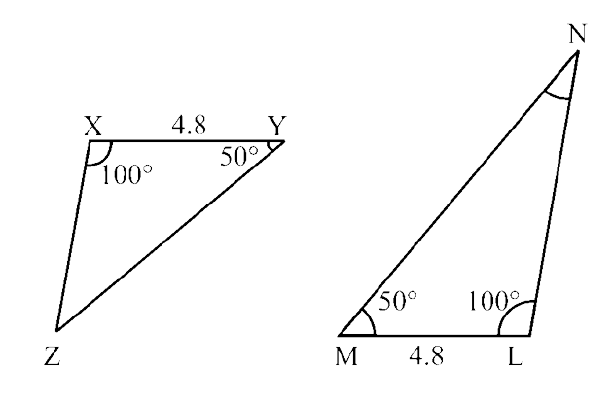
Ans: In $\triangle$XYZ and $\triangle$LMN,
XY = LM = 4.8 (given)
$\angle$ YXZ = $\angle$ MLN – $100^\circ$ (given)
$\angle$ XYZ = LMN = $50^\circ$ (given)
So, $\triangle$XYZ ≅ $\triangle$LMN (By ASA criterion)
(d)
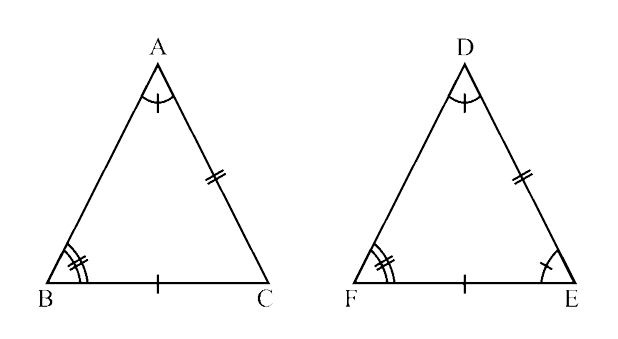
Ans: In $\triangle$ABC and $\triangle$DFE,
$\angle$ A = $\angle$ D (given)
$\angle$ B = $\angle$ F (given)
∴ $\angle$ C = $\angle$ E (since other two angles are equal)
BC = FE (given)
So, $\triangle$ABC ≅ $\triangle$DFE (By ASA criterion)
(e)
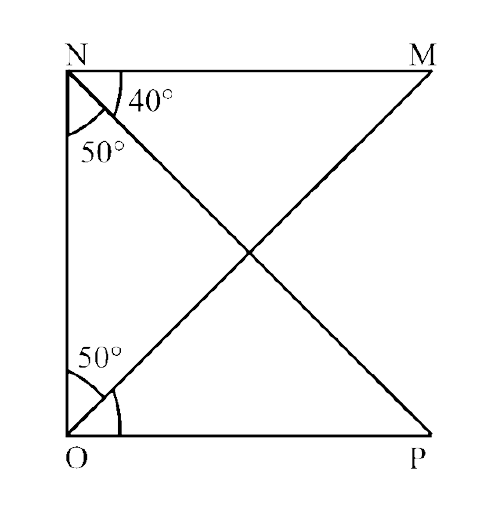
Ans: In $\triangle$PON and $\triangle$MNO,
NO = ON (common)
$\angle$ NOP = $\angle$ ONM = $50^\circ$ + 40 = $90^\circ$ (given)
$\angle$ ONP = $\angle$ NOM = $50^\circ$ (given)
So, $\triangle$PON ≅ $\triangle$MNO (By ASA criterion)
(f)
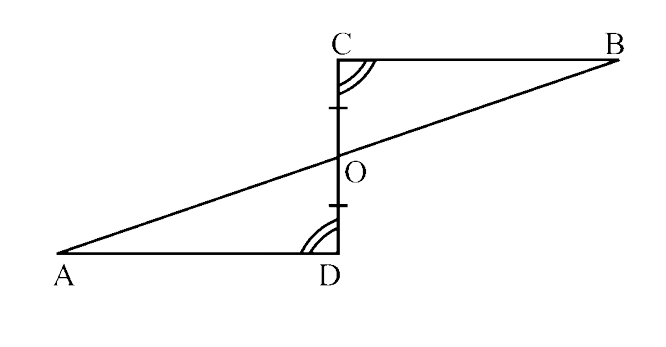
Ans: In $\triangle$AOD and $\triangle$BOC,
$\angle$ AOD = $\angle$ BOC (Vertically opposite angles)
OD = OC (given)
$\angle$ ADO = $\angle$ BCO (given)
So, $\triangle$AOD ≅ $\triangle$BOC (By ASA criterion)
135. In each of the given pairs of triangles of figure, using only RHS congruence
criterion, determine which pairs of triangles are congruent. In case of
congruence, write the result in symbolic form:
(a)
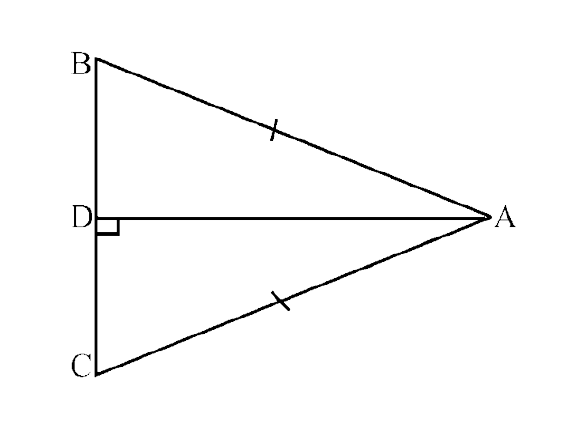
Ans: In $\triangle$ADB and $\triangle$ADC,
AD = AD (common)
$\angle$ ADB = $\angle$ ADC (Each $90^\circ$)
AB = AC (given hypotenuse)
So, $\triangle$ADB ≅ $\triangle$ADC (By RHS criterion)
(b)
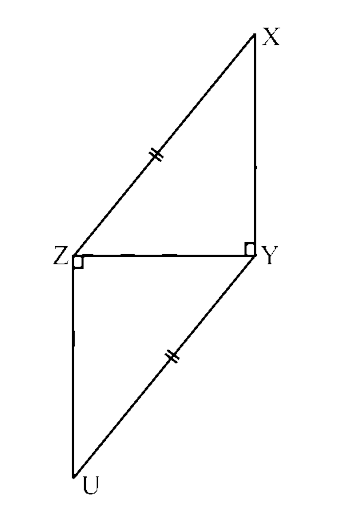
Ans: In $\triangle$XYZ and $\triangle$UZY,
$\angle$ Y = $\angle$ Z (Each $90^\circ$)
XZ = UY (given hypotenuse)
YZ = ZY (common)
So, $\triangle$XYZ ≅ $\triangle$UZY (By RHS criterion)
(c)
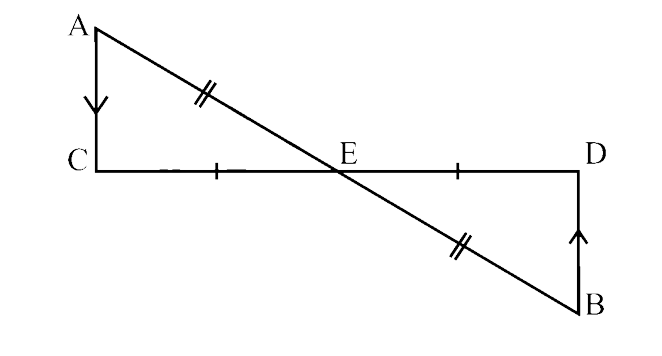
Ans: In $\triangle$ACE and $\triangle$BDE,
$\angle$ ACE = $\angle$ BDE (AC || BD, alternate interior angles)
CE = DE (given)
$\angle$ AEC = $\angle$ BED (Vertically opposite angles)
So, $\triangle$ACE ≅ $\triangle$BDE (By ASA criterion)
Therefore, triangles are congruent but not by RHS congruence criterion.
(d)
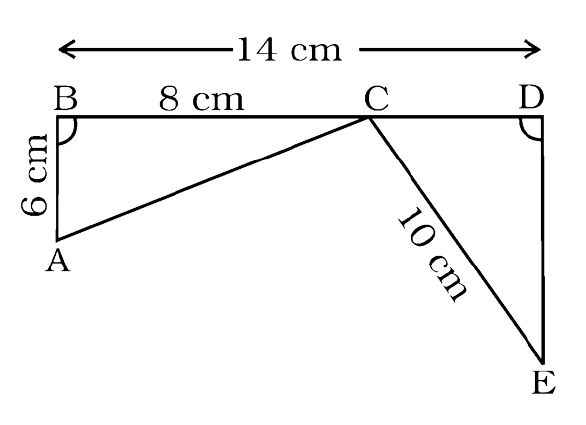
Ans: In $\triangle$ABC,
By Pythagoras theorem
${\left( {AC} \right)^2}\; = {\text{ }}{\left( {AB} \right)^2}\; + {\text{ }}{\left( {BC} \right)^2}$
${\left( {AC} \right)^2} = {\text{ }}{6^2}\; + {\text{ }}{8^2}$
${\left( {AC} \right)^2} = {\text{ }}36{\text{ }} + {\text{ }}64{\text{ }}$
${\left( {AC} \right)^2} = {\text{ }}100{\text{ }}$
$AC = {\text{ }}{10^2}$
$\therefore AC = 10{\text{ cm}}$
In $\triangle$EDC,
DC = BD – BC = (14 – 8) cm = 6cm,
CE = 10 cm
Now,
In $\triangle$ABC and $\triangle$CDE,
$\angle$ B = $\angle$ D (each $90^\circ$)
AB = CD = 6 cm
AC = CE = 10 cm (Hypotenuse)
So, $\triangle$ABC ≅ $\triangle$CDE (By RHS criterion)
(e)
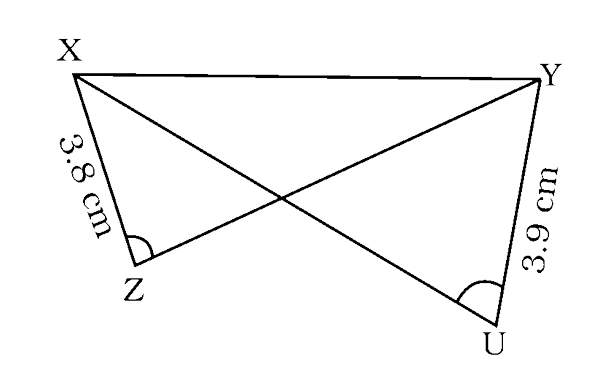
Ans: In the given figure, $\triangle$XYZ and $\triangle$YXU are not congruent by any criterion.
(f)
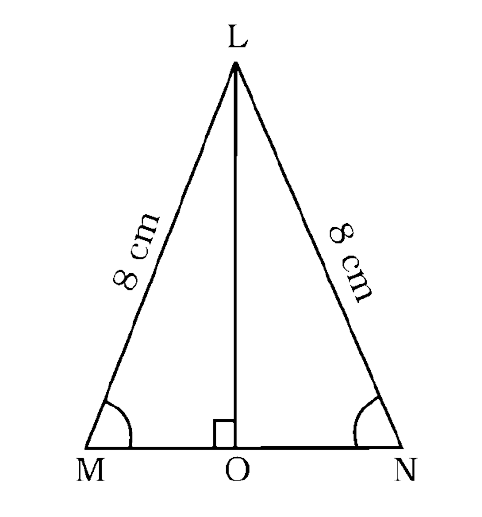
Ans: In $\triangle$LMO and $\triangle$LNO,
LO = LO (common)
LM = LN = 8 cm (hypotenuse)
$\angle$ LOM = $\angle$ LON (each $90^\circ$)
So, $\triangle$LOM ≅ $\triangle$LON (By RHS criterion)
136. In the given figure, if RP=RQ, find the value of x.
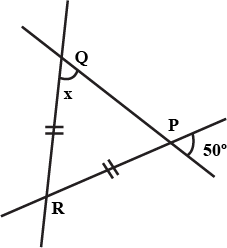
Ans: RP = RQ
∴ $\angle$ RQP = $\angle$ RPQ = x (angles opposite to equal sides are equal)
Now, $\angle$ RPQ = $50^\circ$ (vertically opposite angles)
$\Rightarrow$ x = $50^\circ$
137. In the given figure, if ST = SU, then find the values of x and y.
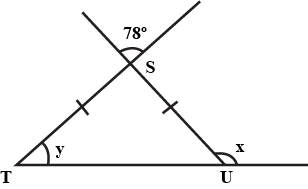
Ans: $\angle$ TSU = $78^\circ$ (vertically opposite angles)
$\angle$ SUT = $\angle$ STU = y (Since ST = SU)
Now, in $\triangle$STU,
$\angle$ STU + $\angle$ SUT + $\angle$ TSU = $180^\circ$ (By angle sum property)
$\Rightarrow y{\text{ }} + {\text{ }}y{\text{ }} + {\text{ }}78^\circ = {\text{ }}180^\circ$
$\Rightarrow 2y{\text{ }} = {\text{ }}180^\circ -78^\circ = {\text{ }}102^\circ$
$\Rightarrow y = \frac{{102^\circ }}{2} = 51^\circ$
Now, x = $\angle$ TSU + $\angle$ UTS (By exterior angle property)
$\Rightarrow$ x = $78^\circ$ + 51°
$\Rightarrow$ x = 129°
Therefore, x = 129° and y = 51°.
138. Check whether the following measures (in cm) can be the sides of a right angled triangle or not. 1.5, 3.6, 3.9
Ans: Here, \[{\left( {1.5} \right)^2}\; + {\text{ }}{\left( {3.6} \right)^2}\; = {\text{ }}2.25{\text{ }} + {\text{ }}12.96{\text{ }} = {\text{ }}15.21\]
And \[{\left( {3.9} \right)^2}\; = {\text{ }}15.21\]
Thus,
\[{\left( {1.5} \right)^2}\; + {\text{ }}{\left( {3.6} \right)^2}\; = {\text{ }}{\left( {3.9} \right)^2}\]
Yes, given sides are sides of a right-angled triangle.
139. Height of a pole is 8 m. Find the length of rope tied with its top from a point on the ground at a distance of 6 m from its bottom.
Ans: Let AB be the given pole of height 8m and rope be AC.
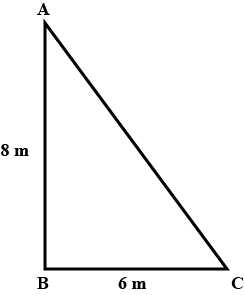
Since, $\triangle$ABC is a right angled triangle.
Use Pythagoras Theorem,
${\left( {AC} \right)^2}\; = {\text{ }}{\left( {AB} \right)^2}\; + {\text{ }}{\left( {BC} \right)^2}$
${\left( {AC} \right)^2}\; = {\text{ }}{8^2}\; + {\text{ }}{6^2}\; = {\text{ }}64{\text{ }} + {\text{ }}36$
${\left( {AC} \right)^2}\; = {\text{ }}100{\text{ }} = {\text{ }}{10^2}$
$\therefore AC{\text{ }} = {\text{ }}10{\text{ m}}$
Thus, the required length of rope is 10 m.
140. In the given figure, if y is five times x, find the value of z.
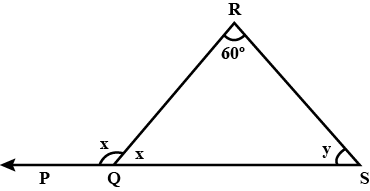
Ans: In $\triangle$QRS,
$\angle$ ROS + $\angle$ RSQ + $\angle$ QRS = $180^\circ$ (Angle sum property)
$\Rightarrow$ x + y + $60^\circ$ = $180^\circ$
$\Rightarrow$ x + 5x = $180^\circ$ – $60^\circ$ (Since y = 5x (given))
$\Rightarrow 6x{\text{ }} = {\text{ }}120^\circ$
$\Rightarrow x = \frac{{120^\circ }}{5} = 20^\circ$
So, y = 5x = 5 × $20^\circ$ – $100^\circ$
Now,
$\angle$ RQP = $\angle$ QRS + $\angle$ QSR (By exterior angle property)
$\Rightarrow$ z = $60^\circ$ + $100^\circ$
$\Rightarrow$ z = 1$60^\circ$
141. The lengths of two sides of an isosceles triangle are 9 cm and 20 cm. What is the perimeter of the triangle? Give a reason.
Ans: Sides of isosceles triangle are 9 cm and 20 cm.
Since, the sum of any two sides of a triangle is greater than the third side.
If third side will be 9 cm then 9 + 9 = 18 < 20
Hence, the triangle will not form.
So, the third side of the triangle must be 20 cm.
Perimeter = (9 + 20 + 20) cm = 49 cm.
142. Without drawing the triangles write all six pairs of equal measures in each of the following pairs of congruent triangles.
(a) $\triangle$STU ≅ $\triangle$DEF
Ans: $\triangle$STU ≅ $\triangle$DEF
ST = DE, TU= LF, SU = DF
$\angle$ STU = $\angle$ DEF, $\angle$ SUT = $\angle$ DFE, $\angle$ TSU = $\angle$ EDF
(b) $\triangle$ABC ≅ $\triangle$LMN
Ans: $\triangle$ABC ≅ $\triangle$LMN
AB = LM, BC = MN, AC = LN
$\angle$ ABC = $\angle$ LMN, $\angle$ ACB = $\angle$ ANM, $\angle$ BAC = $\angle$ MLN
(c) $\triangle$YZX ≅ $\triangle$POR
Ans: $\triangle$YZX ≅ $\triangle$POR
YZ = PQ, ZX = OR, YX = PR
$\angle$ YZX = $\angle$ POR, $\angle$ YXZ = $\angle$ PRO, $\angle$ XYZ = $\angle$ RPQ
(d) $\triangle$XYZ ≅ $\triangle$MLN
Ans: $\triangle$XYZ ≅ $\triangle$MLN
XY = ML, YZ = LN, XZ = MN
$\angle$ XYZ = $\angle$ MLN, $\angle$ XZY = $\angle$ MNL, $\angle$ ZXY = $\angle$ NML.
143. In the following pairs of triangles of figure, the lengths of the sides are
indicated along the sides. By applying SSS congruence criterion, determine
which triangles are congruent. If congruent, write the results in symbolic form.
(a)
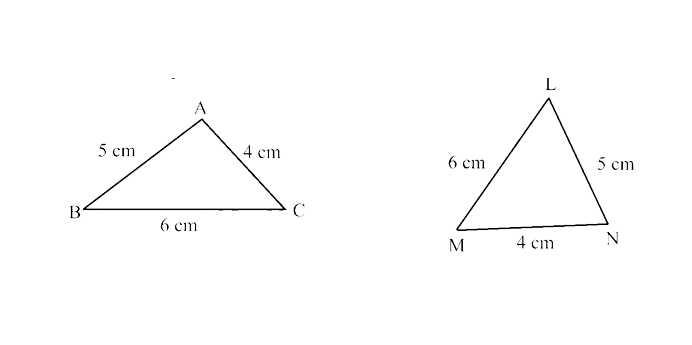
Ans: In $\triangle$ABC and $\triangle$NLM,
AB = NL = 5 cm (given)
BC = LM = 6 cm (given)
AC = NM = 4 cm (given)
∴ $\triangle$ABC ≅ $\triangle$NLM (SSS criterion)
(b)
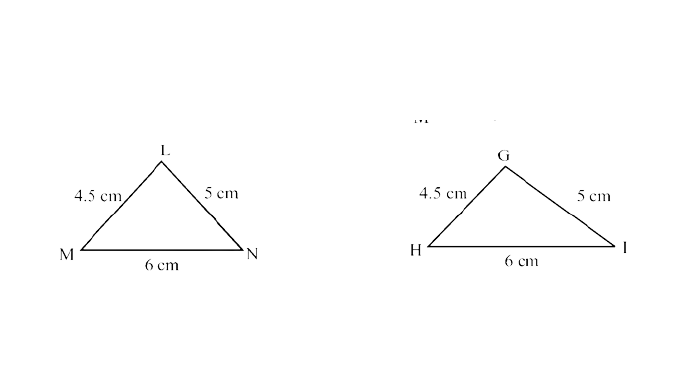
Ans: In $\triangle$LMN and $\triangle$GHI,
LM = GH = 4.5 cm (given)
LN = GI = 5 cm (given)
MN = HI = 6 cm (given)
∴ $\triangle$LMN ≅ $\triangle$GHI (SSS criterion)
(c)
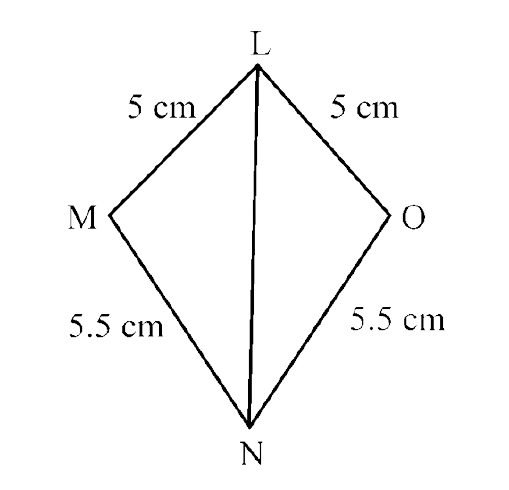
Ans: In $\triangle$LMN and $\triangle$LON,
LM = LO = 5 cm (given)
MN = ON = 5.5 cm (given)
LN = LN (common)
So, $\triangle$LMN ≅ $\triangle$LON (By SSS criterion)
(d)
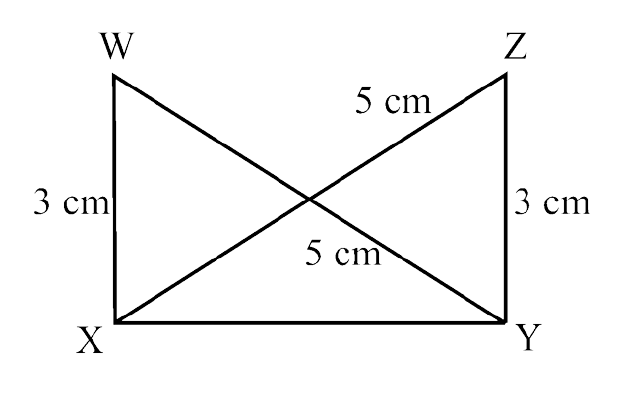
Ans: In $\triangle$XYZ and $\triangle$YXW,
XY = YX (common)
ZY = WX = 3 cm (given)
ZX = WY = 5 cm (given)
So, $\triangle$YXW ≅ $\triangle$XYZ (By SSS criterion)
(e)
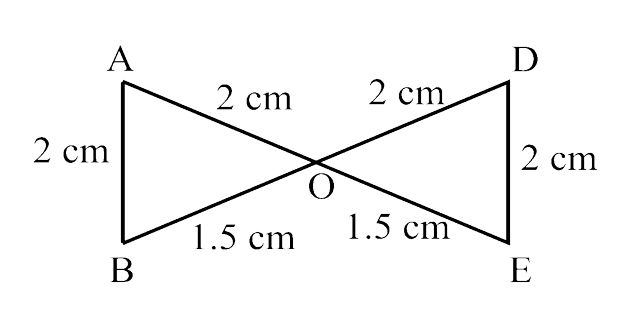
Ans: In $\triangle$AOB and $\triangle$DOE,
AO = DO = 2 cm (given)
AB = DE = 2 cm (given)
BO = EO = 1.5 cm (given)
So, $\triangle$AOB ≅ $\triangle$DOE (By SSS criterion)
(f)
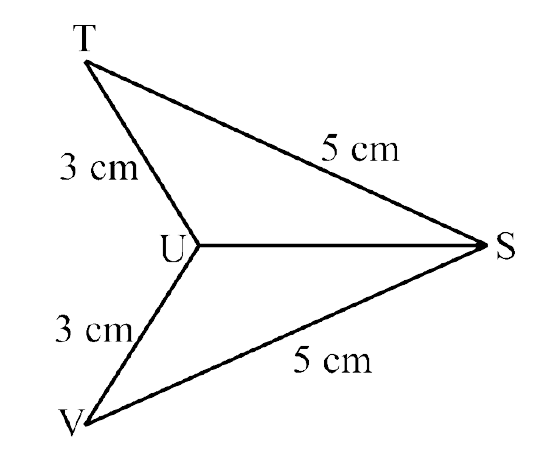
Ans: In $\triangle$STU and $\triangle$SVU,
SU = SU (common)
ST = SV = 5 cm (given)
UT = UV = 3 cm (given)
So, $\triangle$STU ≅ $\triangle$SVU (By SSS criterion)
(g)
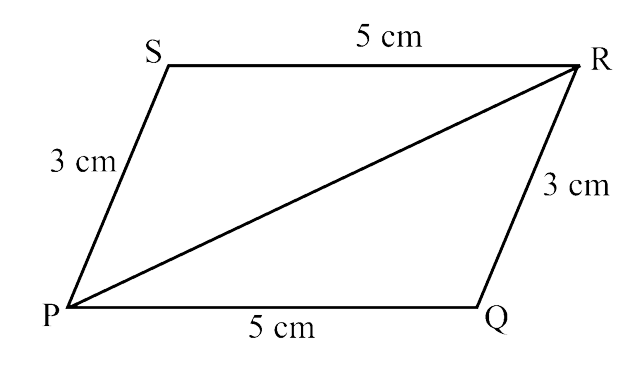
Ans: In $\triangle$PQR and $\triangle$RSP,
PR = RP (common)
PQ = RS = 5 cm (given)
OR = SP = 3 cm (given)
So, $\triangle$PQR ≅ $\triangle$RSP (By SSS criterion)
(h)
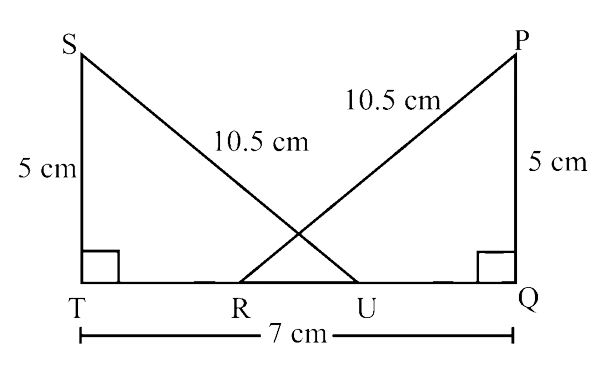
Ans: In $\triangle$STU, by Pythagoras theorem,
TU2 = (10.5)2 – 52 = 135.25
And
In $\triangle$PQR,
QR2 = (10.5)2 – 52 = 135.25
∴ TU2 = QR2
$\Rightarrow$ TU = QR ……. (i)
In $\triangle$STU and $\triangle$POR,
ST = PQ = 5 cm (given)
SU = PR = 10.5 cm (given)
TU = QR (From equation (i).
So, $\triangle$STU ≅ $\triangle$PQR (By SSS criterion)
144. ABC is an isosceles triangle with AB = AC and D is the mid-point of base
BC (see figure).
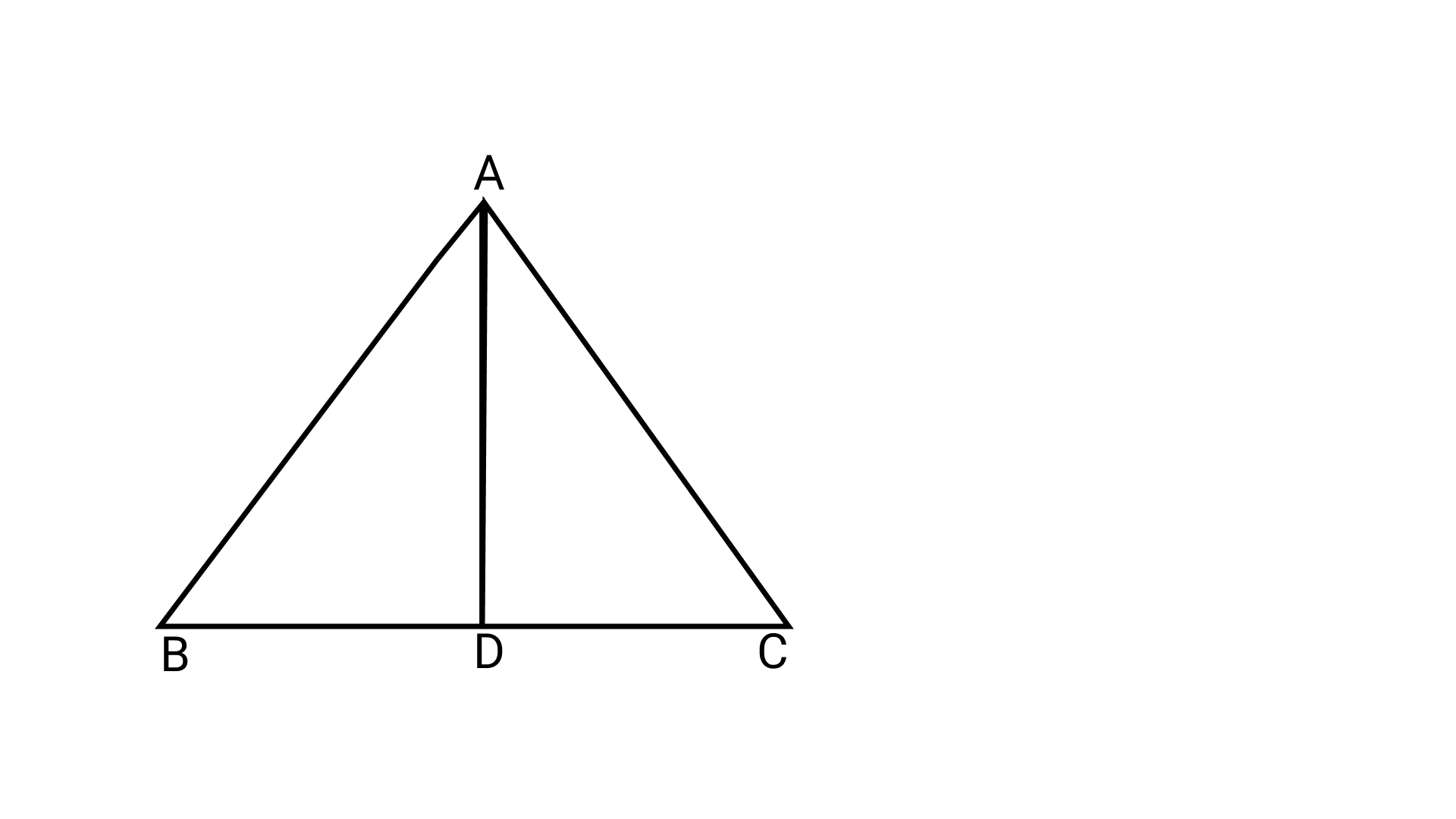
(a) State three pairs of equal parts in the triangle’s ABD and ACD.
Ans: In $\triangle$ABD and $\triangle$ACD,
AD = AD (common)
AB = AC (given)
BD = CD (D is mid-point of BC)
(b) Is AABD AACD. If so, why?
Ans: Yes, by using (a) part, it can be concluded that
$\triangle$ABD ≅ $\triangle$ACD (By SSS criterion)
145. In the given figure, it is given that LM = ON and NL = MO
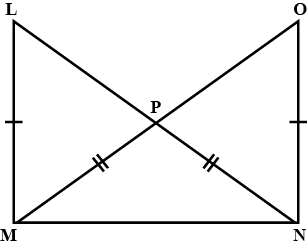
(a) State the three pairs of equal parts in the triangles NOM and MLN.
Ans: In $\triangle$NOM and $\triangle$MLN,
NM = MN (common)
OM = LN (given)
ON = LM (given)
(b) Is $\triangle$NOM ≅ $\triangle$MLN. Give a reason.
Ans: Yes, by using part (a),
So, $\triangle$NOM ≅ $\triangle$MLN (By SSS criterion)
146. Triangles DEF and LMN are both isosceles with DE = DF and LM = LN,
respectively. If DE = LM and EF = MN, then, are the two triangles congruent?
Which condition do you use? If $\angle$ E = $40^\circ$, what is the measure of $\angle$ N?
Ans:
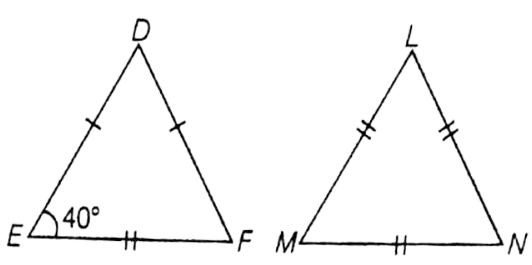
In $\triangle$DEF and $\triangle$LMN,
EF = MN (given)
DE = LM given
DF = LN (∵ DE = DF and LM = LN)
∴ $\triangle$DEF ≅ $\triangle$LMN (By SSS criterion)
$\Rightarrow$ $\angle$ E = $\angle$ M (By C.P.C.T.)
Now, $\angle$ E = $40^\circ$
$\Rightarrow$ $\angle$ M = $40^\circ$
Since, $\angle$ M = $\angle$ N (∵ LN = LM)
$\Rightarrow$ $\angle$ N = $40^\circ$
147. If APQR and ASOR are both isosceles triangle on a common base OR such
that P and S lie on the same side of QR. Are triangles PSQ and PSR congruent?
Which condition do you use?
Ans: Let $\triangle$PQR and $\triangle$SOR are the given triangles such that PQ = PR and SQ = SR.
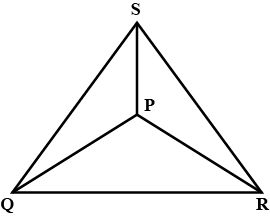
Now, in $\triangle$PSQ and $\triangle$PSR,
PQ = PR (given)
SQ = SR (given)
PS = PS (common)
So, $\triangle$PSQ ≅ $\triangle$PSR (By SSS criterion)
Yes, the $\triangle$PSQ and $\triangle$PSR are congruent by using SSS criterion.
148. In the given figure, which pairs of triangles are congruent by SAS
congruence criterion (condition)? if congruent, write the congruence of the two
triangles in symbolic form.
(i).
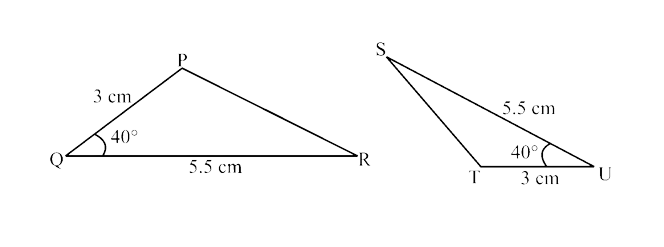
Ans: In $\triangle$POR and $\triangle$TUS,
PQ = TU = 3 cm (given)
OR = US = 5.5 cm (given)
$\angle$ POR = $\angle$ TUS = $40^\circ$ (given)
So, $\triangle$POR ≅ $\triangle$TUS (By SAS criterion)
(ii)
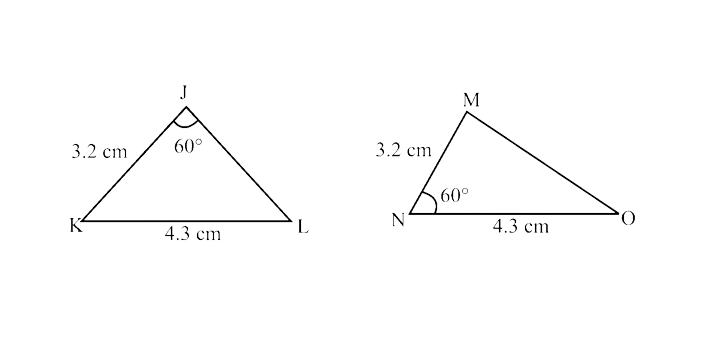
Ans: In the given figure, $\triangle$JKL and $\triangle$MNO are not congruent by any criterion.
(iii)
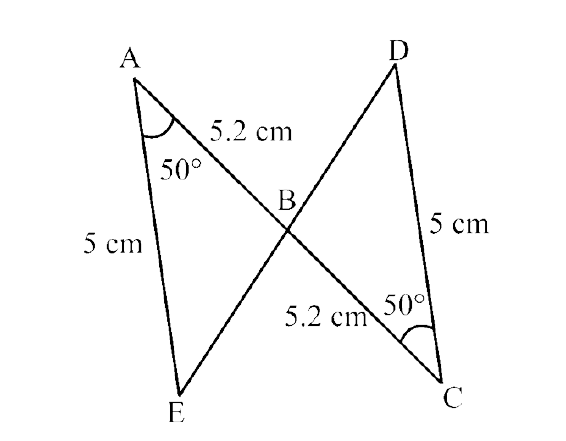
Ans: In $\triangle$ABE and $\triangle$CBD,
$\angle$ EAB = $\angle$ DCB = $50^\circ$ (given)
AE = CD = 5 cm (given)
AB = CB = 5.2 cm (given)
So, $\triangle$ABE ≅ $\triangle$CBD (By SAS criterion)
(iv)
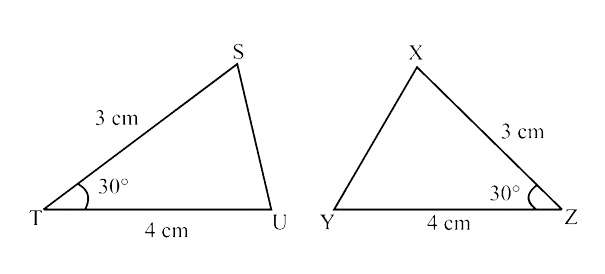
Ans: In $\triangle$SUT and $\triangle$XYZ
ST = XZ = 3 cm (given)
UT = YZ = 4 cm (given)
$\angle$ STU = $\angle$ XZY = $30^\circ$ (given)
So, $\triangle$SUT ≅ $\triangle$XYZ (by SAS criterion)
(v)
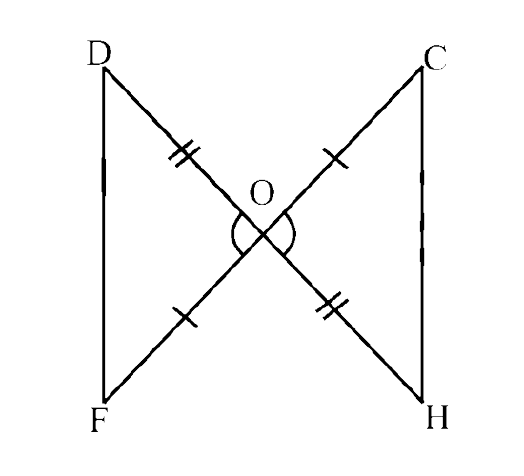
Ans: In $\triangle$DOF and $\triangle$HOC,
DO = HO (given)
FO = CO (given)
$\angle$ DOF = $\angle$ HOC (Vertically opposite angles)
So, $\triangle$DOF ≅ AHOC (By SAS criterion)
(vi)
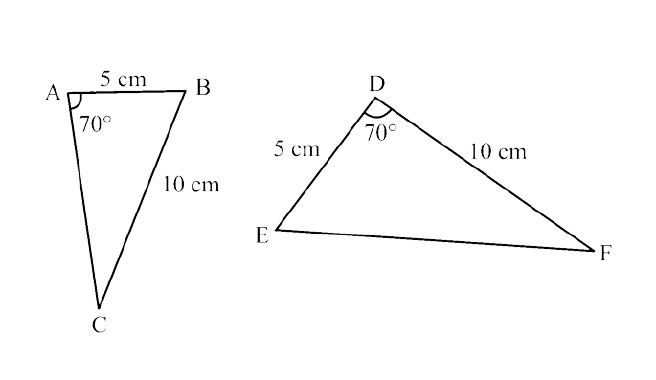
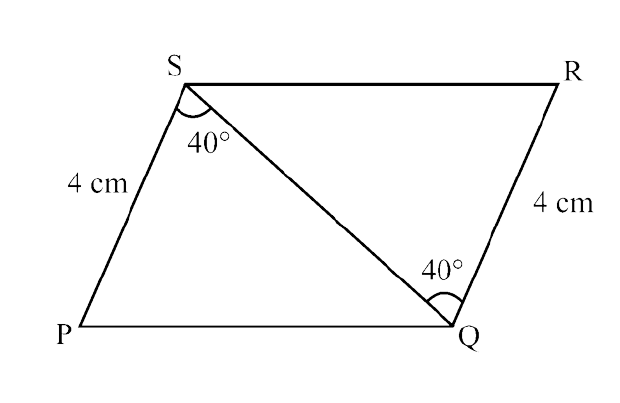
Ans: In $\triangle$PSQ and $\triangle$RQS.
SQ = QS (common)
PS = RQ = 4 cm (given)
$\angle$ PSQ = $\angle$ RQS = $40^\circ$ (given)
So, $\triangle$PSQ ≅ $\triangle$ROS (By SAS criterion)
(viii)
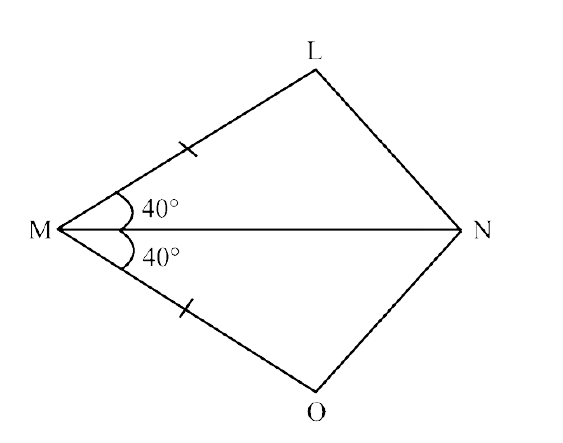
Ans: In $\triangle$LMN and $\triangle$OMN,
MN = MN (common)
LM = OM (given)
$\angle$ LMN = $\angle$ OMN = $40^\circ$ (given)
So, $\triangle$LMN ≅ $\triangle$OMN (By SAS criterion)
149. State which of the following pairs of triangles are congruent. If yes, write them in symbolic form (you may draw a rough figure).
(a) $\triangle$POR : PQ = 3.5 cm, OR = 4.0 cm, $\angle$ Q = $60^\circ$
$\triangle$ STU : ST = 3.5 cm, TU= 4 cm, $\angle$ T = $60^\circ$
Ans: In $\triangle$PQR and $\triangle$STU,
PQ = ST = 3.5 cm (given)
$\angle$ PQR = $\angle$ STU = $60^\circ$ (given)
OR = TU = 4 cm (given)
So, $\triangle$PQR ≅ $\triangle$STU (By SAS criterion)
(b) $\triangle$ABC : AB = 4.8 cm, $\angle$ A = $90^\circ$, AC = 6.8 cm
$\triangle$XYZ : YZ = 6.8 cm, $\angle$ X = $90^\circ$, ZX = 4.8 cm
Ans: Here, $\triangle$ABC and $\triangle$XYZ are not congruent by any criterion
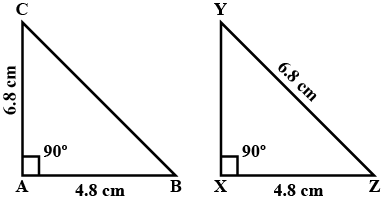
150. In the given figure, PO = PS and $\angle$ 1 = $\angle$ 2.
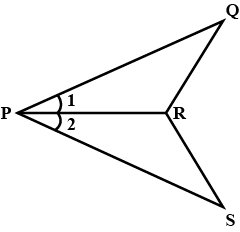
(i) Is $\triangle$PQR = $\triangle$PSR? Give reasons.
Ans: In $\triangle$PQR and $\triangle$PSR,
PQ = PS (given)
$\angle$ 1 = $\angle$ 2 (given)
PR = PR (common)
So, $\triangle$PQR ≅ $\triangle$PSR (By SAS criterion)
(ii) Is QR = SR? Give reasons.
Ans: Yes, QR = SR (By C.P.C.T.)
151. In the given figure, DE = IH, EG = FI and $\angle$ E = 21. Is $\triangle$DEF ≅ $\triangle$HIG? If yes, by which congruence criterion?
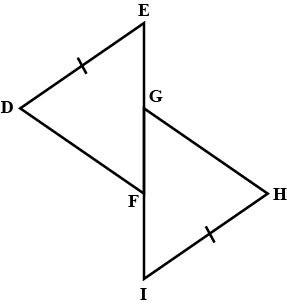
Ans: EG = IF (given)
So, EG + GF = IF + GF
$\Rightarrow$ EF = IG
In $\triangle$DEF and $\triangle$HIG,
DE = HI (given)
$\angle$ E = $\angle$ I (given)
EF = IG
So, $\triangle$DEF ≅ $\triangle$HIG (By SAS criterion)
152. In the given figure, $\angle$ 1 = $\angle$ 2 and $\angle$ 3 = $\angle$ 4.
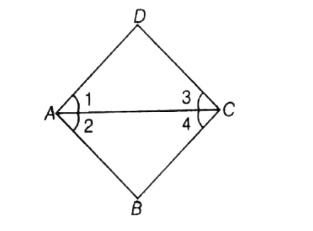
(i) Is $\triangle$ADC ≅ $\triangle$ABC? Why?
Ans: In $\triangle$ADC and $\triangle$ABC
$\angle$ 1 = $\angle$ 2 (given)
AC = AC (common)
$\angle$ 3 = $\angle$ 4 (given)
So, $\triangle$ADC ≅ $\triangle$ABC (By ASA criterion)
(ii) Show that AD = AB and CD = CB.
Ans: By using (i) part,
AD = AB (By C.P.C.T.)
And CD = CB (By C.P.C.T.)
153. Observe the given figure and state the three pairs of equal parts in triangles ABC and DBC.
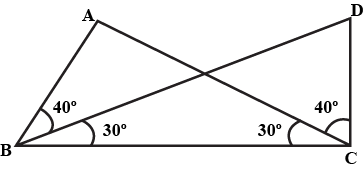
(i) Is $\triangle$ABC = $\triangle$DCB? Why?
Ans: In $\triangle$ABC and $\triangle$DCB,
$\angle$ ABC = $\angle$ DCB = $40^\circ$ + $30^\circ$ = $70^\circ$ (given)
$\angle$ ACB = $\angle$ DBC = $30^\circ$ (given)
BC = CB (common)
So, $\triangle$ABC ≅ $\triangle$DCB (By ASA criterion)
(ii) Is AB = DC? Why?
Ans: Yes, by using (i) part,
AB = DC (By C.P.C.T.)
(iii) Is AC = DB? Why?
Ans: Yes, by using (i) part,
AC = DB (By C.P.C.T.)
154. In the given figure, OS ⊥ PR, RT ⊥ PQ and QS = RT.
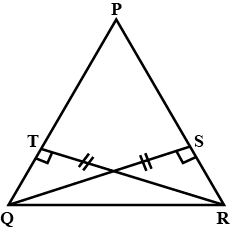
(i) Is $\triangle$QSR = $\triangle$RTQ? Give reasons.
Ans: In $\triangle$QSR and $\triangle$RTQ,
$\angle$ QSR = $\angle$ RTQ = $90^\circ$ (As QS ⊥ PR and RT ⊥ PQ (given))
QS = RT (given)
QR = RQ (common hypotenuse)
So, $\triangle$QSR ≅ $\triangle$RTQ (By RHS criterion)
(ii) Is $\angle$ PQR = $\angle$ PRQ? Give reasons.
Ans: Yes, by using (i) part,
$\angle$ TQR = $\angle$ SRQ (By C.P.C.T)
$\Rightarrow$ $\angle$ PQR = PRQ
155. Points A and B are on the opposite edges of a pond as shown in figure. To
find the distance between the two points, the surveyor makes a right-angled
triangle as shown. Find the distance AB.
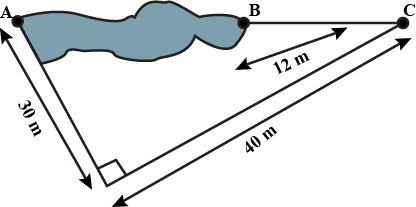
Ans: Since, $\triangle$ADC is right-angled triangle
$\therefore {\left( {AC} \right)^2}\; = {\text{ }}{\left( {AD} \right)^2}\; + {\text{ }}{\left( {CD} \right)^2} = {\text{ }}{\left( {30} \right)^2}\; + {\text{ }}{\left( {40} \right)^2}\; = {\text{ }}900{\text{ }} + {\text{ }}1600{\text{ }} = {\text{ }}2500{\text{ }} = {\text{ }}{\left( {50} \right)^2}$
$\therefore AC{\text{ }} = {\text{ }}50{\text{ m}}$
Now,
AB = AC – BC = 50 – 12 = 38
Therefore, the distance AB is 38 m.
156. Two poles of 10 m and 15 m stand upright on a plane ground. If the distance between the tops is 13 m, find the distance between their feet.
Ans: Let AB and CD are the given poles of heights 15 m and 10 m such that AC =
13 m.
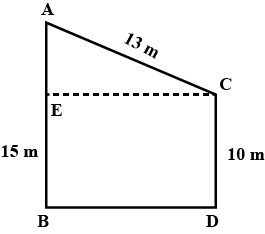
Now, BD $=\mathrm{CE}$ and $\mathrm{BE}=\mathrm{CD}=10 \mathrm{~m}$
$\therefore \mathrm{AE}=\mathrm{AB}-\mathrm{BE}=(15-10) \mathrm{m}=5 \mathrm{~m}$
Now, in $\triangle$AEC,
${\left( {AC} \right)^2}\; = {\text{ }}{\left( {AE} \right)^2}\; + {\text{ }}{\left( {EC} \right)^2}$
$\Rightarrow {\left( {13} \right)^2}\; = {\text{ }}{5^2}\; + {\text{ }}\left( {EC} \right){\;^2}$
$\Rightarrow {\left( {EC} \right)^2}\; = {\text{ }}169{\text{ }}-{\text{ }}25{\text{ }} = {\text{ }}144{\text{ }} = {\text{ }}{\left( {12} \right)^2}$
$\therefore EC{\text{ }} = {\text{ }}12{\text{ m}}$
Also, BD = 12 m
Thus, the distance between the feet of poles is 12 m.
157. The foot of a ladder is 6 m away from its wall and its top reaches a window
8 m above the ground,
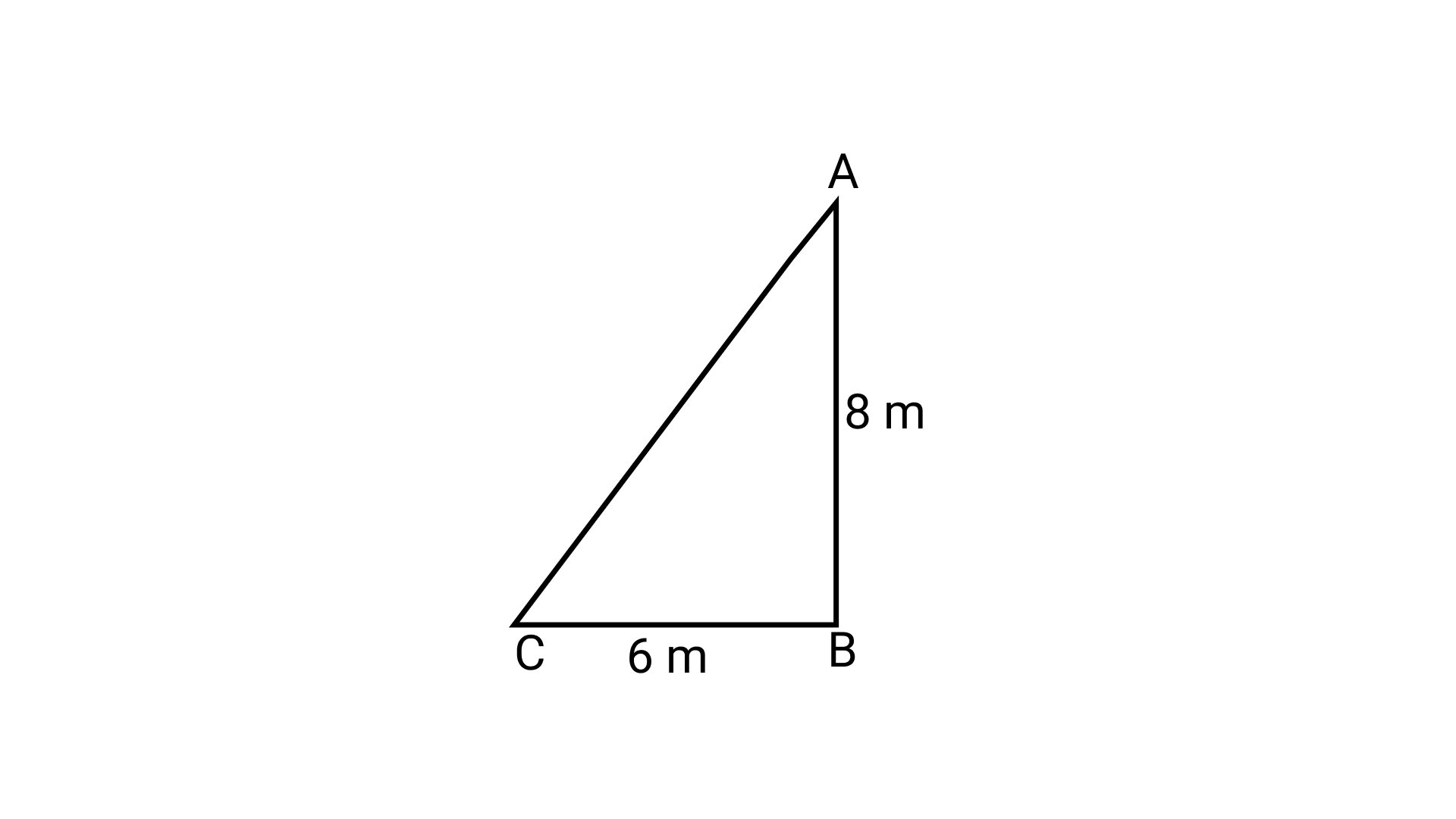
(a) Find the length of the ladder.
Ans: Let AC be the given ladder such that BC = 6 m and AB = 8 m
Now, in $\triangle \mathrm{ABC}$,
${\left( {AC} \right)^2}\; = {\text{ }}{\left( {AB} \right)^2}\; + {\text{ }}{\left( {BC} \right)^2} = {\text{ }}{8^2}\; + {\text{ }}{6^2} = {\text{ }}64{\text{ }} + {\text{ }}36{\text{ }} = {\text{ }}100{\text{ }} = {\text{ }}{\left( {10} \right)^2}$
$\therefore AC{\text{ }} = {\text{ }}10{\text{ m}}$
Thus, the length of the ladder is 10 m.
(b) If the ladder is shifted in such a way that its foot is 8 m away from the wall,
to what height does its top reach?
Ans: Let AC be the ladder of length 10 m and BC = 8 m.
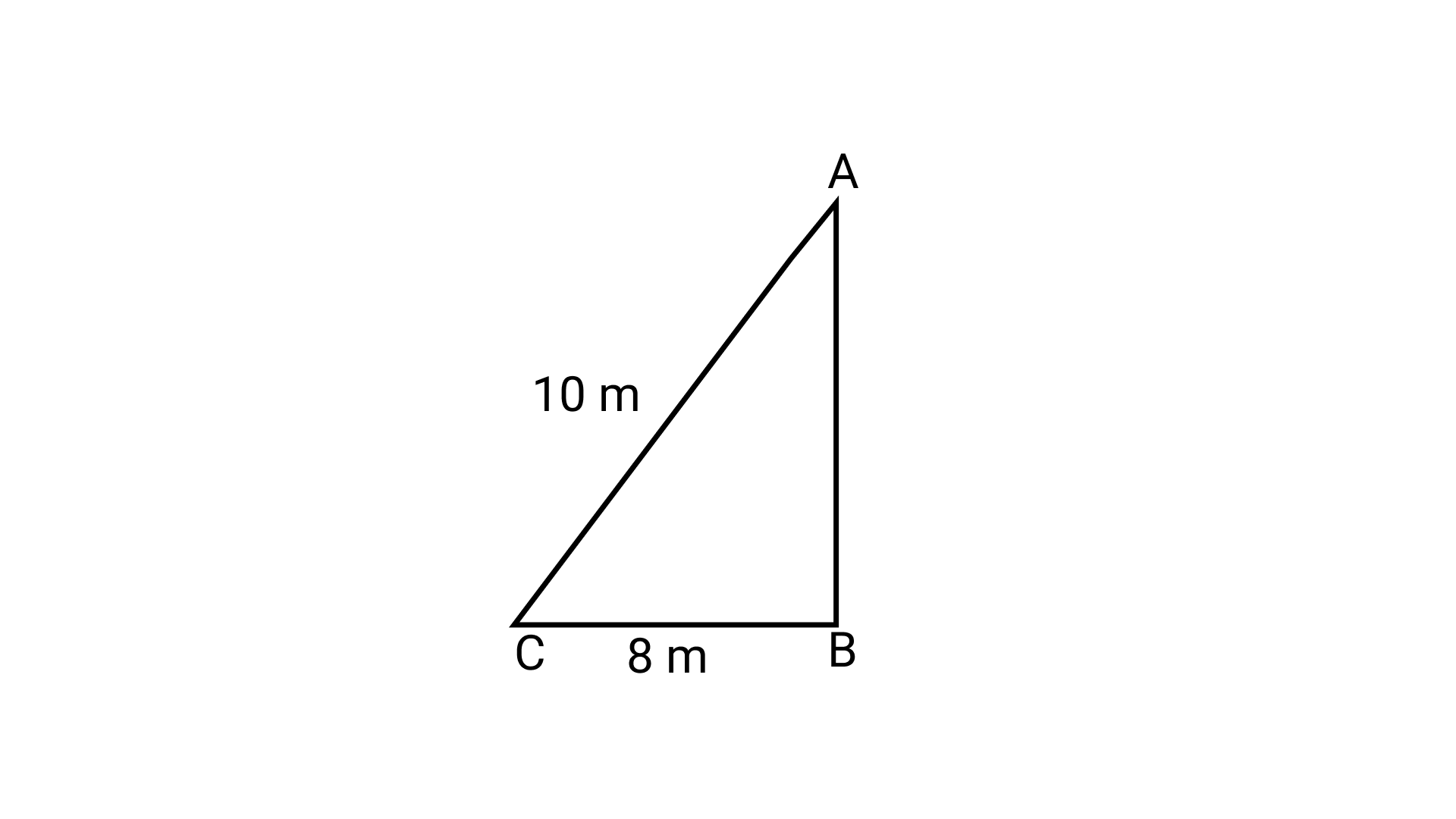
In $\triangle \mathrm{ABC}$,
${\left( {AC} \right)^2}\; = {\text{ }}{\left( {AB} \right)^2}\; + {\text{ }}{\left( {BC} \right)^2}$
$\Rightarrow {\left( {10} \right)^2}\; = {\text{ }}{\left( {AB} \right)^2}\; + {\text{ }}{\left( 8 \right)^2}$
$\Rightarrow {\left( {AB} \right)^2}\; = {\text{ }}100{\text{ }}-{\text{ }}64{\text{ }} = {\text{ }}36{\text{ }} = {\text{ }}{\left( 6 \right)^2}$
$\therefore AB{\text{ }} = {\text{ }}6{\text{ m}}$
Thus, the ladder top reaches 6 m above the ground.
158. In the given figure, state the three pairs of equal parts in $\triangle \mathrm{ABC}$ and $\Delta \mathbf{E O D}$.
Is $\triangle \mathrm{ABC}=\Delta \mathrm{EOD}$ ? Why?
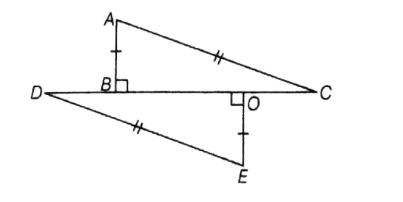
Ans: In $\triangle \mathrm{ABC}$ and $\Delta \mathrm{EOD}$,
$\mathrm{AB}=\mathrm{EO}$ (given)
$\angle \mathrm{ABC}=\angle \mathrm{EOD}=90^{\circ}$ (given)
$\mathrm{AC}=\mathrm{ED}$ (given hypotenuse)
So, $\triangle \mathrm{ABC} \cong \triangle \mathrm{EOD}$ (By RHS criterion)
Concepts Covered in Chapter 6
Medians of a Triangle
Altitudes of a Triangle
Exterior Angle of a Triangle and Its Property
Angle Sum Property of a Triangle
Two Special Triangles: Equilateral and Isosceles
Sum of the Lengths of Two Sides of A Triangle
Right-Angled Triangles and Pythagoras Property
FAQs on NCERT Exemplar for Class 7 Maths Solutions Chapter 6 Triangles
1. Does use NCERT Exemplar Solutions for Class 7 helps score higher in the exam?
The NCERT Solutions for Class 7 Maths should be practiced to acquire more marks in the test. Students should go over every topic properly before taking the exam. To score higher marks on the yearly test, it is necessary to follow a structured preparation approach. The solutions contain the answers to all of the exercise-wise questions that appear in the NCERT textbook and additional information. The sample papers released by the board are based on the actual exam pattern and marking scheme, which allows students to gain a brief understanding of the marking scheme, which aids them in their preparation for the exam and helps them identify the topics that carry more weightage and on which they should concentrate to achieve good marks. Students' problem-solving abilities are improved as a result of regularly completing textbook questions utilizing these solutions, which is essential for them to be able to face the exam without fear.
2. What is the correct way to practice with NCERT Exemplar Solution?
Whenever possible, attempt to solve a sample paper in a simulated test setting. Set a timer and time yourself to ensure that you can answer all of the questions within the allotted time.
While solving the paper, avoid looking at the answers. Each question should be attempted first. Once you've completed the exam on your own, review the solutions.
Always check the marks associated with the question before replying. Spend minimal time on short questions by omitting superfluous points.
If the question requires you to create a table or graphic, create one and practice. Occasionally, students fail to do so and hence are unable to perform properly on the day of the exam.
After completing the test, review the answers and solutions and do your analysis. Determine your strengths and shortcomings.
Study the areas where you believe you lack and then tackle the next example paper.
3. In what ways do the NCERT Exemplar Solution help students?
For Practice: The sample papers are primarily used to allow students to practice for the exam. Students can utilize these example papers to hone their speed and accuracy in preparation for the next examination.
Strong and Weak Area Analysis: Using the example papers, students may determine which chapters require more polishing and which require less.
Teaches Time Management: In reality, sample papers are a practice test for students. So, while doing the sample papers, students may learn about time management and finishing the test in the allocated time.
Examining the marking structure: The sample papers allow students to explore the exam's grading structure and how much weight each chapter has.
Enhance Confidence: Students will get the confidence necessary to take the examination fearlessly by completing the practice papers.
4. What method should be used to prepare for the Class 7 Maths exam?
Practicing sample papers is one of the most effective methods of preparing for a Mathematics test. It is beneficial to review your preparation and identify flaws to avoid repeating them.
Practicing also helps you improve your speed and develop an efficient time management strategy for exams—time spent on each question helps with time management.
Writing down all of the calculations and complex concepts might aid with their retention. It's a good idea to look through them while practicing. Additionally, writing improves learnability by reinforcing topics.
To do well in tests, the student must understand all ideas. Encourage students to ask school or tuition teachers for help understanding ideas. Vedantu offers expert-led online Math programs for students to learn Math and solve challenging problems.
Math shortcuts save time during tests. It helps me remember concepts and formulae. Make some flashcards or use sticky notes to review these strategies before tests. Sticky notes can also be used to memorize formulas and solutions.
5. From where can I download NCERT Exemplar for Class 7 Maths?
Vedantu has the NCERT Solutions for Class 7 Maths, which you may access here. The solutions offered on this page are in PDF format, which means that they may be easily downloaded and accessed by students. Designed by qualified academic faculties with extensive understanding of their respective fields, both the chapter-specific and exercise-specific solutions are available. Students may quickly and easily solve textbook issues by referring to these solutions and answering all of their questions. It is important to use the solutions regularly to develop logical reasoning and an analytical approach to hard issues.

















